Exploring the Historic City Centre of Naples


Practical Tips for Your Naples Visit:
Transportation: Naples offers a convenient and efficient public transportation system, making it easy to get around the city. The Metro system connects the city centre with its suburbs, while the Circumvesuviana railway provides access to Mount Vesuvius and the Amalfi Coast. Buses and taxis are also readily available.
Accommodation: Naples offers a wide range of accommodation options, from luxurious hotels to charming bed and breakfasts and budget-friendly hostels.
Best Time to Visit: Naples enjoys a Mediterranean climate with mild winters and warm summers. The best time to visit is during spring (April-May) and autumn (September-October), when the weather is pleasant and crowds are smaller.

Itinerary Planning: Naples offers a wealth of attractions and activities to suit every interest. Popular attractions include the National Archaeological Museum , the Royal Palace , the San Gennaro Museum , and the city's many piazzas and churches.
Cultural Experiences: Immerse yourself in Naples' vibrant cultural scene by attending a performance at the Teatro di San Carlo, exploring the city's many museums, or experiencing the lively atmosphere of local festivals such as the Festa di San Gennaro and the Carnival of Naples.
Outdoor Activities: Naples offers plenty of opportunities for outdoor enthusiasts. Hike to the top of Mount Vesuvius for stunning views of the Bay of Naples, explore the island of Capri by boat, or relax on one of the many beaches along the Amalfi Coast.
Budgeting: Naples is a relatively affordable city to visit, especially compared to other major European destinations. Accommodation, transportation, and food are all relatively inexpensive, and there are many free or low-cost attractions to enjoy.
Safety: Naples has a reputation for crime, but it is generally safe for tourists to visit. Take the usual precautions, such as avoiding carrying large amounts of cash or valuables, and be aware of your surroundings, especially in crowded areas.

Unveiling the Historic City Centre of Naples
Naples, a city rich in history and culture, Its winding streets are adorned with centuries-old architecture, while its colourful piazzas show the real energy of Neapolitan life.
From ancient ruins to majestic piazzas, Naples unveils a huge range of experiences that will keep you busy exploring.
Naples Ancient Roots:
Naples is a city with a history that spans many years and has been shaped by a succession of powerful civilisations. From its ancient Greek origins to its Roman heyday and its role as a maritime power in the Middle Ages, Naples has witnessed the rise and fall of invaders which you can see in its rich architectural heritage and enduring cultural traditions.
A Greek Legacy:
Naples, known as Neapolis (New City) to the Romans, traces its roots to the 9th century BC when Greek colonists from Cumae established a settlement on the southern slopes of Mount Vesuvius.
Named Parthenope, after the nymph of Greek mythology, the city quickly flourished, its strategic location on the trade routes between Greece and the Mediterranean.
Under Greek rule, Parthenope underwent significant development, with the construction of temples, public baths, and an amphitheatre. The influence of Greek art and architecture can be seen in the ruins of Neapolis, particularly in the theatre of San Lorenzo.
Roman Transformation:
In the 3rd century BC, Naples was conquered by the Romans, marking a significant turning point in its history. The Romans recognized the city's strategic importance and made it into a major port.
Under Roman rule, Neapolis witnessed an era of expansion and development, with the construction of aqueducts, roads, and public buildings.
The Roman influence on Naples is evident in the city's architectural heritage, with iconic landmarks like the Castel Nuovo , the Naples Cathedral , and the catacombs of San Gaudioso .
The city's amphitheatre, now known as the Teatro San Carlo , also shows the imprint of fantastic Roman engineering.

A Maritime Power:
As the Roman Empire declined, Naples emerged as a significant maritime power in the Middle Ages. The city's strategic position on the trade routes between Europe and the East made it a hub for commerce and cultural exchange.
During this period, Naples played a vital role in the development of maritime trade and the transportation of goods across the Mediterranean.
The Chiesa di San Domenico Maggiore , with its intricate Gothic façade, and the Castel dell'Ovo , a medieval fortress perched on an islet in the harbour, stand as landmarks to the city's medieval history.
Piazzas: The Lifeblood of Naples
Naples' historic centre is dotted with captivating piazzas, each with its unique character and significance. These fabulous squares serve as social hubs, gathering places for locals and visitors to come to relax and socialize.
Piazza del Plebiscito:
Piazza del Plebiscito, Naples' largest piazza, is a breathtaking spectacle of Baroque architecture. The Royal Palace , with its twin bell towers, dominates the square, where you can see the ornate fountain of Neptune.

Piazza Dante:
Piazza Dante, named after the renowned Italian poet Dante Alighieri, the statue of Dante stands proudly at the centre of the square, while the surrounding buildings house literary institutions and cultural landmarks.
Piazza Bellini:
Piazza Bellini, named after the celebrated composer Nicola Antonio Bellini, is a very vibrant square. It is home to the Conservatorio di San Pietro a Majella, one of the world's oldest and most prestigious music conservatories.
Roman Ruins and Medieval Fortifications:
Scattered throughout Naples' historic centre are remnants of ancient civilizations. The Teatro di San Carlo , once an amphitheatre and now a renowned opera house, is a must-visit place if you are in Naples.
The Castel dell'Ovo offers stunning views of the city. Its network of tunnels tells of Naples' strategic importance and its role as a defensive stronghold.

Royal Palaces and Majestic Churches :
The Royal Palace , with its grand façade and ornate interiors, is a prime example of Baroque splendour.
The Naples Cathedral , a Baroque masterpiece, is adorned with intricate sculptures and mosaics. Its dome dominates the skyline and serves as a beacon of Neapolitan identity.
Elegant Villas and Majestic Piazzas :
The Renaissance era left its mark on Naples' architecture, with the construction of elegant villas and grand piazzas. The Villa Pignatelli, with its neoclassical façade and lush gardens, is a testament to this.
Piazza del Plebiscito, a masterpiece of Baroque architecture, is flanked by the Royal Palace and the Basilica of San Francesco di Paola.
Contemporary Structures and Art Deco :
Naples' architectural landscape continues to evolve, with modern structures and Art Deco gems adding their unique character to the city's skyline. The Maschio Angioino, a medieval fortress transformed into a contemporary museum, showcases the blending of old and new.
The Galleria Umberto I, a glass-roofed arcade inspired by the Galleria Vittorio Emanuele II in Milan, showcases the city's embrace of modern architecture. Its Art Deco interiors and intricate details reflect the city's vibrant cultural heritage.
Naples Architectural Styles:
Naples' architectural heritage is a dynamic and evolving landscape from ancient ruins to modern masterpieces. Each style, and each era, has left its mark on the city's skyline.
A City Steeped in Artistic Heritage:
Naples has long been a haven for artistic expression, attracting renowned artists across Italy and beyond. From the Baroque masterpieces of Caravaggio to the contemporary works of Lucio Fontana, Naples' artistic heritage is a rich tapestry of styles and movements.
The Legacy of Caravaggio:
Michelangelo Merisi da Caravaggio, the renowned Baroque artist, left an indelible mark on Naples' artistic landscape. His dramatic and intensely realistic paintings, such as "The Seven Works of Mercy" and "The Martyrdom of Saint Matthew," continue to captivate visitors today.

Naples' Creative Spirit :
Naples' artistic spirit continues to thrive in the contemporary era, with a vibrant community of artists, musicians, and performers. From street art to contemporary art installations, Naples' streets and galleries showcase the city's creative energy.
Treasure Trove of Art :
Naples boasts a wealth of art institutions dedicated to preserving and showcasing its artistic heritage. The San Gennaro Museum houses a collection of Neapolitan Baroque art, while the National Archaeological Museum holds a vast collection of Greek and Roman artefacts.
A Cultural Melting Pot:
Naples' artistic scene is a dynamic fusion of traditional and contemporary influences. The city's annual festivals, such as the San Gennaro Festival, blend religious traditions with vibrant street performances and music, showcasing the city's unique cultural tapestry.
Naples: A Canvas for Artistic Creation
Naples' streets, buildings, and piazzas serve as a continuous canvas for artistic expression. Graffiti artists adorn walls with bold murals, street performers captivate passersby with their musical talents, and impromptu art installations surprise and delight visitors.
Conclusion: A City Brimming with Art
Naples' artistic legacy is deeply interwoven into the city's fabric. From the masterpieces of Caravaggio to the vibrant street art of today, Naples is a city where art is not confined to museums and galleries, but rather spills out onto the streets, breathing life and energy into the urban landscape. As you explore Naples' historic centre, immerse yourself in the city's artistic spirit, and discover the creative heart that beats at the very core of this vibrant city.

Culinary Delights: A Taste of Naples
Pizza: Where It Was Born
Naples is the birthplace of pizza, and its culinary heritage is deeply rooted in the traditions of wood-fired ovens and fresh, locally sourced ingredients. The Margherita pizza, with its simple yet perfect combination of tomato sauce, mozzarella cheese, and fresh basil, is a true Neapolitan masterpiece.
Spaghetti Alla Chitarra:
Spaghetti alla chitarra, a speciality of Naples, is a dish that showcases the city's mastery of pasta and seafood. The short, ridged noodles are tossed with a medley of fresh seafood, creating a symphony of flavours and textures.
Frittatina di Maccheroni:
Frittatina di maccheroni is a hearty and comforting dish reflecting Neapolitan love for pasta and cheese. The omelette is filled with cooked macaroni, mozzarella cheese, and a touch of béchamel sauce, creating a satisfying and traditional Neapolitan meal.
Local Trattorias:
To truly experience the authentic flavours of Naples, venture beyond the tourist hotspots and immerse yourself in the local trattorias. These unassuming eateries, often family-run, are the keepers of traditional Neapolitan cuisine, serving up dishes that have been passed down through generations.

A Celebration of Food and Tradition:
No visit to Naples would be complete without experiencing the Festa di San Gennaro, a vibrant festival in honour of the city's patron saint. The festival culminates in the miracle of the liquefaction of San Gennaro's blood, a centuries-old tradition that fills the streets with awe and excitement.
People and Hospitality :
Naples is known for its warm and welcoming people, whose passion for life and love for their city are infectious. The locals are known for their hospitality, often inviting strangers into their homes for a traditional coffee or a glass of wine.
The Importance of Family:
Family is at the core of life in this city and Italy in general, providing a strong sense of identity and support. Locals often gather for large family meals and share stories over traditional dishes.
Music, Festivals, and Traditions:
Naples is a city full of music, from traditional melodies to lively folk music. The city's vibrant festivals, such as the Carnival of Naples and the Festa di San Gennaro, showcase the city's rich cultural traditions.
The Naples Language:
The Neapolitan language, a dialect of Italian, is a unique and expressive language that reflects the city's rich history and culture. It has a lively and distinctive pronunciation.
As you immerse yourself in Naples' historic centre, you'll encounter the warmth, passion, and hospitality that define the Neapolitan spirit. Engage in conversations with locals, sample traditional dishes, and experience the energy of the city's festivals. You'll discover a place where life is celebrated, traditions are cherished, and the spirit of Naples resonates in every corner.
Additional Resources:
- Visit Naples: https://www.visitnaples.eu/en
- Naples Tourism Board: https://www.comune.napoli.it/flex/cm/pages/ServeBLOB.php/L/IT/IDPagina/5802
More Stories

Where to Stay in Venice Italy
Venice is one city in all of Italy that most people wish to visit at least once, but it can be expensive unless you know what to look for and where to stay in Venice.

Mercato Centrale in Florence
While the city of Florence has many fantastic historical buildings to visit it also has an amazing market, Mercato Centrale with vendors selling wine, fish, meat fruit, cheese, oil and spices on the ground level, which is frequented by locals as much as tourists.
Take advantage of the search to browse through the World Heritage Centre information.
Share on social media
Unesco social media, historic centre of naples.
- Description
From the Neapolis founded by Greek settlers in 470 B.C. to the city of today, Naples has retained the imprint of the successive cultures that emerged in Europe and the Mediterranean basin. This makes it a unique site, with a wealth of outstanding monuments such as the Church of Santa Chiara and the Castel Nuovo.
Description is available under license CC-BY-SA IGO 3.0
Centre historique de Naples
De la Neapolis fondée par des colons grecs en 470 av. J.-C. à la ville d'aujourd'hui, Naples a su conserver l'empreinte des cultures apparues tour à tour dans le bassin méditerranéen et en Europe. Cela en fait un site unique aux remarquables monuments tels que l'église Santa Chiara ou le Castel Nuovo, pour n'en nommer que deux.
الوسط التاريخي لنابولي
من "نيابوليس" التي أسسها مستوطِنون يونانيون في العام 470 ق.م. إلى المدينة كما هي اليوم، تمكنت نابولي من المحافظة على أثر الثقافات التي ظهرت الواحدة تلو الأخرى في الحوض المتوسطي وفي أوروبا. ما يجعل منها موقعًا فريدًا بنصبه المذهلة مثل كنيسة القديسة كلارا أو الكاستِل نووفو وغيرهما الكثير.
source: UNESCO/CPE Description is available under license CC-BY-SA IGO 3.0
那不勒斯是公元前470年由希腊移民创建的,从那时至今,它接纳和保留了不断出现在地中海盆地和欧洲的文化印记。这使得那不勒斯成为一个独特的城市。它拥有一系列出色的建筑,如桑塔基亚拉教堂及诺沃城堡。
Centro histórico de Nápoles
Nápoles ha conservado la impronta de las sucesivas culturas de la cuenca del Mediterráneo y de Europa, desde la época de la colonia griega de Neápolis, fundada al año 470 a.C., hasta los tiempos modernos. De ahí que su centro histórico sea un sitio excepcional dotado de notables monumentos como la iglesia de Santa Clara o el Castel Nuovo, entre otros muchos más.
source: NFUAJ
Historisch centrum van Napels
Vanaf de stichting als Neapolis door de Grieken in 470 voor Christus tot aan vandaag de dag, heeft Napels het stempel behouden van de opeenvolgende culturen die ontstonden in Europa en het Middellandse Zeegebied. Dit maakt het een unieke plek met een schat aan opmerkelijke monumenten, zoals de kerk van Santa Chiara en het Castel Nuovo. Napels is één van de oudste steden in Europa, waarvan de hedendaagse stedelijke structuur de elementen heeft behouden van haar lange en bewogen geschiedenis. Het stratenpatroon, de schat aan historische gebouwen en de situering aan de baai van Napels maken de stad van uitzonderlijke waarde zonder weerga.
Source: unesco.nl
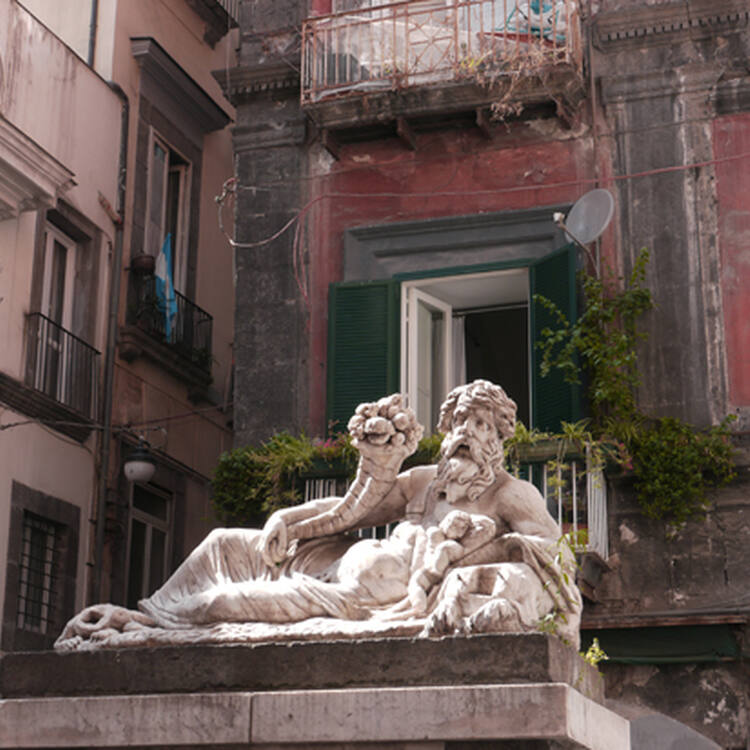
Outstanding Universal Value
Brief synthesis
Located in southern Italy, Naples is a major port city in the centre of the ancient Mediterranean region. Its origins go back to its foundation as Parthenope or Palaepolis in the 9th century B.C., subsequently re-established as Neapolis (New City) in 470 B.C. It is therefore one of the most ancient cities in Europe, whose current urban fabric preserves a selection of outstanding elements of its long and eventful history, as expressed in its street pattern, its wealth of historic buildings and parks, the continuation of many of its urban and social functions, its wonderful setting on the Bay of Naples and the continuity of its historical stratification.
Naples was among the foremost cities of Magna Graecia , playing a key role in the transmission of Greek culture to Roman society. It eventually became a major cultural centre in the Roman Republic, civitas foederata . Sections of the Greek town walls excavated since World War II and the excavated remains of a Roman theatre, cemeteries and catacombs testify to this history. In the 6th century A.D., Naples was conquered by the Byzantine Empire, becoming an autonomous Duchy, later associated with the Normans, Swabians, and the Sicilian reign. Evidence of this period includes the churches of San Gennaro extra moenia , San Giorgio Maggiore, and San Giovanni Maggiore with surviving elements of 4th and 5th century architecture, the chapel of Santa Restituta in the 14th-century cathedral, and the Castel dell'Ovo, one of the most substantial survivals from the Norman period, although subsequently remodelled on several occasions.
With the Angevin dynasty (1265-1442), Naples became the living symbol of the prestige, dignity, and power of the dynasty. The city expanded to include suburbs and neighbouring villages. The Angevin also initiated an influential relationship with Western art and architecture, particularly French Gothic, integrated with the earlier Greek and Arab elements. The convents of Santa Chiara and San Lorenzo Maggiore and the churches of Donna Regina and I’lncoronata, San Lorenzo Maggiore, San Domenico Maggiore and the new Cathedral date from this period.
From the 15th to 17th centuries, Naples was governed by the Aragonese, who remodelled the defences and street pattern, and constructed the Castel Nuovo largely in the Tuscan style as one of the foremost centres of their empire. The period of Spanish rule is marked by the Royal Palace built in 1600 along one side of the imposing Piazza del Plebiscito, the Monte dei Poveri Vergognosi charitable institution, the convent of Sant'Agostino degli Scalzi, and the Jesuit College on Capodimonte.
From 1734, under the government of the Bourbons, Naples emerged, together with Paris and London, as one of the major capital cities of Europe. The architectural heritage of Naples from this period was widely influential, and is expressed particularly in the interior design of the royal palaces and associated noble residences that were part of the territorial system extending far beyond the city itself. Important palaces of the 18th century include the large palace Albergo dei Poveri, the National Archaeological Museum, the Certosa of Suor Orsola Benincasa on the hill of San Martino, and the Villa Pignatelli.
The component parts of the serial property are: the Historical Centre of Naples; the District of Villa Manzo, Santa Maria della Consolazione; Marechiaro ; the District of Casale ; the District of Santo Strato and the Villa Emma .
Criterion (ii): The city’s setting on the Bay of Naples gives it an Outstanding Universal Value which has had a profound influence in many parts of Europe and beyond. Naples has exerted great influence on the rest of Europe ever since the antiquity, as a major centre in Magna Graecia and of the Roman Republic. Its role as one of the most influential cultural centres in the Mediterranean region was reconfirmed in the Middle Ages and again from the 16th to 18th centuries, being one of the major European capitals, and exerting important influences in many cultural fields, especially related to art and architecture.
Criterion (iv): Naples is one of the most ancient cities in Europe, whose contemporary urban fabric preserves the elements of its long and eventful history. The rectangular grid layout of the ancient Greek foundation of Neapolis is still discernible and has indeed continued to provide the basic form for the present-day urban fabric of the Historic Centre of Naples, one of the foremost Mediterranean port cities. From the Middle Ages to the 18th century, Naples was a focal point in terms of art and architecture, expressed in its ancient forts, the royal ensembles such as the Royal Palace of 1600, and the palaces and churches sponsored by the noble families.
The World Heritage property of the Historic Centre of Naples includes all the essential elements that contribute to the justification of its Outstanding Universal Value. These comprise the historic centre as defined by the Aragonese walls, as well as significant elements from the 18th century, including important palaces, as well as buildings for governmental, residential, university, health and sanitary, and arts and crafts functions. These buildings and functions represent all the relevant periods of the history of Naples, and are in a fair state of conservation. The important historical relationship of the city to the sea is maintained through the preservation of archaeological remains of the Roman period along the sea coast and the rehabilitation of the small boat harbours found from Castel Nuovo to Capo Posillipo.
A minor boundary modification was approved by the World Heritage Committee in 2011. This enlarged the component “Historic Centre of Naples” and merged and enlarged the components “District of Casale” and “District of Santo Strato”, in order to include a non-developed and protected archaeological area. The property is vulnerable to lack of maintenance of the non-monumental urban fabric. The setting of the property is intact and not threatened by development.
Authenticity
The town plan has a high level of authenticity, and has retained considerable evidence of the Greco-Roman city and the checkerboard layout of the 16th-century “Spanish quarters”. The typology of the public and private buildings has been well retained as part of the current city plan, as well as in their spatial, volumetric, and decorative features. There is remarkable continuity in the use of materials, all derived locally, and distinctive visual and material features, such as the basic yellow tufa, white marble, and the grey piperno . The techniques developed for the use of these materials survive to a considerable degree and are used in restoration and conservation projects.
Protection and management requirements
The 1972 General Town Plan (Ministerial Decree No 1829, 31 March 1972) identifies the protected area of the historic centre, where all interventions must be approved by the appropriate Soprintendenza . The Master Plan confirmed the requirements of the previous plan by expanding the scope of the defined town centre. The provisions of Act No. 47 of 28 February 1985 on “Norms Pertaining to Town Planning and Building Control Activity, Sanctions, Recovery, and Redevelopment of Abusive Works” are applicable to the area, and lay down specifications for building heights and spacing. A large number of buildings in the city are designated under the terms of Act No. 1089 of 1 June 1939, the central piece of Italian legislation relating to heritage protection. These rules were later merged in the code of the cultural heritage and landscape of the D.Lgs n.42/2004.
This means that for these buildings there is a safeguard measure which ensures any activity on the site must be authorized by the relevant Soprintendenza (peripheral office of the Ministry for Cultural Heritage and Activities), which can deny it for conservation reasons, authorize intervention including limitations, authorizing only interventions which do not harm the resource in question.
Other national and regional statutes and regulations relating to planning control and heritage are also applicable to the Historic Centre of Naples. The responsible national agencies are the Ministry for the Environmental and Cultural Heritage, the Campania Regional Council, the Provincial Council of Naples, and the Municipal Council of Naples. The management of the World Heritage property is undertaken by an office of the municipality that was created for the valorisation of the Historic Centre of Naples. This office is responsible for a management plan for the World Heritage property which guides its safeguarding and protection while at the same time ensuring that Naples remains a living and vibrant city. The plan will be regularly monitored to ensure its effectiveness and is updated every 6 to 10 years. The vision of the Management Plan is to safeguard the cultural heritage and to conserve the stratified urban fabric, to support traditional socio-economic interrelations and cultural production, as well as the quality of life, to maintain the mixed uses, to increase security and hygiene, and to raise awareness and understanding of heritage resources. The scope is also to integrate the property within the broader territorial system around the Bay of Naples, Capri, Sorrento, Herculaneum and Pompeii, in the context of cultural tourism for the area.
- Benecon.it Selected publications
- City of Naples

State of Conservation (SOC)
Protections by other conservation instruments.
1 protection / 1 element
- Art of Neapolitan ‘Pizzaiuolo’
Read more about synergies
How to spend a day in historic Naples
The historic centre of Naples is a World Heritage Site and you’ll see why if you can avoid the chaos and find the grandeur.
Written by Michael Turtle
Michael Turtle is the founder of Time Travel Turtle. A journalist for more than 20 years, he's been travelling the world since 2011.
Michael Turtle is the founder of Time Travel Turtle and has been travelling full time for a decade.
Updated: October 6, 2023
The Historic Centre of Naples in Italy
It's in the old town of Naples that you get the best sense of this beautiful - but chaotic - city, with palatial buildings and torrid streets.
Visiting Naples also means visiting the Historic Centre of Naples and it's easy to spend a day walking through the Naples historic district to discover the main sights.
- A brief introduction with the important facts about the history of Naples
- A map of the Historic Centre of Naples, with the highlights marked
- Some info about the most important things to see in the Historic Centre of Naples
- Tips of the best guided tours of historic Naples that you can join
In some ways, you need to put modern day Naples aside. The trash, the chaos, the petty crime, even the mafia – yes, it is a large part of what this Italian city is today. But it really doesn’t do Naples the justice it deserves.
I’ve written previously about this balance between good and bad and what Naples is really like . I would recommend having a read of it at some point.
The bad elements… well, they’re all a product of the Naples of today. And the good… well, most of them are from the history of Naples.
The history of Naples
It’s always been a wealthy and influential city. Even as empires rose and fell, Naples always seemed to have an important place for each wave of rulers.
Even as far back as 470 BC, when Greek settlers founded Neapolis (meaning ‘New City’ and then becoming ‘Naples’), it was one of the foremost cities in Magna Graecia and played a key role in the development of the Ancient Roman culture, based on Greek traditions.
In the more than two millennia between then and now, Naples was also important to the Roman Empire, the Byzantine Empire, and then the Normans, Swabians, and the Sicilian reign.
Between the 13 th and 15 th centuries, Naples was the most important city for the Angevin dynasty, which expanded its suburbs and built grand churches.
The Aragonese then controlled the city for the next couple of centuries and placed an emphasis on imposing castles and opulent palaces.
Then, from 1734, the Bourbon Kings embarked on probably the most ambitious architectural projects in Naples. The city became one of the major capital cities of Europe, full of incredible buildings, squares and boulevards.
Most of them are still here today, mixed in with the legacies of all the previous empires. Together, they create the infrastructure of magnificence that is the Historic Centre of Naples.
One day in the Historic Centre
With centuries upon centuries of history in the centre of Naples, it’s impossible to see everything in a day… or probably even a week.
Just walking the streets, you’ll find yourself surrounded by incredible buildings that appear to have no special status, that aren’t tourist sites, that don’t even look like they’re regularly maintained.
Walk aimlessly and you’ll probably actually see enough to give you a good impression of how impressive the architecture and history of Naples is.
But, to really get to see the best of Naples and to understand it properly, I would recommend a tour of the Historic Centre of Naples. There is this excellent private tour , if you are in a group. Or I would recommend this short tour to get a quick overall impression.
There are some other good options here too:
However, I know you might prefer to see things on your own. So, I’ve put together a suggested itinerary for one day in Naples, focusing on the historic centre.
It certainly won’t take you to everything (that’s impossible) but it will lead you to a bunch of the highlights.
A map of the Naples Historic Centre
My suggested route is in the Naples itinerary map below and I’ve also marked many of the important sights along the way. In the rest of this story, below the map, I have some brief information about what you’ll see along the way.
If you’re using your smartphone, just click on the icon in the top right of the map to open it in your Google Maps app and all of the markers will load up. Then, as you walk around, you can trace your route and see whether you’re close to something significant.
Things to see in the Historic Centre of Naples
If you choose not to take a guided tour, you’ll still be able to learn a bit about the most important attractions in Naples with this info I’ve put together.
Piazza del Plebiscito
Basilica san francesco da paola, royal palace, castel nuovo, galleria umberto i.
- Castel Sant’Elmo
Santa Maria de Sette Dolori
Church of gesù nuovo, santa chiara, piazza dante, piazza vincenzo bellini, san domenico maggiore, naples cathedral, national archaeological museum.
I would suggest starting the day at the Piazza del Plebiscito, the enormous grand and open square near the coast.
It was originally designed in the early 19 th century as a tribute to the French Emperor Napoleon but, by the time it was finished, the politics of Naples had changed and the original plans had been changed.
It is named after the plebiscite in 1860 that brought Naples into the Kingdom of Italy.
On the western side of the piazza is the basilica called San Francesco di Paola. This is the building that specifically was going to be dedicated to Napoleon but it was converted into a church instead and was finished in 1816.
It is named for Saint Francis of Paola, who had stayed in a monastery on this site in the 16th century. Often the church isn’t open but it’s worth checking if you can go inside because it has a beautifully-decorated interior.
On the other side of the piazza is the Royal Palace, which was built in the 17 th century. In the 18 th century, it became the royal residence of the Bourbons. The main part of the building is made up of four wings, with a central open-air courtyard.
You don’t need a ticket to go in the main gates, through the courtyard, and to the garden on the other side. You can even look through the glass doors of the entrance room with the grand staircase. To see other parts of the palace interior, you need to pay admission.
On the other side of the Royal Palace (although you can’t cut through) is the Castel Nuovo. This imposing medieval castle was built in 1279 and was not just a fortification, but also a residential palace. It was used as a royal seat until 1815.
The architecture of the castle is impressive and it’s worth buying a ticket to go inside. However, I feel like the castle has seen better days and the visit is a little underwhelming. Quite a lot of the space is used for offices and as the base for various local institutions.
As you head back into the main shopping district of downtown Naples, make sure you go through the Galleria Umberto I. This beautiful shopping arcade was finished in 1891 and was one of the key buildings in a decades-long plan to beautify Naples at the end of the 19 th century.
It fell into disrepair for a while but you can see the restoration work (some complete, some ongoing). The central dome with 16metal ribs is very impressive but take some time to look at the detail on the floor as well.
Castel Sant’Elmo
From here, I would suggest going to the top of the city to Castel Sant’Elmo. The easiest way to get there is with the public funicular that leaves from the Augusteo stop just across from the galleria.
Castel Sant’Elmo is another medieval castle, with the first major fortification structure from the first half of the 14 th century. Unlike other castles in Naples, the focus of this one was military and it was still used by them until the 1970s.
You can buy a ticket to go inside and look around the castle. There is also an art gallery as part of it. But one of the best reasons for coming up here is just for the views you get across the city and the Bay of Naples.
Even if you got the funicular up to Castel Sant’Elmo, I would recommend walking back down. Coming down a different part of the hill, you’re heading towards the centre of historic Naples, but first you’ll come across a small church called Santa Maria de Sette Dolori.
It’s a significant church and this building was constructed in about 1640. Go inside and you’ll see some beautiful artworks. But the main reason it’s worth stopping at is for the view.
Santa Maria de Sette Dolori sits at the very western end of a ‘decumanus’, which in Roman times was a major east-west road. From the church, it appears as though this road cuts right through the middle of the Historic Centre of Naples
Gesù Nuovo is probably my famous church in Naples, and you’ll find it as you come into the official historic centre of the city. From the outside, it’s not clear what the building is, because the facade is actually from the 15 th century palace. But in the 16 th century, the palace was converted into this beautiful church.
Go inside and you’ll see an incredible display of baroque art covering every part of the interior. The frescoes are on the walls, the vaults, and even the columns. It may take a while to walk through and see it all.
Outside the church, take a moment to enjoy the charming Gesù Nuovo piazza with the Spire of the Immaculate Virgin. Construction of the spire began in the 17 th century toward off the plague but it wasn’t finished until 1750.
Across the piazza is Santa Chiara, a religious complex with a church, monastery, tombs, and museum. The church is the most striking part of the complex and it’s free to go inside.
Construction of the church was finished in 1328 (although it was badly damaged in the Second World War and what you see today is a reconstruction). It was decided to reconstruct it in the original Gothic style, rather than the Baroque style that it had been adapted to in the 18 th century.
It’s worth cutting through from here to Piazza Dante. It’s a beautiful square and is named after the large statue in the middle of the Italian poet, Dante Alighieri. The buildings around it are stunning.
But what I love so much is the small alley called Via Port’Alba that comes off the square and is filled with quaint bookstores and small bars and restaurants.
Next, I suggest passing through the Piazza Vincenzo Bellini. It’s another charming square, with a much quieter atmosphere from the others, and is a nice place to stop for a drink if you need a rest.
The most interesting thing here, though, are the expose ruins that you can see in the middle of the piazza. These are part of the ancient walls from the Greek colony and are more than 2000 years old – giving you a link from the very beginning to today.
Back on the main street that cuts through the Historic Centre of Naples, it’s worth stopping at the church of San Domenico Maggiore. It may not look like too much from the outside but it’s actually one of the most important churches in Naples.
It was finished in 1324 and was the royal church of the Angevins. There are some frescoes from the 14 th century and some other incredible artefacts from the period.
Although you will have seen a lot of churches by now, you can’t miss the main Naples Cathedral. This enormous church is from the 14 th century and has an incredible high altar that stands out, even amongst so much beautiful art.
For the most lavish decorations, make sure you see the Royal Chapel of the Treasure of St. Januarius. You can also go down into the crypt.
And the final stop on my suggested walking tour is the National Archaeological Museum. The building itself is of some interest and was built as a cavalry barracks in 1585. But it’s what inside that really counts.
The museum has an incredible collection of artefacts from across Italy and the world. But the reason I would particularly recommend visiting is to see the items that have been collected from Pompeii. If you’re planning to visit Pompeii then it will give you a richer understanding.
If you’re tired from all the walking or haven’t left yourself enough time, I suggest coming back and spending a few hours here.
Guided Tours of Naples
So, even though I think I have outlined quite a comprehensive way to spend one day in Naples, I know it can sometimes be much easier to have a guide – and you do learn a lot more that way.
If you are interested in a guided tour of Naples, then I would recommend using one of the following options:
Or, even if you want to see the historical sights yourself, you might appreciate a local street food tour or a private tour of the street art and culture .
I spent quite a while in Naples and I was constantly finding new things in the city, even on streets I had walked every day. There’s such a rich history, of depth of culture here, that any tour of Naples – independent or guided – will probably only leave you wanting more.
It’s also worth staying in a good location in the city centre so you can easily explore but also be able to have a rest when you need. I’ve got some accommodation tips here:
THE BEST ACCOMMODATION IN NAPLES
I’ve got lots of tips about where to stay in Naples in another article, or have a look at some of the highlights below.
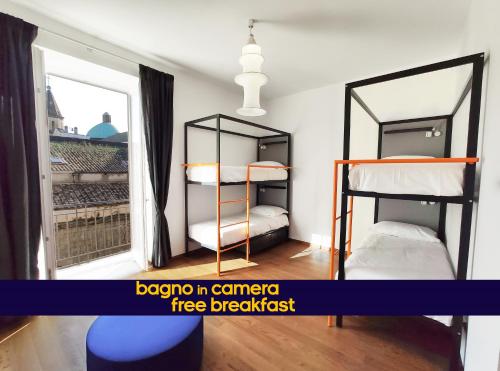
The bunk beds are fairly standard, but Tric Trac Hostel has a fun modern feel and a great breakfast.
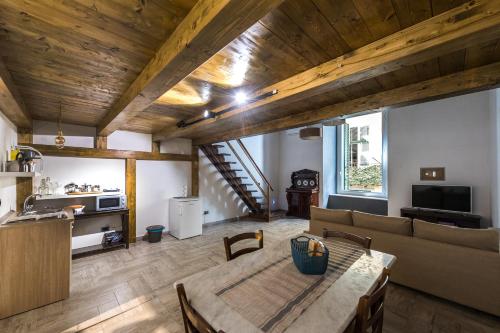
A large apartment with a cool design, Casa Calu makes a great base if you’re staying a while
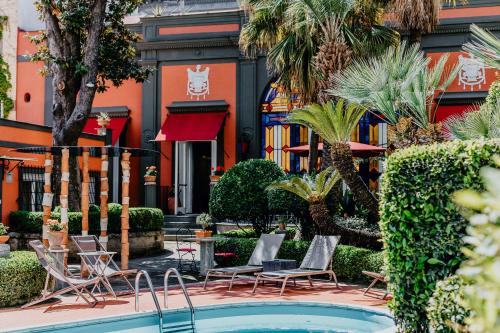
Like an oasis in the middle of the city, Costantinopoli 104 is set within a gorgeous 19th-century villa with a pool.

It doesn’t get much more luxurious than the Britannique Hotel , with fabulous suites and panoramic views.
Also, if you have any suggestions for sights in the city that you would recommend people see, please feel free to add them in the comments below.
This site is on the UNESCO World Heritage List ! I'm on a mission to visit as many World Heritage Sites as I can. Only about 800 more to go... eek!
5 thoughts on “How to spend a day in historic Naples”
Such a great detail and article you write up! These tips really helpful to explore the historic centre in Naples(Italy). Your photography really awesome!! Thank you so much for sharing a great experiences. Keep sharing!
I am visiting Naples next week, and your post will be very helpful! I hope to have a chance to see most of the city’s sights. Naples looks really wonderful! Thanks for sharing!
This has been very helpful I don’t usually write comments but this article has been done perfectly. Thank you for your time 🙂
I found this really helpful in planning our stay in Naples in January. Thank-you!
My husband & I have travelled for years, but we have not been to Naples, Pompeii, or the Amalfi coast. We truly appreciate your map, suggestions, and detailed ideas. Thank you!
Leave a comment Cancel reply
In italy, i recommend:.
🏨 Hotels: Booking.com 👩🏫 Tours: GetYourGuide 🚗 Car hire: Discover Cars ⛴️ Ferries: Ferryhopper
Find me on the socials:
Subscribe for news and deals:.
top stories:

Ultimate Travel Guide for Naples, Italy
Are you planning a trip to naples – italy’s city of pizza, volcanoes, and nativity scenes.
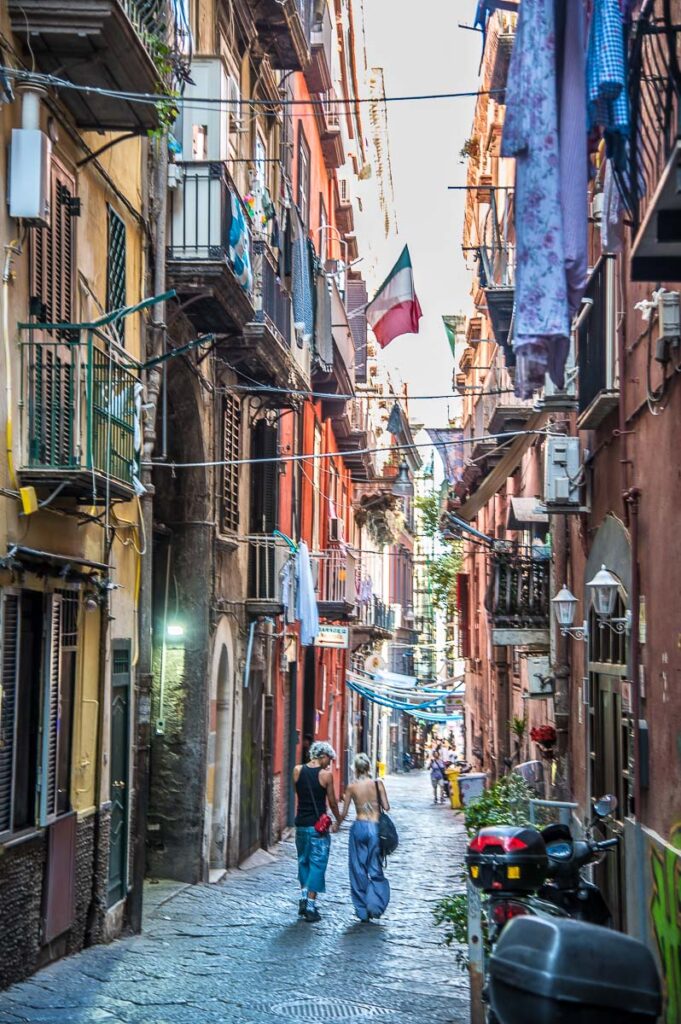
This is my ultimate travel guide for Naples or Napoli , as the city is called in Italian. It’s designed to make your travel planning easy, logical, and enjoyable. It will also help you experience the largest city in Southern Italy in the most authentic way.
Built on a caldera and with a heart as passionate as a volcano, Naples is a vibrant, stimulating place where you can rediscover the joy of life. Good food, strong coffee , excellent art, and quaint experiences are easy to come across here and even a simple thing like the abundance of vibrant colours and the buzzing hubbub of Neapolitan daily life can make you feel alive inside.
Yet, Naples is also one of the most polarising cities in the world. Travellers either sing its praises or don’t spare negative words. Densely built, Naples is a maze of streets many of which can trace their outlines to the city’s ancient Greek urban plan.
Exhilarating and overwhelming in equal measures and often at the same time, the city has been growing with an unstoppable verve for almost three millennia. The result is an immense metropolis that spans the picturesque Gulf of Naples, shoulders the iconic Mount Vesuvius and buzzes with the voices of the million people who call it home.
This is a place that over the centuries has accumulated a staggering collection of architecture and art. They reflect both ancient local traditions and a wide array of outside influences on account of the many foreign rulers that Naples has had. This makes it both Italy’s most international city and the Italian city with the strongest identity.
Naples’ churches, palaces, artisan workshops, and streets tell many captivating stories. You just need to have the ear to listen and the eye to perceive them beyond the graffiti-covered facades, the economic difficulties, and the rubbish bags that pile up on street corners every night.
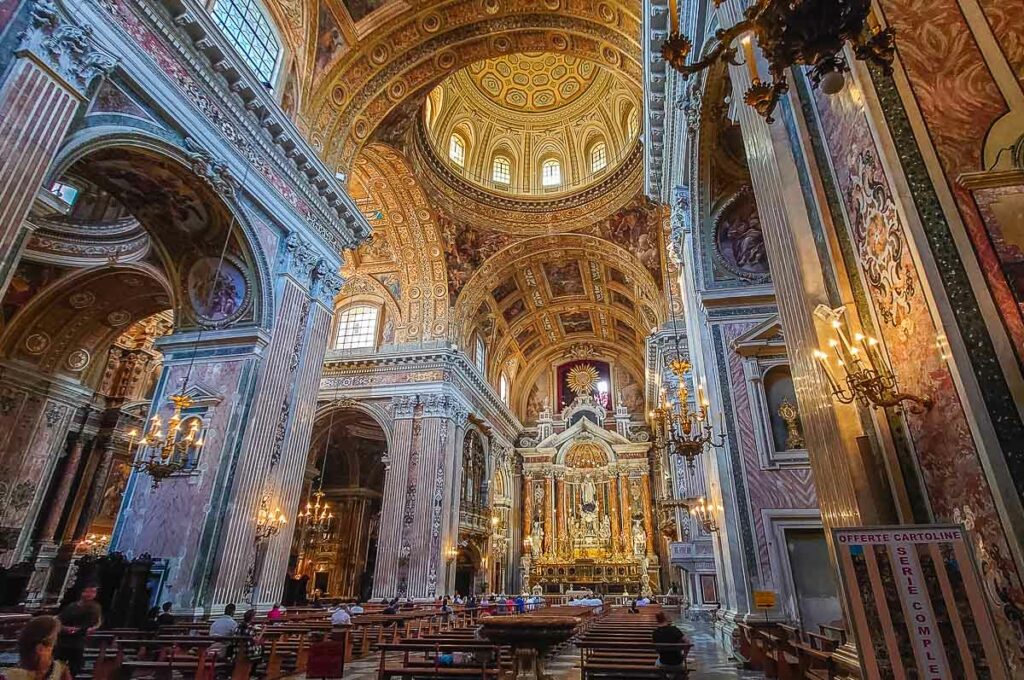
The financial distress that the city experiences obviously puts some travellers off Naples for life. That’s a real shame! For this is a raw and real place, far from the polished images that social media deals with, and yet full of energy and with hidden depths.
Take Naples at face value and you will see that while it’s not picture-perfect, it influences us on many levels. Over the last three millennia, the city has originated fables, movements, and trends time and time again. Its heritage speaks volumes. To see and experience everything that Naples has to offer – from ancient ruins and modern art to food and coffee rituals – would take a lifetime.
In other words, more than a city, more than a destination to visit as a tourist, Naples is a state of mind. As such, come here with an open heart and ready to discover things about history, art, beliefs, gastronomy, and yourself that may push your limitations beyond your comfort zone.
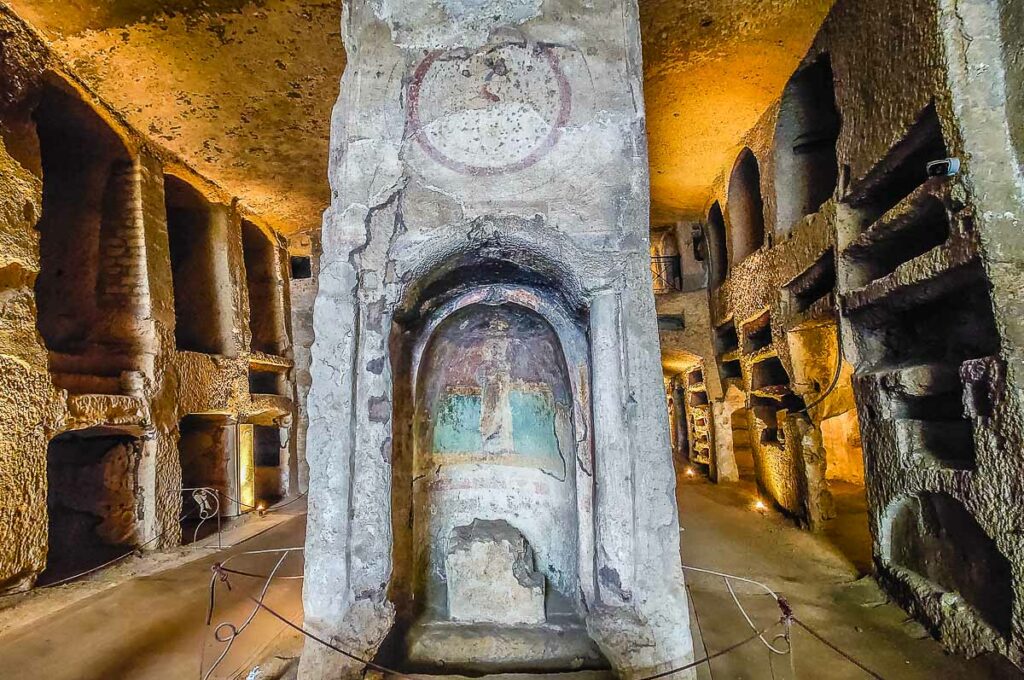
So, to help you plan your trip to Naples, I have researched, photographed, and written this ultimate travel guide. Scroll down and browse through its sections. All the usual topics like how to get to Naples, where to stay in Naples, what to eat in Naples, and what are the best things to do in Naples are covered.
In addition, you will find my answers to many more pertinent and curious questions. For example:
- Is Naples safe?
- Where to see the best presepi in Naples?
- How to explore Naples with kids?
- What are some hidden gems to discover in Naples and what day trips to take nearby?
I have included maps, lots of practical details, and numerous real-life photos to give you an idea of what to expect. You will also find the best times to visit Naples, tips for navigating this traffic-heavy city, and practical packing suggestions. These are followed by the best guidebooks and books for Naples, the best tours you can take here, as well as a list of the artisan Neapolitan products to shop for.
Scroll down to the end of this guide to see my top five tips for visiting this stimulating on so many levels city in Southern Italy. Finally, read the five things you should never do in Naples. They are always good to keep in mind!
Have a look and enjoy your Naples trip!
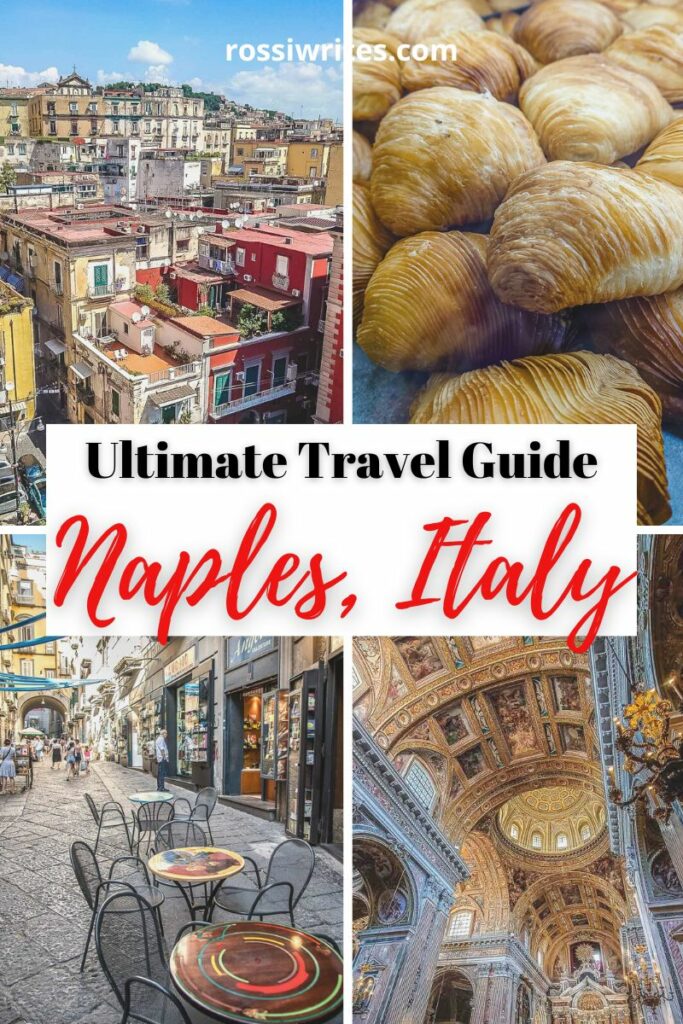
The information in this travel guide reflects my first-hand experience. It may contain affiliate links and if you click and make a purchase through them, I may receive a small commission at no cost to you. The ads on this page help me keep this blog free and produce new travel content for you to enjoy. Full details in my Disclosure .
WHERE IS NAPLES?
Naples is the largest city in Southern Italy and the capital of the Italian region of Campania. With just under a million people living here, it is the country’s third-largest city after Rome and Milan .
It lies along the Gulf of Naples – a 15-km wide bay along the southwestern coast of Italy. The densely built-up city sprawls from the supervolcanic area of the Phlegraean Fields ( Campi Flegrei ) to the iconic Mount Vesuvius.
The adjacent map shows you the city’s exact location in Southern Italy. You can click on it to zoom in and out in order to see further details.
Naples ranks among the ten most visited cities in Italy. It attracts just over a third of the number of tourists that head to the country’s most popular destination – Venice .
The city has an incredibly rich offering in terms of historic and artistic heritage. Its gastronomic traditions are at the basis of several worldwide famous and beloved dishes topped by pizza.
Naples is a must-see place in itself. It also offers quick and easy access by road, sea, and railway to several other popular destinations in Italy. From the historic ruins of Herculaneum, Pompei, Pozzuoli, Capua, and Paestum to the picturesque coastal towns of Amalfi, Positano, and Ravello, Naples is the starting point for many exciting and enriching trips in Italy. A ferry ride from Naples away, you can also visit the beautiful islands of Capri, Ischia, and Procida.
IS NAPLES WORTH A VISIT?
The short answer is yes, Naples is very much worth a visit. Almost three millennia old, the largest city in Southern Italy is a vibrant stimulating place dotted with iconic must-see sights and offering the best cuisine this side of Europe.
Hugging the curve of the Gulf of Naples and sprawling in the shadow of the infamous Mount Vesuvius, this city has a passionate character marked by sharp contrasts.
Built on several layers – from ancient catacombs to multi-storey Baroque palaces and modern-day skyscrapers, in Naples, the past, the present, and the future blend into an exciting synthesis.
This is a city where you can walk along streets which follow the outline of ancient Greek and Roman roads, where deeply entrenched superstitions and folk traditions mingle with the most heartfelt Catholic faith, and where dishes made of simple seasonal foodstuffs have been elevated to nourishment for the soul.
Naples is also a place where poverty exists right next to the most splendid pinnacles of European architecture and art; where people ride pillion with no helmets on (and sometimes have their dog on the scooter, too); where the crowds, the smells, the colours, the graffiti, and the constant play of shadows and light in large courtyards and narrow streets make you suddenly feel reenergised, full of purpose, and ready to live your most exciting life.
Yes, Naples is worth a visit as here you never know what to expect next. Around every corner, there is a new surprise. It could be the Immacolata Obelisk which, they say, at sunset reveals Death holding a sickle. Or it could be the Sanfelice Palace that seems plucked out of an Escher’s print.
In fact, Naples is worth numerous visits as there is always something new to see and experience here, a new wave of excitement to wash all over you. It is one of those precious places that make travelling an adventure that you’ll remember and recall with love and passion when the humdrum of daily life gets too much.
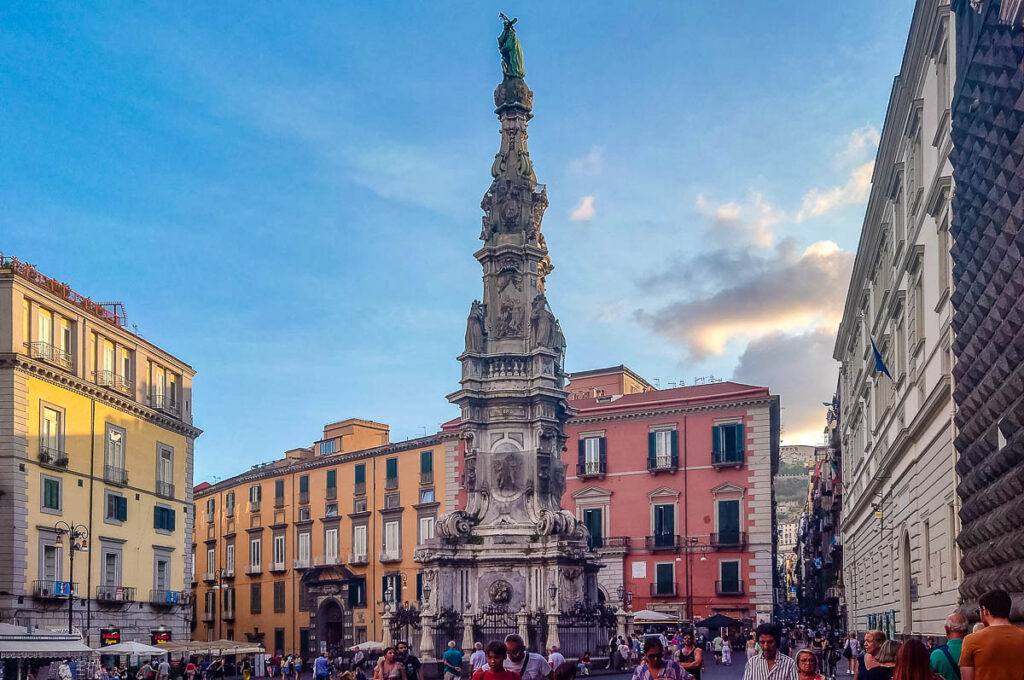
WHAT IS NAPLES CALLED IN ITALIAN?
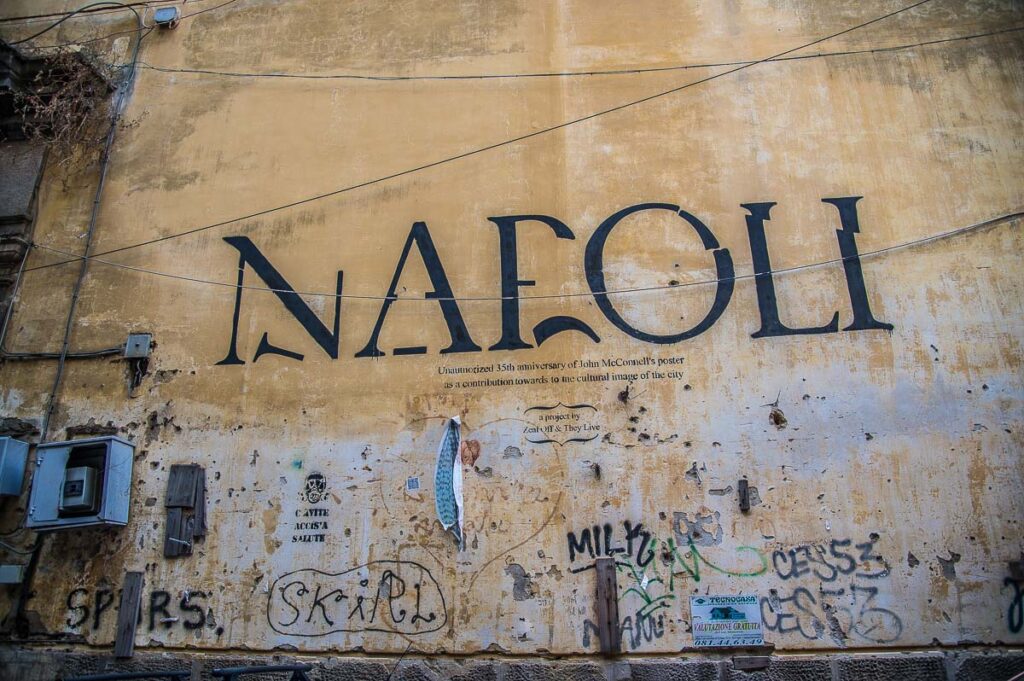
In Italian, Naples is known as Napoli . In the Neapolitan language , the city is called Napule . In both cases, the accent falls on the first syllable. Both Napoli and Napule have evolved from the Ancient Greek name of the city – Neapolis, meaning ‘New City’.
Naples is also sometimes referred to as the città dalle 500 cupole , or the City of 500 domes in English, on account of the large number of churches dotted along its streets. Another of Naples’ monikers – città dei sette castelli – is also linked to its architectural heritage. The locals claim that theirs is the only city with seven castles in the world.
La città obliqua is a poetic reference to Naples, too. It comes from a famous song by the singer-songwriter Edoardo Bennato who was inspired by the unique Neapolitan landscape – neither entirely horizontal nor fully hillside. And so he sings:
It’s not flat, it’s not vertical it is a line that goes up the hill it is a road that starts from the sea The path of the oblique city.
More often than not, however, you will hear napoletani refer to themselves as partenopei and to their city as the città partenopea or the Parthenopean City. This is based on the foundation myth of Naples which is linked to the siren Parthenope – a mythical creature with a bird’s body and woman’s head.
Parthenope had a beautiful voice. Sailors were so bewitched by her singing that they would forget to steer their ships which would then crash against the rocky shore of what nowadays is known as the Sorrento Peninsula.
To avoid a similar fate, the Greek hero Ulysses made his men plug their ears with wax and bind him to the mast of his ship. This way, he could enjoy the siren’s song without sacrificing his ship and his crew.
Unable to make Ulysses fall in love with her and thus lure him to his death, Parthenope threw herself off the rocks. Her body washed on the island of Megaride where the local people found it and buried it. A settlement carrying the siren’s name quickly grew around her burial site. It was also known as Palaepolis (Old City) as around 470 BC, Neapolis (New City) was founded right next to it by Greek settlers.
Nowadays, Naples has expanded significantly beyond the limits of the original Palaepolis and Neapolis. The island of Megaride, today is a peninsula in the Gulf of Naples and houses the city’s oldest fortress – Castel dell’Ovo .
Finally, as you saw at the start of this Naples travel guide, I called it the City of Pizza, Volcanoes, and Nativity Scenes. The first is self-explanatory as the pizza napoletana is famous all over the world (especially the Naples-born pizza Margherita prepared with tomato sauce, mozzarella cheese, and basil leaves). With the volcanoes of the Phlegraean Fields and Mount Vesuvius playing a major role in the geology and the history of the area, the second part of the moniker is also clear.
As for Nativity scenes, Naples is famous for its tradition of artisan presepi . These are intricate Christmas cribs representing the Holy Family in the stables in Bethlehem. Beloved all over Italy, the best ones are handmade in Naples. I mention them in more detail below under the headings Best Presepi in Naples and What to Buy in Naples .
NAPLES AND ITS QUARTERS
Naples is a large sprawling city divided into 30 quarters. Here are the main urban areas to visit in order to see the best that it has to offer:
Centro Storico – a UNESCO World Heritage Site , Naples’ historic centre is a vast area in the heart of the city where you will find the most famous landmarks – from the Veiled Christ in the Sansevero Chapel and the tiled cloister of the Monastery of Santa Chiara to Piazza del Plebescito and the Royal Palace. Follow Spaccanapoli – the long artery of straight streets that flow one into another and in the process splits the city in two. Look out for the large obelisks dotted along its route. Stuff yourself with pizza in all its Neapolitan varieties along Via dei Tribunali . Dodge the constant traffic of scooters and evade the persistent greeters trying to get you to enter their eateries. Find temporary peace and quiet in Naples’ former water cisterns .
Rione Sanità – a former no-go area, this authentic corner of Naples is where you can visit the striking Catacombs of San Gennaro – my absolutely favourite landmark in Naples. A short walk away don’t miss the macabre Catacombs of San Gaudioso underneath the resplendent Basilica of Santa Maria della Sanità. The Palazzo dello Spagnuolo and the Palazzo Sanfelice are a must for lovers of architecture.
Quartieri Spagnoli – with a name that is a throwback to when Naples was ruled by the Spanish Bourbons, this Neapolitan quarter epitomises the city. Expect narrow streets, laundry flapping above your head, and lots of graffiti. Don’t miss the Pignasecca market – a hub of activity that is quintessential Naples.
Vomero – hop on a funicular for an exhilarating ride to the top of the Vomero hill and enjoy the unparalleled panoramas of Naples flanked by Mount Vesuvius. Then visit the proud Castel Sant’Elmo and the former monastery of Certosa di San Martino .
Chiaia – this upmarket quarter of Naples is a great place to stay in if you want to be close to the sea, the luxury boutiques, and the Villa Comunale expansive lush park.
Santa Lucia – standing right where the original settlement of Parthenope (or Palaepolis) first grew, Santa Lucia is a historic quarter of Naples where you can visit the mysterious Castel dell’Ovo , marvel at the imposing Fontana dei Giganti , and indulge in fresh seafood in the fishermen’s Borgo Marinari .
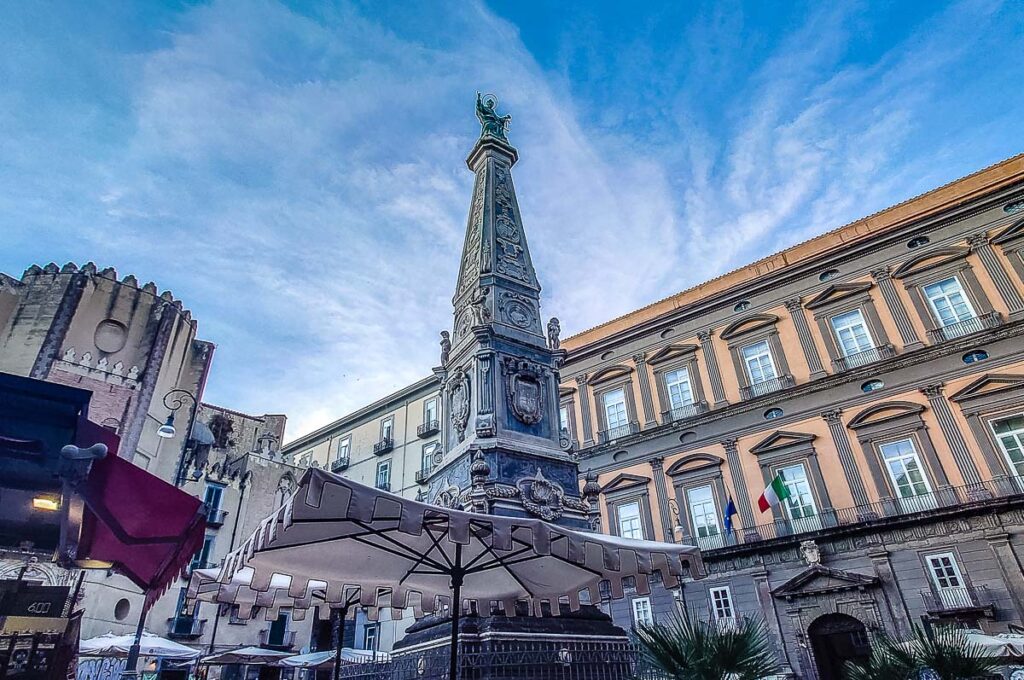
BEST AIRPORT FOR NAPLES
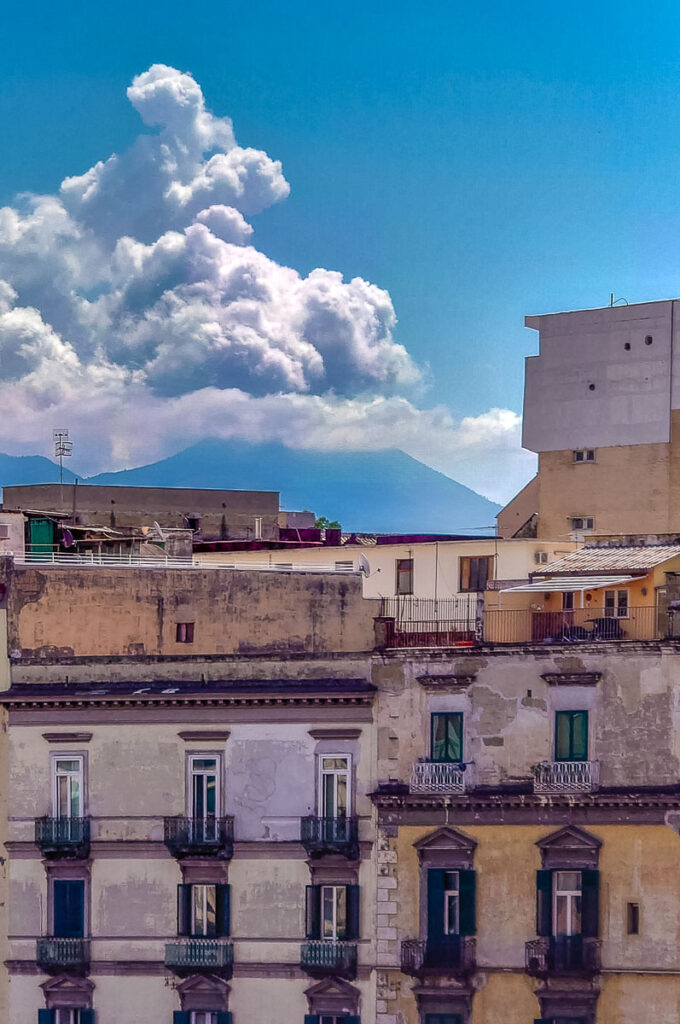
Naples has its own airport – Aeroporto Internazionale di Napoli Capodichino (IATA airport code: NAP). It is one of the busiest airports in Italy and it’s only four km away from the city centre.
It is served both by low-cost and full-service carriers, making Naples easy to reach from all corners of Europe and the world. The flight from London Gatwick, for example, is just over two and a half hours, so Naples is a great destination for a long weekend.
The official website of Naples Airport has a lot of useful information – from how to reach the airport to what shops and restaurants you will find here.
Shopping is excellent with many international chains and high fashion brands having stores here. There are also numerous eateries which is handy especially when you know that you are about to leave Naples and you want to have one last delicious pizza or sfogliatella pastry for the journey ahead.
AliBus is the coach line linking Naples Airport to the city centre. You can take it either to:
- Piazza Garibaldi – in front of the city’s main train station, Napoli Centrale ; or
- Port of Naples – a short walk away from the centrally located Piazza Municipio .
We were lucky as we were met by a friend of a friend upon our arrival in Naples. He drove us to the flat we had rented in the historic centre giving us our first taste of the famous Neapolitan driving style.
On the way back, we found getting a taxi to reach the airport from the historic centre very handy as we were lugging a heavy suitcase. The journey door to door took less than half an hour and cost us around 30 euros.
HOW TO REACH NAPLES?
Naples is very easy to reach by railway, road, and ferry from anywhere in Italy and abroad.
High-speed and regular trains connect Naples all throughout the day to many towns in the region of Campania and major cities all over Italy. You can check timetables and book your tickets on:
- Omio – which pulls up results for both state-run and private railway companies in Italy;
- TrenItalia – which covers the state-run train network of Italy.
Here are some sample travel times by high-speed train from the Italian capital and other large Italian cities to Naples’ main train station, Napoli Centrale :
- Rome to Naples – from 1 h 13 mins;
- Florence to Naples – from 3 h;
- Bologna to Naples – from 3 h 31 mins;
- Milan to Naples – from 4 h 45 mins;
- Venice to Naples – from 5 h 22 mins;
- Turin to Naples – from 6 h 3 mins.
The following ferry companies connect Naples to the nearby islands of Capri, Ischia, and Procida, the Aeolian Islands, as well as to the towns on the Amalfi Coast and further away destinations like Sicily: SNAV , Caremar , and Medmar .
You can drive to Naples from anywhere in Italy, too. Toll roads (called autostrada , sing. and autostrade , pl. in Italian) connect the city to other large Italian cities and smaller towns. Here are the autostrade you can use here:
- A1 Autostrada del Sole – Milan to Naples
- A3 – Salerno to Naples
- A16 – Canosa to Naples
- A56 Tangenziale di Napoli – this is Naples’ ring road from Arco Felice to Capodichino
This useful website will give you up-to-date information about navigating Italy’s autostrade , the current traffic conditions, as well as how to calculate and pay the toll fees (called pedaggio in Italian).
If you are planning to visit Naples by car, you need to prepare yourself mentally for the busy traffic and the assertive driving style of the city. Make sure that your car insurance covers all eventualities. Ideally, arrange for a parking space in advance. Some travellers report that in some corners of the city, you may be asked to pay an additional fee to have your car ‘looked after’.
It is also advisable to familiarise yourself with Naples’ ZTL or zones with restricted traffic which can be traversed by car only if you have a special dispensation. This website may come in useful when you look into ZTL and the respective restrictions.
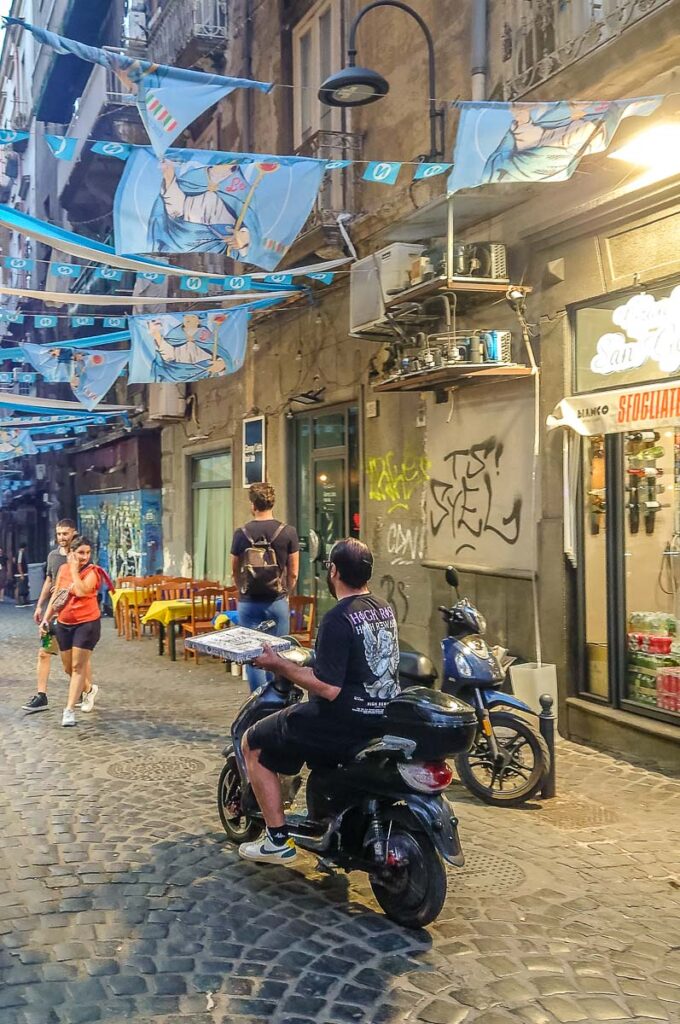
HOW TO NAVIGATE NAPLES?
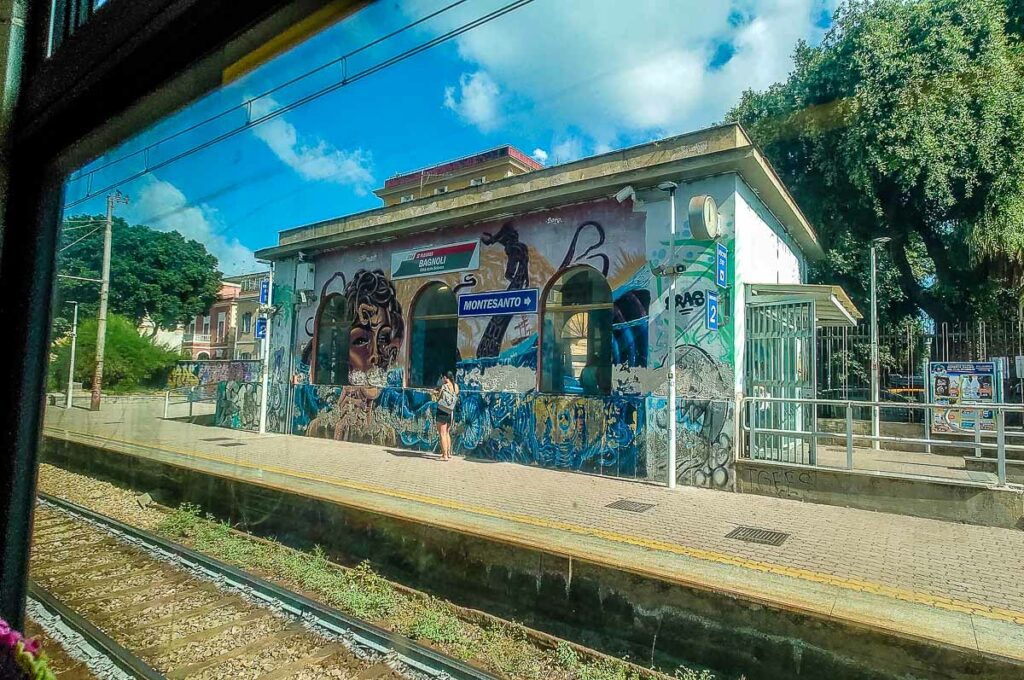
You can navigate Naples on foot as well as by bus, metro, funicular, and taxi. In some parts of the city you can get a tram and/or a trolleybus. There are also regional trains which connect Naples to several adjacent suburbs, towns, and landmarks nearby.
Naples’ historic centre and quarters are best explored on foot so that you can fully immerse yourself in their atmosphere. The narrow streets here often lack pavements and at all hours of the day experience a hectic flow of scooters, delivery vans, and cars. It pays to be vigilant at all times, especially next to turns and corners. Drivers are skilled but very impatient and expect you to move away asap. Otherwise, they keep pushing forward and whizz right past you.
Buses (as well as metro lines, trams, and trolleybuses) are very convenient if you want to save time walking from one quarter to the next. For example, we took a bus from the edge of the historic centre to the top end of Rione Sanità – a journey which took us about 15 minutes (inclusive of walking to the bus stop and time waiting for the bus) instead of the 30 minutes which walking there would have taken us.
Four funiculars connect Naples’ lower grounds to its hilly parts. They are very handy, especially on a hot day when you can’t bear to walk uphill for miles.
For up-to-date information about public transport in Naples, have a look at the official websites of Comune di Napoli and ANM – Agenzia Napoletana Mobilita . You will find exhaustive information about the different ways to travel here either by bus , funicular , metro , tram , or trolleybus , as well as about the different types of tickets and where to purchase them. At present, the websites seem to be only in Italian, so you may want to use Google Translate to get the gist of the information.
Taxis circulate through the historic quarters and can quickly take you anywhere in Naples, as well as to the nearby archaeological excavations, picturesque towns, and even Mount Vesuvius. You can download an up-to-date rate table from the official website of Comune di Napoli .
To reach the excavations of Herculaneum and Pompei by public transport, you will need to get the Circumvesuviana regional train. Use the EAV – Ente Autonomo Volturno’s website to check prices and timetables. There is a useful section in English.
To reach the towns and the archaeological parks in the Phlegraean Fields ( Campi Flegrei ), use the EAV website, too and check the timetables for the Cumana and the Circumflegrea train lines.
WHAT TO PACK FOR NAPLES?
The most important thing to pack for a visit to Naples in any season is a pair of comfortable shoes. You will be walking long distances over all types of historic surfaces many of which are uneven. You will also spend time standing up and moving at a variable pace over long periods of sightseeing.
Make sure that your feet are as comfortable as possible. Choose shoes with a good grip that cushion your heels and support your ankles at all times. Even on the hottest of days, it’s advisable to wear closed shoes or shoes that at least cover your toes, especially if you are planning to explore the historic centre, Rione Sanità , or the Quartieri Spagnoli as they are very busy and spillages next to markets and small businesses may occur.
In winter, bring warm layers to stave off the chills produced by the high levels of humidity and yet can be quickly peeled off when the sun makes an appearance. In summer, bring a hat, sunglasses, and suncream to counteract the bright sunlight that bounces off the large facades and floods the wide piazzas. Invest in fabrics that dry quickly, are crinkle-free, and let your skin breathe through them. A rainproof jacket will come in handy in autumn when rainy days are plenty.
Even when it’s very hot, make sure that your outfits are appropriate for city living and respectful sightseeing. Shoulders and knees should be covered in churches and landmarks. Swimsuits are not acceptable attire on the street.
In any case, don’t overpack as navigating Naples with heavy luggage can be difficult, especially if you are planning to use the busy public transport. Instead, select pieces that can be matched with one another, producing outfits that look different every day but rely on the same small number of core pieces.
Leave expensive and ostentatious jewellery, watches, and accessories at home. Invest in a cross-body bag with a sturdy strap. Put a bottle of hand gel in it as well as your favourite mosquito and bug repellents, albeit a spray, a roll-on or a bracelet .
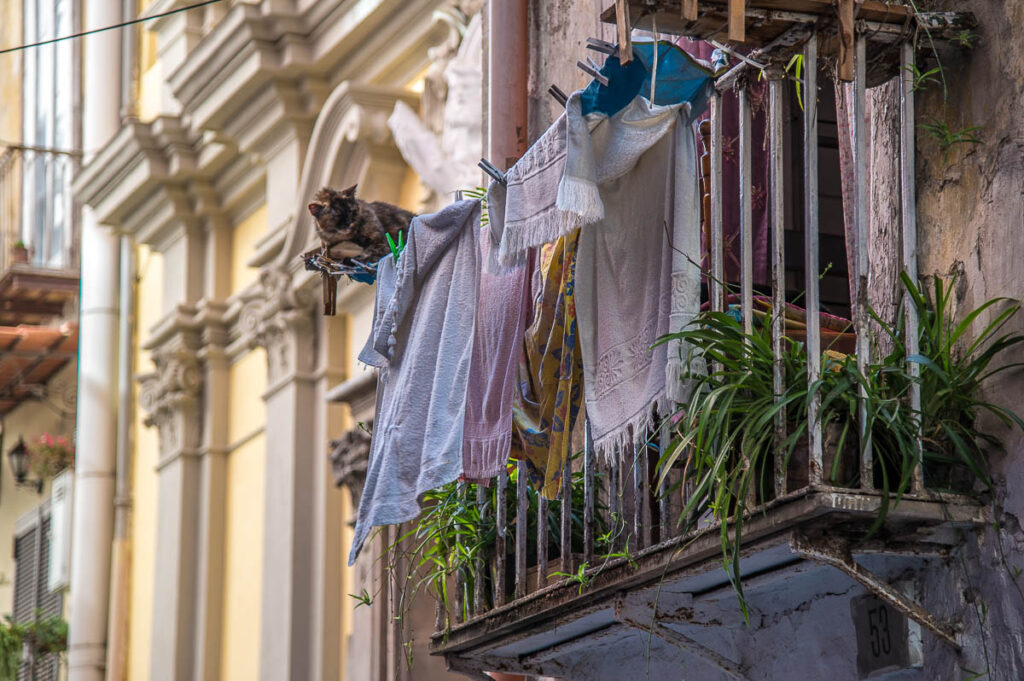
BEST TIME TO VISIT NAPLES
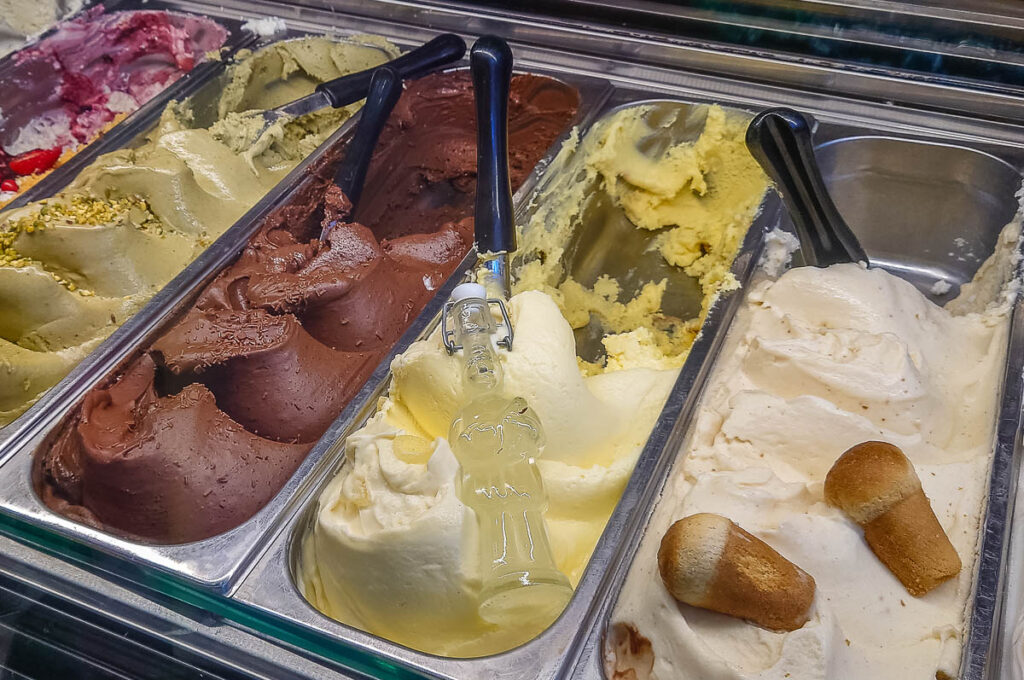
Naples is exhilarating in any season and there are lots of things to do here no matter the weather. So, visiting Naples is always a good idea – from a weekend break to a long holiday, the City of Pizza, Volcanoes, and Nativity Scenes offers an exciting immersion into the art, food, and heritage of this corner of Italy and Europe.
The shoulder season – from the end of March to May and then from the end of September to the start of November – is easily the best time of the year to visit Naples. Expect temperatures between 17 and 27 degrees Celsius and some rainy days but mainly clear skies.
Summers are hot and humid. With temperatures between 30 and 40 degrees Celsius, you will need to pace your sightseeing as being out and about in the throng of tourists and locals can quickly become tiring and overwhelming.
At the same time, summer is when Naples is full of vibrancy and life, so take long gelato breaks, linger over lunch, and commit to no more than two major sights a day (and a couple of smaller ones) to make the most of the sunny days and people-watching. If possible, return to your accommodation in the afternoon for a sweet little nap which will give you strength for a leisurely stroll (called passeggiata in Italian) in the early evening followed by a proper Neapolitan supper.
Winters in Naples are mild in comparison with most of Europe. The thermometer can go as high as 16 degrees Celsius. While this is not sunbathing weather it’s still a welcome escape from the minus temperatures in the northern European destinations. The Christmas season is especially lively. Expect lots of local events culminating in beautiful exhibitions of Nativity scenes and heartfelt celebrations.
You may also want to visit Naples for one of the city’s main festivals. Have a look at the heading Events in Naples further below to see what’s on and when. Then make your travel plans to experience quirky centuries-old traditions.
HOW LONG TO STAY IN NAPLES AND A 4-DAY ITINERARY
There is so much to see and do in Naples, that a plan to visit the city can quickly become an overwhelming jumble of ideas, intentions, and half-baked itineraries.
The best way to approach Naples is to be clear with yourself from the start that the city cannot be seen and done in a day or two and that no matter how long you spend here, there will always be sights and monuments to see on your next visit.
So, don’t overstretch yourself and don’t rush around like mad trying to squeeze in as much sightseeing as you can. Especially, if it is hot! Instead, either:
- focus on a particular period , for example, ancient ruins or Baroque art and architecture;
- pick a couple of Naples’s historic quarters to explore in detail; or
- pencil two major sights a day to see at leisure and then fill the rest of the time with culinary experiences and spontaneous visits to any church, quirky shop, and hidden gem of a landmark you walk past.
In other words, instead of treating Naples as one endless list of sights that you have to tick off, tailor your visit according to your interests, willingness to walk long distances, and your curiosity. Be open to spontaneous experiences and let the city surprise you.
For a first visit to Naples, ideally, I would suggest four full days. These can be as packed up or as relaxed as you wish. Take your pick from this busy four-day Naples itinerary below:
Day 1: Traverse Naples’ historic centre. Pop in and out of churches (Duomo, Monastery of Santa Chiara, and the Church of Gesù Nuovo are a must but there are many more), explore the city’s charming piazzas, walk along Spaccanapoli , take an underground tour , shop for Christmas decorations on Via San Gregorio Armeno , visit some of the major sights here like the Sansevero Chapel and Pio Monte della Misericordia . Later in the afternoon, head to Piazza del Plebescito with Naples’ Royal Palace , as well as Teatro di San Carlo and the elegant shopping arcade Galleria Umberto I nearby.
Day 2: Begin the day with an early morning visit to the Museum and Royal Wood of Capodimonte . Then explore Rione Sanità with the Catacombs of San Gennaro and San Gaudioso , Palazzo dello Spagnuolo , Palazzo Sanfelice, and the Fontanelle Cemetery (when it re-opens). Spend the afternoon in MANN – Naples’ outstanding archaeological museum where you can see Pompeiian frescoes and mosaics, ancient statues, and so much more. If you still have some energy left, end the day in Museo Madre – Naples’ outstanding museum of contemporary art.
Day 3: Spend the day visiting either Herculaneum or Pompeii followed by a hike up Mount Vesuvius . There are many different ways to do it either independently or with an organised tour. To reach the excavations of the two ancient Roman towns, you need to get the Circumvesuviana train. The respective stops are Ercolano Scavi and Pompeii Scavi – Villa dei Misteri . You can buy your tickets for the archaeological sites either in advance to skip the queues or in situ. Once there, if you want, you can pay an additional fee for a private guide or a guided tour or just explore the ruins independently. To reach Mount Vesuvius from the train station Ercolano Scavi , you can get the Vesuvio Express which includes roundtrip transport and a ticket for Vesuvius National Park. There is also a similar option to visit Vesuvius from Pompeii. Otherwise, you can buy tickets for the roundtrip bus and for the Vesuvius National Park separately. Alternatively, you can book a guided tour which takes all three – Herculaneum, Pompeii, and Vesuvius – in a day.
Day 4: Spend your last day in Naples by exploring some of its other quarters. Chiaia, Santa Lucia , Vomero , and the Quartieri Spagnoli offer a vibrant mosaic of sights, smells, and views. Once again, don’t expect to cover all four in a day, so pick a major sight in a couple of them or simply amble through one of them.
This four-day itinerary for Naples will give you a good introduction to everything that this exciting Southern Italian city has to offer. Any return visits to Naples then can be of any length to catch up on anything you have missed and to discover yet more sights, museums, and corners of the city.
In any case, if you don’t have four days to spare and still you really want to see Naples, just come. Even if it’s just on a day trip from Rome. Enjoy your time (however short!) in the city and before you know it you will be making plans to return again and again.
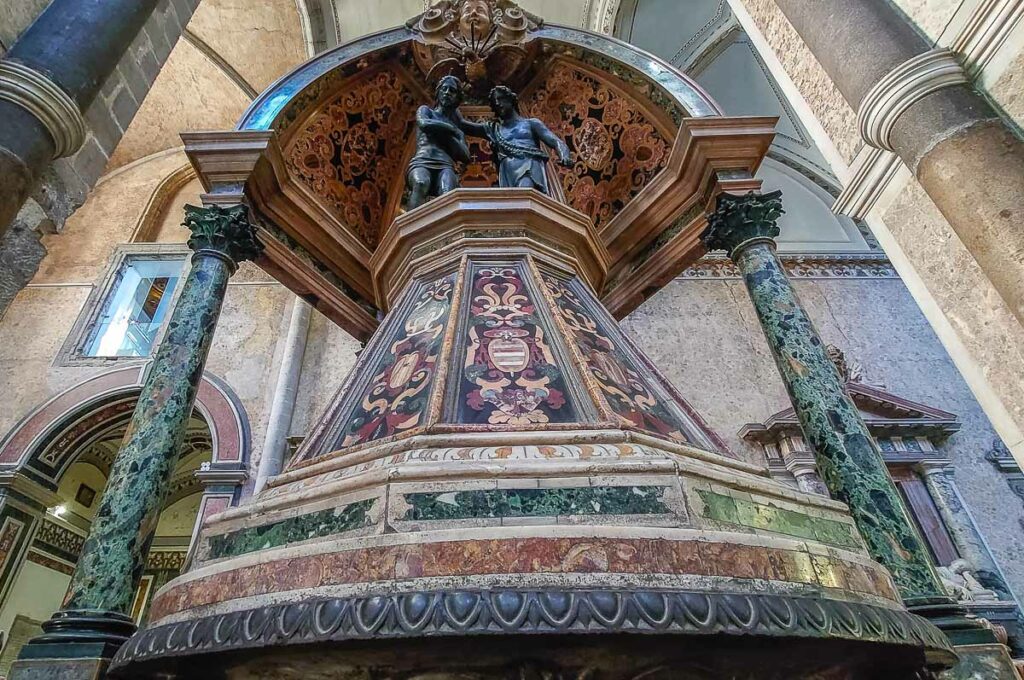
WHERE TO STAY IN NAPLES?
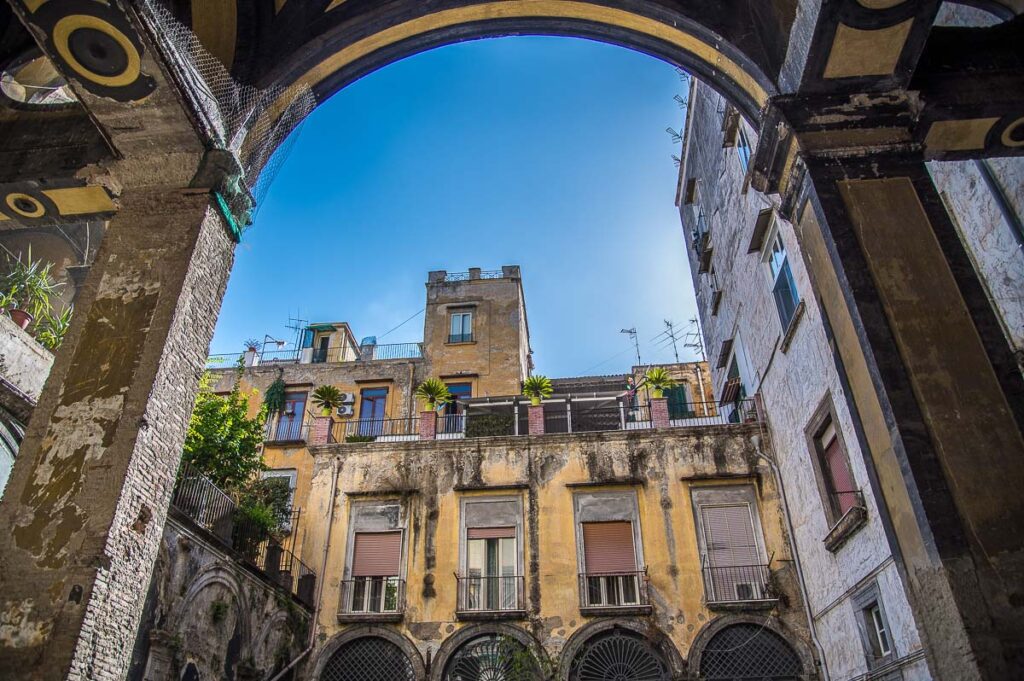
There is a huge selection of places to stay in Naples in any season and for any budget.
You can choose a historic building that nowadays functions as a luxury hotel. You can opt for a comfortable B&B . Or you may prefer an accommodation with its own kitchen to enjoy a home-from-home experience.
When picking accommodation in Naples consider carefully its location. Depending on what you want to do and see here, you may prefer to stay closer to the major landmarks, a bus or metro stop, or in a hidden corner of the city that offers peace and quiet.
If your focus is sightseeing in Naples, then it pays to stay in the historic centre. For more of an upmarket experience, look into the quarter of Chiaia . The area around Piazza Garibaldi and the main train station, Napoli Centrale , is convenient in terms of public transport but it made me feel on the edge every time we needed to walk through it.
Here are some suggestions for places to stay in Naples. All come highly recommended:
Luxury: Grand Hotel Vesuvio , Palazzo Doria Napoli , The Britannique Hotel Naples, Curio Collection by Hilton
Mid-Range: Relais della Porta , Artemisia Domus – Centro Storico , La Lepre Bovio
Budget: Ostello Bello Napoli , Leone Suites Toledo , EMME Napoli
Alternatively, use the map included here to get a quick visual idea of the available accommodation options in Naples, Italy. You can zoom in and out, type in your specific travel dates, and then click on the different price points for detailed information about the hotel you want to know more about.
In addition, have a look at this blog post which explains the different types of accommodation you can book in Italy. It will give you plenty of ideas to look into for the best and quirkiest places to spend the night at here:
- Where to Stay in Italy – 19 Types of Accommodation to Suit Any Budget
WHAT TO EAT IN NAPLES?
Neapolitan food is excellent. Eating here is a great experience that nourishes not just the body but the soul, too. Every meal in Naples has the potential to be absolutely unforgettable. So don’t waste any chances to tuck into yet another delicious local dish.
From inexpensive street food to the freshest seafood and local variations of pasta, Naples has a lot to offer even to the pickiest of eaters.
Pizza is always a good choice in Naples. Deep-fried foods taste so good after a long day of sightseeing. If you have a sweet tooth, you will be delighted with the rich displays of cakes and pastries. And you can finish it all off with a proper Neapolitan coffee prepared with a traditional flip pot called cucumella . Alternatively opt for a local liquor – from the world-famous limoncello to the herbal Strega , a distinctive digestif drink the name of which means ‘witch’ in English.
Here are some of the best Neapolitan foods and dishes to sample during your Italian holiday:
Taralli – this typical for Naples snack is circular in shape and traditionally made of lard, toasted almonds, and black pepper. Nowadays, it comes in many different flavours. Take your pick from the wide selection at Taralleria Neapolitana .
Pizza – you have to have a pizza or two when in Naples! Try as many of the traditional varieties as you can. Take your pick from pizza Margherita (tomato sauce, mozzarella, and fresh basil), pizza Marinara (tomato sauce, extra virgin olive oil, oregano and garlic), pizza fritta (a Calzone-shaped pizza stuffed with different fillings and deep-fried), pizza Montanara (open fried pizza topped with tomato sauce, mozzarella, and basil), and pizza portafoglio (a smaller pizza Margherita or pizza Marinara folded in four and eaten on the go. Or choose any other pizza with classical and innovative toppings offered in Naples’ best pizzerias. Many of them are clustered along Via dei Tribunali in the historic centre. It’s the city’s veritable pizza paradise!
Ziti alla Genovese – this is an iconic Neapolitan dish and it doesn’t have anything to do with the city of Genoa, although there are many theories as to how it got its name. Ziti is a type of extruded pasta typical for the Southern Italian region of Campania of which Naples is the capital. The genovese sauce is made of ground beef, cherry tomatoes, celery, carrots, and lots and lots of onions. It has a slightly sweet taste and it is very more-ish. Order it at La Locanda del Monacone .
Ragù – this Neapolitan meat sauce is absolutely delicious. Tomato-based, it’s made with beef and densely stuffed sausages left to simmer for hours. Try the ragù dishes of Tandem – a famous Neapolitan chain of ragù-centric restaurants. My favourite dish consists of thick slices of provola cheese served with an extra-generous helping of ragù on top.
Cuoppo Napoletano – this paper cone filled up with fried finger foods is proper Neapolitan street fodder. There are two main varieties – cuoppo di terra and cuoppo di mare . The first is a mix of battered and deep-fried chopped veggies, rice balls (known as arancini ), potato croquettes, and my favourite – zeppoline (delicious dough balls). The latter is a mix of battered and deep-fried seafood – from calamari to sardines. Try the cuoppo at Passione di Sofi .
Babà (also babà al rum ) – you will see these mushroom-shaped and rum-infused sponges all over town. Treat yourself to one when you are in the mood for something sweet and boozy. For added delight, have your babà with lots of whipped cream and strawberries, too.
Sfogliattella – this pastry is typical for Naples and comes in two varieties – riccia (made of overlapped sheets of filo pastry crisped to perfection) and frolla (made of thick shortcrust pastry). Both the sfogliatella riccia and the sfogliatell frolla are stuffed with a delicious filling of ricotta and candied citrus peel. Try the ones sold at Sfogliate e Sfogliatelle .
For an expert introduction to Neapolitan food and Naples’ best food joints, treat yourself to a specialised guided tour. This street food experience will take you around the city’s historic centre to sample traditional dishes in secret eateries frequented by the locals.
Alternatively, taste the best that Naples has to offer with this private tour . Expect ten drink and food tastings and the expert commentary of a foodie guide. If you would rather learn to cook the Neapolitan way, then get busy making your own pizza Margherita or pasta dish followed by tiramisu .
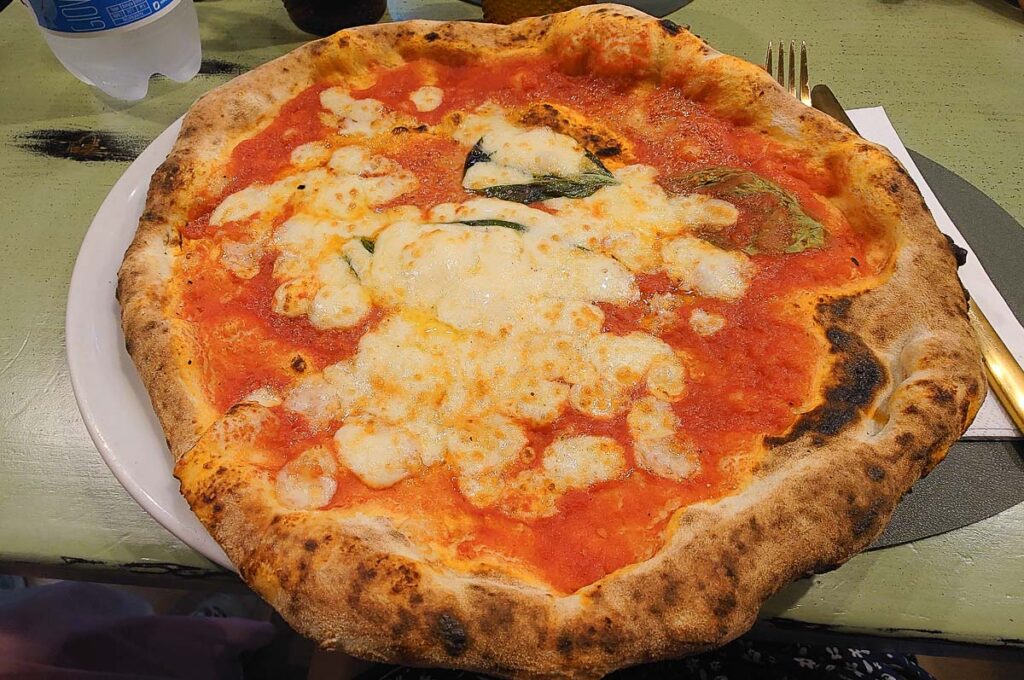
BEST THINGS TO DO IN NAPLES
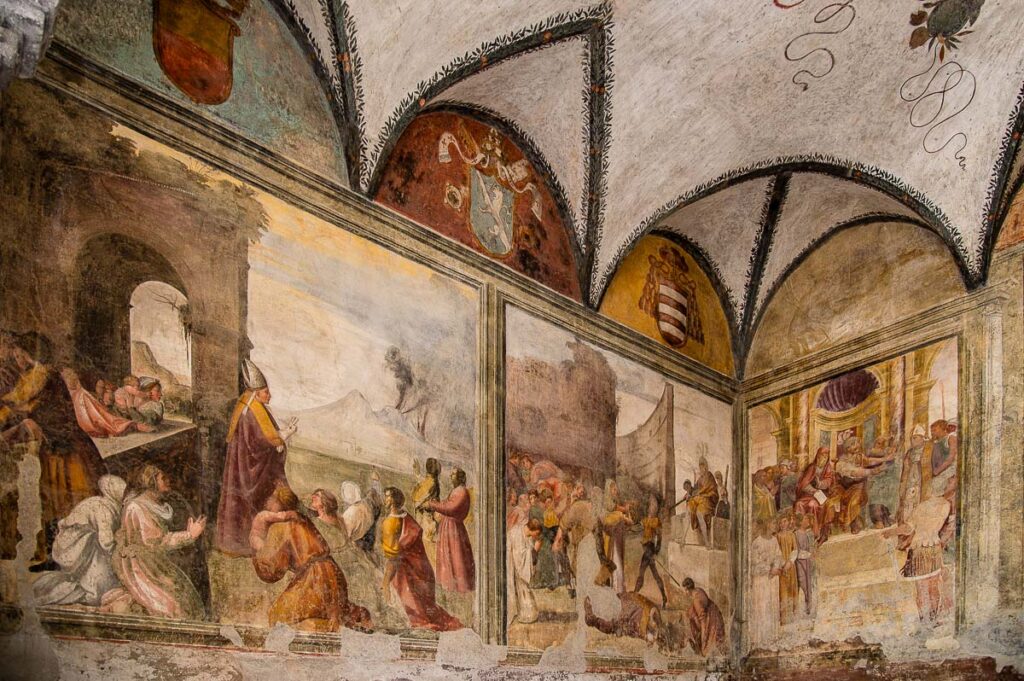
There are many wonderful and exciting things to do in Naples to suit all types of travellers and personal interests. This beautiful city has a lot to offer to the history buff, the art lover, the architecture aficionado, the foodie, the photographer, and above all the person who wants a vibrant and stimulating travel experience.
Here are the main things and activities you can enjoy in Naples. Specific examples for each one of them are provided up and down this page under the different headings of this ultimate travel guide for Napoli .
Sightseeing – Naples is studded with world-famous museums, millennia-old catacombs, and imposing churches with priceless art. With preserved outlines of its ancient Greek and Roman urban plans and plenty of historic spots to explore, this is one of the world’s best cities for sightseeing and landmark visiting.
Eating – Neapolitan cuisine has originated several of the world’s most famous foods with pizza holding the triumphal top spot. Eating here is a cultural experience. Try something new every single meal! Then take a food tour visiting historic deli shops and tiny eateries frequented by the locals. Even better, learn to make pizza the Neapolitan way yourself.
Water-Based Activities – here you are never far from the sea. You can take a ferry or a boat to the islands off the coast of Naples. Or you can enjoy a boat trip around Castel dell’Ovo and snorkelling in the gulf. If you want to combine water and history, then head to the Phlegraean Fields ( Campi Flegrei ) next door to Naples. In the Submerged Archaeological Park of Baia, you can enjoy a trip on a glass-bottomed boat and even a once-in-a-lifetime diving experience to see Roman mosaics and statues underwater.
Shopping – take advantage of exciting shopping opportunities when in Naples. Invest in a traditional Neapolitan Nativity scene (or at least in a small handmade figurine) on Via San Gregorio Armeno . Buy a selection of cornicelli (Naples’ protective amulet) to give as presents to family and friends. Get a cucumella – Naples’ traditional flip coffee pot. Splurge on handmade cameos and coral jewellery. Shopping in Naples is fun as each traditional, locally-made item has a story to tell.
Daytripping – Naples is a great base for day trips in this corner of Italy. From the world-famous Amalfi Coast to the archaeological ruins of Herculaneum , Pompeii , and Paestum , a long list of exciting destinations are only a short train ride away from Naples.
MAJOR LANDMARKS IN NAPLES
There are many must-see sights in Naples. These five major landmarks should be on top of your Neapolitan bucket list.
Spaccanapoli – one of the most iconic urban arteries in the world. This is a sequence of long straight streets which flow one into another and thus bisect Naples in two. Go for a walk along Spaccanapoli to sightsee and people-watch. Many of the city’s most interesting sights, for example, the Monastery of Santa Chiara , are on it or next door to it.
Sansevero Chapel – visit this small chapel in the heart of Naples to marvel at one of the most famous and most extraordinary statues in the world – the Veiled Christ. The chapel is a work of art in itself and was designed by the Italian soldier, alchemist, and inventor Raimondo di Sangro, Prince of Sansevero. Don’t miss the statues of the Veiled Truth and of Disillusion which are striking by themselves and were dedicated to the prince’s parents. The two 18th-century anatomical machines in the chapel’s basement are creepy yet incredibly intricate. You won’t be able to take your eyes off them!
MANN – National Archaeological Museum of Naples – a splendid museum with many excellent collections covering the ancient civilisations of Egypt, Magna Graecia, and Rome. The Pompeiian frescoes and mosaics are absolutely stunning. If you don’t blush easily, check out the Gabinetto Secreto for some ancient erotic art. To make the most of your visit, consider booking a museum tour . An expert guide will take you around the cavernous building pointing out precious artefacts and sharing the stories behind them for a truly enriching experience.
Piazza del Plebiscito – this expansive square is flanked by the imposing buildings of the Royal Palace and the Basilica of San Francesco di Paola. From Piazza del Plebiscito (a word which means ‘referendum’ or ‘vote’ in English), you can easily walk to several other must-see places in Naples. Among them is the oldest opera theatre in the world, Teatro di San Carlo , the elegant shopping arcade Galleria Umberto I , and the historic Gran Caffè Gambrinus – the oldest still in operation coffee house in the city.
Castel Nuovo (also known as Maschio Angioino ) – standing on the waterfront, this 13th-century fortress is one of Naples’ seven historic castles. Notice the large triumphal arch inserted around its main gate. It is one of the pinnacles of Italy’s Renaissance art.
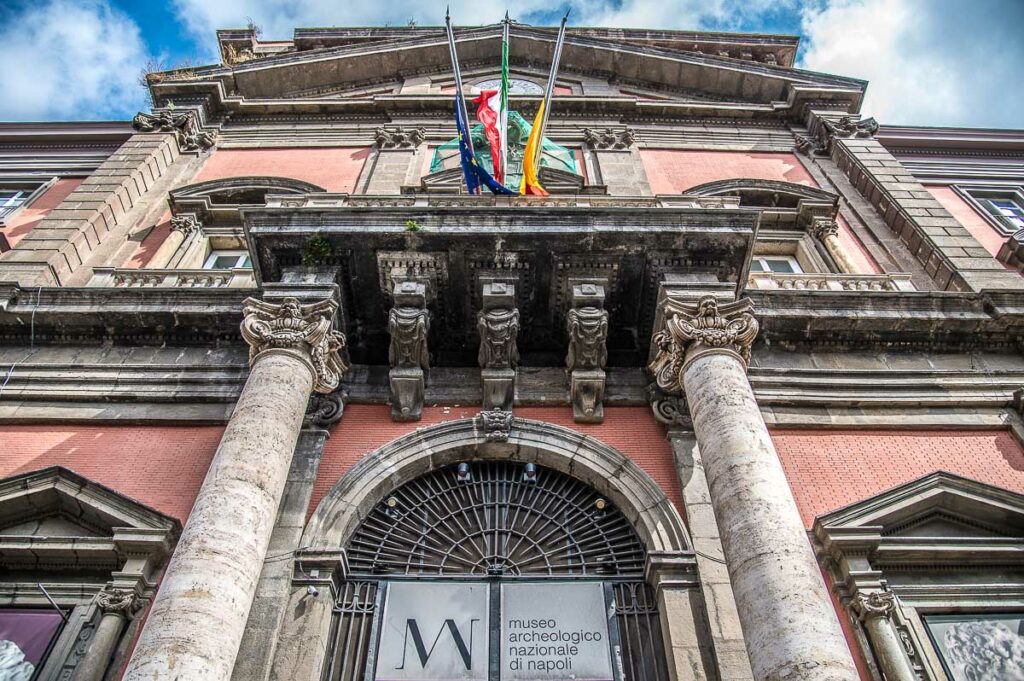
BEST MUSEUMS AND ART GALLERIES IN NAPLES

There are many exciting museums dotted all over Naples. In addition to MANN – National Archaeological Museum of Naples and the Royal Palace (see the entry above), here are five of the best among them:
Capodimonte Museum – built to house the renowned Farnese Collection of art, this former royal residence is surrounded by a lush park (originally, a hunting ground). Here you can see and enjoy an endless number of masterpieces by the likes of Botticelli, Titian, and Caravaggio as well as a number of renowned collections of art, porcelain, tapestries, and contemporary works.
Pio Monte della Misericordia Monumental Complex – run by a religious charity founded at the start of the 17th century, this is one of the must-see stops for lovers of art in Naples. It includes an octagonal chapel and a picture gallery housed in an elegant historic palace. Caravaggio’s famous painting ‘The Seven Acts of Charity’ was painted specifically for the chapel and it takes pride of place above its altar. Next door, you can browse a beautiful selection of Baroque and contemporary masterpieces and enjoy a lovely view of the Obelisk of San Gennaro and the dome of Naples’ Duomo.
Gallerie d’Italia – Napoli – I am partial to this group of art galleries which also has branches in the Italian cities of Milan , Vicenza , and Turin (you can see all their works of art on this link ). The permanent collection in Naples is eclectic and ranges from Attic and Magna Graecia pottery to works by Neapolitan, Italian, and foreign artists. This gives you a chance to explore the developments in art from ancient history to the 20th century. Caravaggio’s last painting ‘The Martyrdom of Saint Ursula’ is the crowning glory of this must-see art gallery in Naples.
N.B.: Calling all Caravaggio lovers! To learn more about the Neapolitan periods of the great Baroque master, have a look at this guided tour . It takes in the masterpieces and the places frequented in Naples by the painter of darkness and light.
Certosa e Museo di San Martino – this former Carthusian monastery nowadays functions as a museum complex with lush gardens. Here you can spend many stimulating moments looking at art used in all its forms to emphasise and decorate the impressive architecture. The charterhouse’s hilltop position opens splendid panoramic views of Naples and Mount Vesuvius. Next door, you can also explore the military fortress Castel Sant’Elmo .
Museo Madre – if by now you are feeling a bit overwhelmed by ancient ruins and Baroque splendour, a visit to Museo Madre and its excellent collection of contemporary art is just what you need to refresh your eyes and enrich even further your impressions of Naples.
BEST CHURCHES AND MONASTERIES IN NAPLES
Naples is dotted with countless churches, monasteries, and religious buildings. It’s not in vain after all that one of its monikers is the City of 500 Domes!
From the tiniest chapels to the imposing basilicas, Neapolitan churches guard priceless art repositories and unique local traditions. They are also an intrinsic part of the city’s architectural mosaic. Visiting them you can trace the development of building styles and decorative programmes from the Early Christian chapels nestled in the underground catacombs to the Gothic, Renaissance, and Baroque shrines and sanctuaries of Naples.
Here are some of the city’s must-see churches:
Duomo and Museum of the Treasure of San Gennaro – Naples’ cathedral has a millennial history and a cavernous body that incorporates two earlier churches built at the same site. One is the Church of Santa Restituta, allegedly founded in the 4th century by Constantine – the emperor who made Christianity the official religion of the Roman Empire. Nowadays, Naples’ Duomo preserves many priceless artefacts. Among them are the relics of San Gennaro or St. Januarius in English – the city’s main patron saint. It is here that the ritual of liquefying the saint’s blood takes place three times a year – an important event in the Neapoltan calendar (see the heading Events below). Next to the Duomo, don’t miss the Treasure of San Gennaro. Among the many exhibits here, you can see one of the most expensive pieces of jewellery in the world – the saint’s necklace.
Church of Ges ù Nuovo – this absolutely massive building was erected in 1470 as a princely palace. A century later it was sold to the Jesuit Order and converted into a church. Lavishly frescoed and ornamented in the Baroque style inside, its main point of interest is its unusual facade. This is made of piperno, a stone formed from volcanic magma, and fully covered by countless small pyramids. Unusual symbols are chiselled in some of these. Recently, it has been suggested that the symbols correspond to musical notes. When played, the resulting piece was, apparently, intended to attract good energy to the building.
Monastery of Santa Chiara – widely famous for its cloister decorated with lavish majolica tiles and Baroque frescoes, this monastery also has an onsite museum and guards the remnants of an ancient Roman bath. Its enormous Gothic basilica was almost completely destroyed during the Second World War (after Milan, Naples was the most bombarded Italian city) and then it was painstakingly restored to its former glory.
Museum Complex of Santa Maria delle Anime del Purgatorio ad Arco – this is one of the main centres of Naples’ curious cult of the souls in purgatory or anime pezzentelle in Italian. It consists of two churches. The decoration of the upper one explores the themes of death and salvation. The underground one is where many of Naples’ poor and destitute citizens were buried in the past. The locals, believing them to be stuck in purgatory, would come here to pray over their remains. This gave rise to the idea that the dead could serve as intermediaries between the living on Earth and the saints and God in heaven. So skulls were treated with special care and requests would be addressed to them.
N.B.: If you want to learn more about the cult of the anime pezzentelle , make sure that you also visit the Fontanelle Cemetery (due to re-open in 2024), the Monumental Complex of St. Anne of Lombardi, and the Church of Santa Luciella ai Librai.
Basilica of Santa Maria della Sanità – built over the Catacombs of San Gaudioso , this resplendent Neapolitan church is notable for its elevated altar and the double staircase that leads to it. Covered with bright majolica tiles, its large domes reflect beautifully the light, especially on a sunny day. If you book to see the catacombs (one of Naples’ best underground sights), the guide will tell you a bit about the church and the cult of San Vincenzo Ferrer – the patron saint of the quarter of Sanità and to whom the locals address prayers when they want to have a child.
Church of San Francesco di Paola – inspired by the Pantheon in Rome, this expansive Neapolitan church brims the city’s main square, Piazza del Plebescito , with its long colonnade. Built in the early 19th century in the Neoclassical style, it stands out with its portico and enormous central dome.
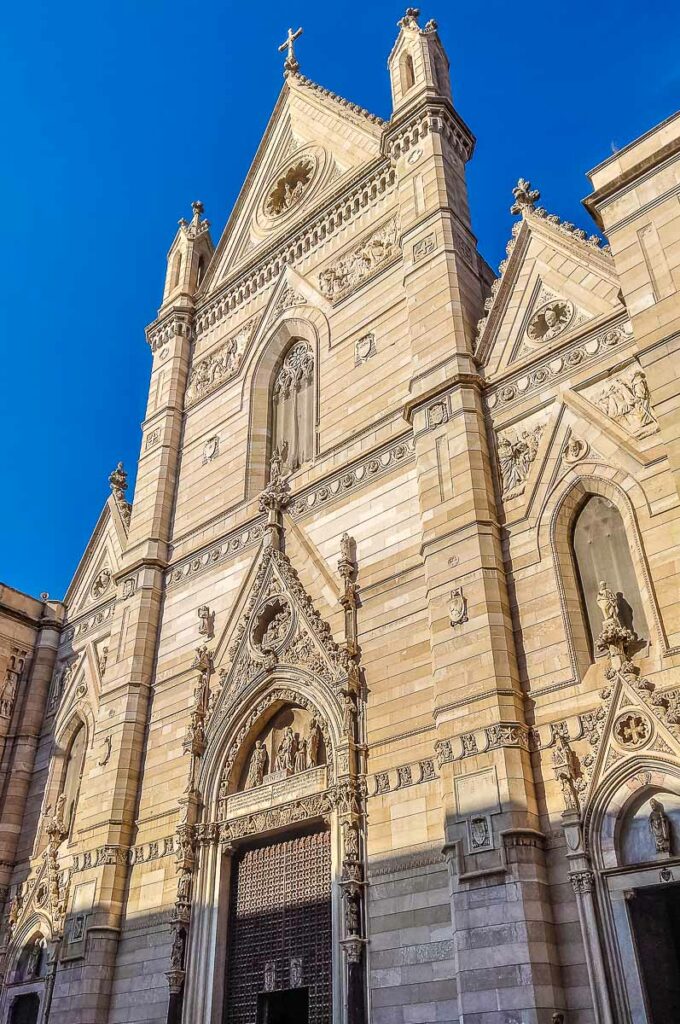
HIDDEN GEMS IN NAPLES
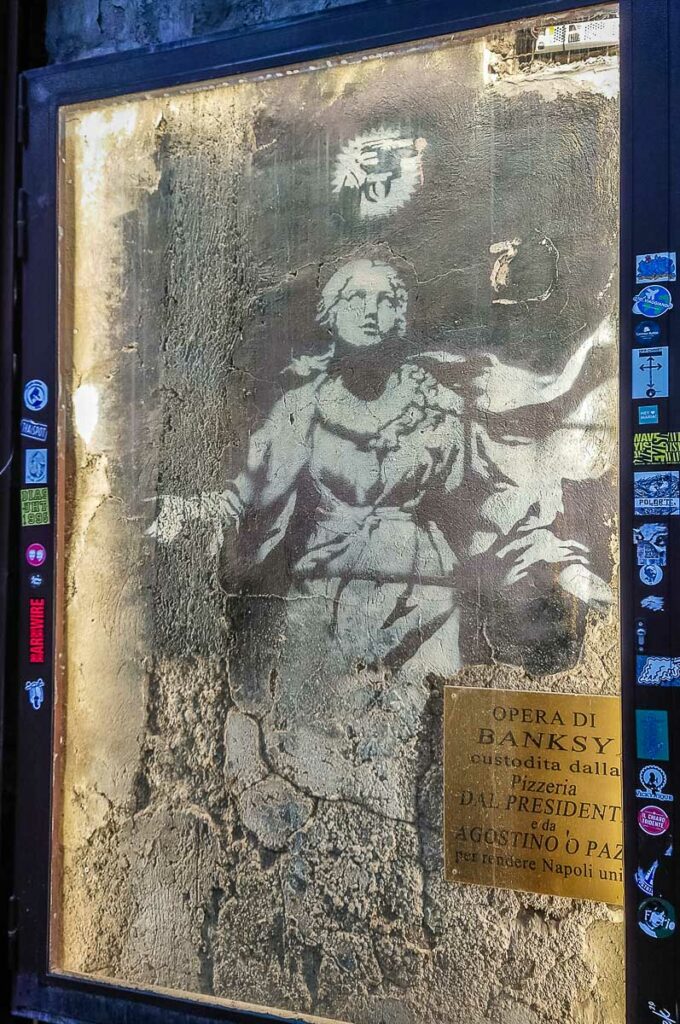
A city like Naples has a lot of secrets and hidden corners. Try to uncover as many of them as possible for a truly memorable trip. Make a note of the sights below and step off the beaten path.
Madonna con la Pistola by Banksy – up to 2019, this was the only documented mural by the artist in Italy. You can see it on Piazza dei Girolamini and it represents the Madonna with a gun where her halo should have been.
N.B.: Naples is a great place for street art. Everywhere you go, you will see murals and graffiti of differing quality adorning the facades of both historic and modern-day buildings. Keep an eye out for the graffiti of Trallalà – the moniker of the Naples-born artist Alfonso de Angelis. His fleshy ladies (known as ciaciona in Neapolitan) are particularly iconic.
Incurables’ Monumental Complex – come here to learn about the history of medicine in Naples and to visit the splendid Pharmacy of the Incurables, the Museum of the Sanitary Arts, the 16th-century cloister, and the medical garden.
Library and Monumental Complex of the Girolamini – a beautiful church with cloisters and a splendid historic library. From precious art to rare books, there is much to be seen and admired here far from the tourist crowds.
Monumental Complex of St. Anne of Lombardi – this 15th-century church preserves extraordinary works of art. In the sacristy, you can see the Sistine Chapel of Naples – an important fresco cycle by Giorgio Vasari, the Tuscan Renaissance painter and art historian. In the Crypt of the Abbots (or Hypogeum), you can learn about the Neapolitan scolatoi or draining holes where the bodies of the deceased underwent a somewhat gruesome and long procedure to liberate the bones from the flesh in an act which was believed to expiate the soul.
Naples’ Stairways – about 200 stairways and ramps connect the city’s flatter parts to its hilltop quarters. Following one of these inclined paths weaving past houses, churches, and monuments, is a great way to explore Naples and enjoy splendid panoramas of the urban sprawl and Mount Vesuvius. Among the stairways with the best views are the Pedamentina a San Martino , the Montesanto Stairs, and the Gradini del Petraio .
CATACOMBS AND UNDERGROUND SPACES IN NAPLES
Almost 3,000 years old, Naples is a city of layers. Many of these run deep under the streets and are keepers of marvellous stories that oscillate between the sacred and the macabre. Often within the same space below the surface.
Uncovering Naples’ underground secrets is a major portion of getting to know this one-of-a-kind city in Southern Italy. There is a bewildering number of underground tours and experiences for you to choose from. Here are some of the best:
Catacombs of San Gennaro and Catacombs of San Gaudioso – visiting these catacombs was my favourite experience in Naples. Both are accessible on the same ticket via guided tours. You will need to book your entry times in advance. I suggest that you head first to the Catacombs of San Gennaro on the far end of Rione Sanità (near the Capodimonte Museum and Park and next door to the imposing Basilica of the Crowned Mother of God). Here you will learn about the early Christian history of Naples and see prized frescoes and mosaics from the first millennium AD, as well as tombs chiselled directly in the volcanic tuff rocks. The focus of the guided visit to the Catacombs of San Gaudioso, on the other hand, is on the funeral ritual of scolatura . This was practised by Naples’ nobility and clergy of the 16th and 17th centuries and prescribed the draining of the bodies after death of all fluids in order to liberate the bones from the sinful flesh. Leave at least an hour between your visits to the two catacombs and explore Rione Sanità . If you can’t see both on the same day, your ticket for San Gaudioso is valid for 12 months after your visit to San Gennaro.
Napoli Sotterranea – Naples’ most popular underground tour. It takes in the city’s ancient water cisterns, the ruins of the ancient Roman theatre, stories from World War II, and even a recently planted underground garden. An exciting experience on many levels which culminates with a short walk down pitch-black narrow corridors to reach water pools with amphoras suspended above them. People suffering from claustrophobia can skip this part and wait for the rest of the group in a spacious underground chamber before continuing with the tour.
Bourbon Tunnel – built in 1853 and heavily used during the Second World War, this space below the surface of Naples has many stories to tell spanning four centuries. Especially photogenic are the abandoned cars and motorcycles that line up the tunnel. Next to them are stored statues from the fascist period.
Spanish Quarters Underground Guided Tour – winding tunnels will take you to the remains of the Neapolitan aqueduct deep beneath one of the city’s liveliest and most authentic quarters. From the ancient Greeks to the Second World War, you can trace Naples’ history as you walk along the dimly lit corridors.
San Lorenzo Maggiore and Neapolis Sotterrata – a wonderful journey through time that gives you a chance to trace Naples’ development from the 5th century BC to the 18th century AD both below and above ground. Here you can see the remains of a 1st-century AD Roman market, visit the imposing basilica where the 14th-century Renaissance humanist and writer Bocaccio met his muse Fiametta for the first time, and amble through historic halls decorated with splendid frescoes.
Basilica of Santa Maria Maggiore alla Pietrasanta and LAPIS Museum – this imposing 17th-century church stands at the spot of an early Christian basilica that was preceded by an ancient Roman temple dedicated to the goddess Diana. 35 m underneath it, you can visit Naples’ museum of water. Expect Greco-Roman cisterns and a submerged portion of the Roman Decumanus (the east-west oriented road that bisected the city in the past). Once you return to the surface, stop for a coffee in Diaz Microtorrefazione (one of Naples’ best coffee shops) in the shadow of the church’s 11th-century bell tower.
Church of Santa Luciella ai Librai – it’s easy to walk past this small church in the historic centre of Naples and not even suspect the stories and curiosities it keeps. The skull with ears takes the central place among them. They say that in the past, Neapolitan women would come to pray to it and whisper in its ears their innermost secrets and desires. The church’s crypt can be visited with a short guided tour. In the past, the funerary ritual of scolatura was practised here, too.
Underground Stations of Art – 15 stations along Line 1 and Line 6 of Naples Metro host over 200 works of art by 90 artists both from Italy and all around the world. Started in 1995, the project Stazione di Arte has produced some of the most beautiful metro stations in Europe with Stazione Toledo the receiver of many awards and accolades. Other metro stations worth a mention here are Università , Dante , Museo , Materdei , and Garibaldi . Even just travelling around the city of Naples is already an experience of art.
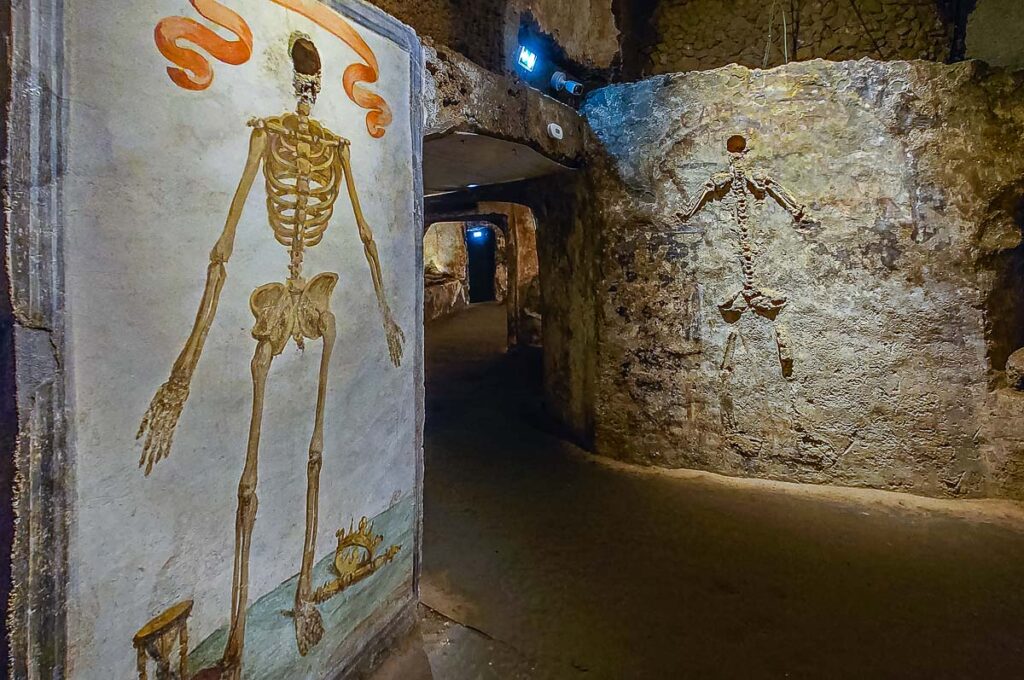
CURIOUS THINGS TO SPOT AROUND NAPLES
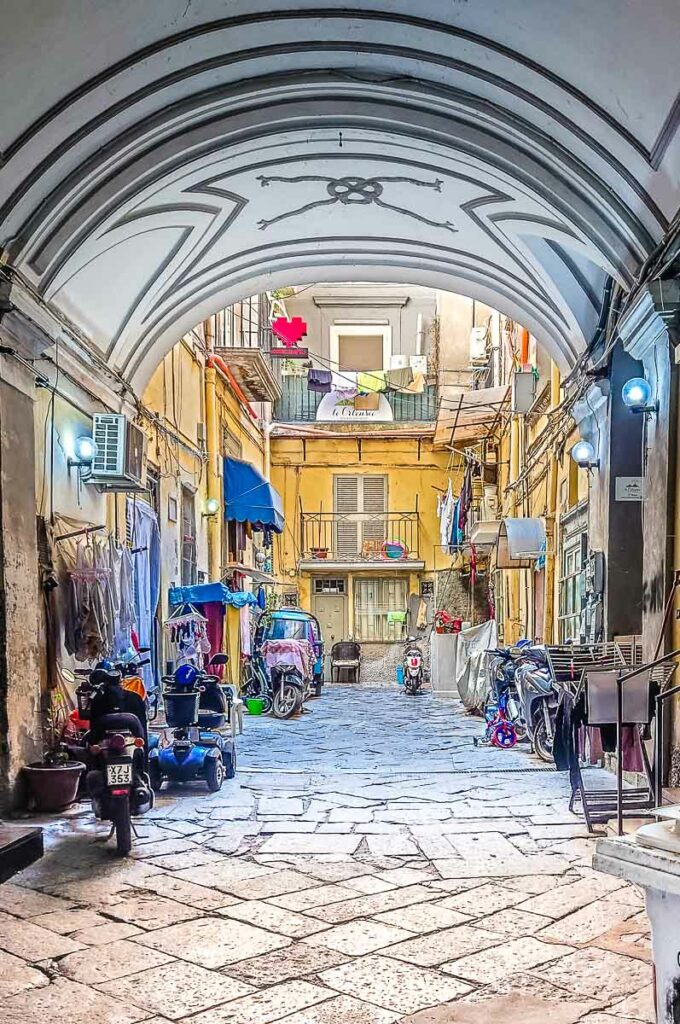
Here are five curious things that made an impression on me as I was exploring Naples with my family. You will come across them all around the city. They make it the lively, crazy, multilayered place that it is. I am mentioning them here to give you yet another angle (or angles) from which to approach Naples, experience its traditions, and capture truthfully its character.
Courtyards – a nucleus of authentic Neapolitan life, the courtyard is where you will find in no particular order parked cars and mopeds, rows of post boxes, the obligatory clotheslines, pots with plants, recycling bins with strict instructions on what to put in each, and so on. Providing an island of tranquillity in a densely built city, courtyards here are usually square or rectangular and flanked by balconies and rows of windows. Huge wooden gates block access to the courtyard from the street. These have a small door cut out in them to allow residents to walk in or out when the gates are closed.
Baskets – in a multi-storey city such as Naples, baskets come in handy when you don’t want to rush downstairs every time a delivery driver rings the bell. Instead, people drop a basket suspended by a cord from their balcony and then pull it up with the delivered item safely inside. Pure genius!
Mopeds/Scooters – these two-wheel vehicles are everywhere in the city. They are the main form of transport here, especially in the historic quarters. From teenagers to octogenarians, everyone rides them. Often, you can see a whole family with the baby and the dog on a single moped. You will quickly learn to jump out of the mopeds’ way, especially on the narrow historic streets with no pavements. Your head will be on a swivel at all times and you will subconsciously start to double up any walking time predicted by Google Maps, as by your first afternoon in Naples you will know that walking with a constant stream of mopeds right next to you is very time-consuming. Neapolitans seem to think that helmets are optional. I certainly don’t recommend not wearing one if you decide to brave the local traffic and ride around on a moped yourself.
Shrines – in Italian, they are known as edicole votive or edicole sacre . These are shrines attached to the walls of houses and buildings. You will see dozens of them as you walk around the city. A heartfelt expression of popular devotion, they vary in size and are decorated with religious images, candles, rosary beads, and plastic flowers.
Basso (pl. bassi )- also known as ‘o vascio in the Neapolitan language, these are small ground-floor flats with doors that open directly on the street. As you walk around town, your eyes will spontaneously look through the windows and the doors of many bassi giving you glimpses of real life. Some of these flats are so small that the marital bed stands right opposite the kitchen sink. In others, the occupants have reclaimed a corner of the street by fencing it off as a small verandah or placing large pots with plants to turn it into a personal garden. The family’s laundry flaps on freestanding driers placed directly on the pavement or on makeshift clotheslines. Some bassi have been turned into shops or workshops where you can buy bread or fresh fish or have your moped repaired if you need.
BEST PRESEPI IN NAPLES
A presepe (also known as presepio in Italian and a Nativity scene in English) is a figural representation of the Holy Family in the stables of Bethlehem. It is the focal point of festive decorations in Italian homes during the Christmas season. You can read more about presepi in this blog post:
- Presepe or 15 Facts about Italy’s Nativity Scenes – History, Traditions, and Meaning
Naples is Italy’s main centre of presepe -making. Handmade Neapolitan presepi are recognised for their beautifully carved and sculpted figurines, complex settings, and the introduction of folk characters, scenes of daily life, and even representations of modern-day celebrities in the Biblical Nativity scene.
A visit to Via San Gregorio Armeno is a must when you are in Naples. This is the street in the heart of the historic centre where you will find the largest concentration of presepe -making workshops. It’s Christmas all year round here.
As part of your sightseeing in Naples, don’t miss the following large-scale and very intricate presepi in the city:
Presepe Favoloso in the Basilica of Santa Maria della Sanità – this is my favourite Nativity scene in Naples. Four metres long and two metres high, it has over 100 figurines and it was made in 2021. The curious thing about it is that it incorporates figural representations of countless Neapolitan folk stories and contemporary happenings. As such, the Holy Family is surrounded by weird and wonderful characters that make you want to learn more about Naples’ myths and traditions. You can see this presepe as part of the guided tour of the Catacombs of San Gaudioso .
Cuciniello Nativity in the Museo Nazionale di San Martino – this large and complex presepe is composed of figurines of 173 people, 42 angels, and 80 animals (including two monkeys!). 450 miniature objects complete the scene.
Presepe del Banco di Napoli in the Capella Palatina of the Royal Palace – this lavish Nativity scene is composed of 354 pieces dating to the end of the 18th and the beginning of the 19th centuries. All of them were designed and handmade by famous artists of the time, for example, Giuseppe Sanmartino, the sculptor of Naples’ most famous statue – the Veiled Christ.
Presepe by Fratelli Capuano in their bottega on Via San Gregorio Armeno – this Nativity scene was made in 2006 by the artisans of one of Naples’ most renowned presepe -making workshops. In the style of an 18th-century Neapolitan presepe , it is incredibly detailed and expansive in size. There is a nominal charge of one euro to see this presepe .
Sala del Presepe in the Monastery of Santa Chiara – this large-scale Nativity scene is composed of 18th-century pieces commissioned during the reign of Ferdinand IV. The king himself was a big fan of presepi
Don’t worry if you don’t manage to see exactly these five Neapolitan presepi . Large-scale Nativity scenes are installed all over Naples, especially in the local churches. The best time of the year to see them is obviously around Christmas but they add a touch of whimsicality and wonder to your memories of this Italian city no matter the season.
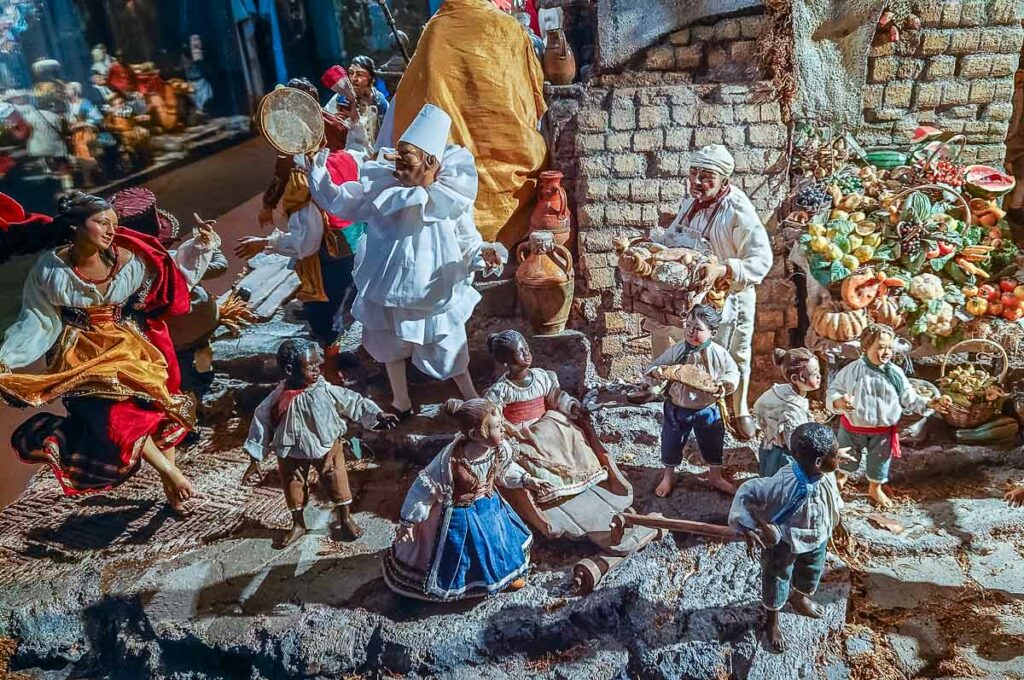
EVENTS IN NAPLES
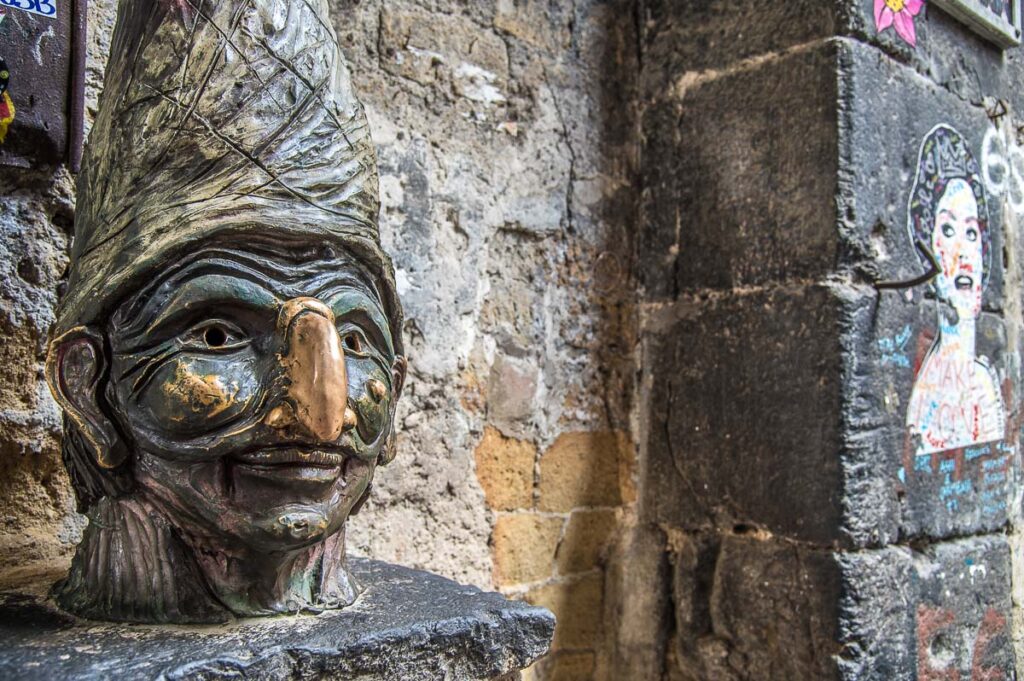
Naples has a rich calendar of events. From art exhibitions and religious festivals to culinary get-togethers (called sagra ) and street celebrations, there is always something fun and exciting to do in the largest Southern Italian city.
Here are some of the most important events in Naples to enjoy together with napoletani :
January – 6th January or Epiphany is the day of Befana, an old long-nosed lady who rides around on a broom. As one of Italy’s five Christmas gift-bearers, she brings presents to the well-behaved Italian kids. What do the naughty ones get instead? Find out here . On 17th January, Naples celebrates the day of St. Anthony the Abbot, the protector of animals, with traditional bonfires.
January/February – travel to Naples for Carnevale . This is a period of confetti, costumes, music, and fun in the city. It’s also an opportunity to spot a Pulcinella or two out and about in the historic quarters. With a black mask with a protruding nose, this is the commedia dell’arte character who hails from Naples. In English, he is also known as Punchinello and originated the British puppet character Punch (as in Punch and Judy).
N.B.: If you can’t make it to Naples specifically for Carnival, then head to Vico del Fico al Purgatorio , a dark portico right off Via dei Tribunali , at any other time of the year. Here you can see the famous bronze bust of Pulcinella by the local artist Lello Esposito. Tourists touch the bust’s nose for good luck which explains its shiny surface.
March/April – Easter is one of the major celebrations in the Neapolitan calendar. Spend the Holy Week here and immerse yourself in centuries-old religious rites and popular traditions. For example, the sepolcri and the giro delle sette chiese . The sepolcri are specially decorated altars or chapels in Naples’ churches. The giro comprises visiting seven churches to pray for benevolence. Tuck into local festive dishes such as zuppa di cozze (mussel soup eaten on Holy Thursday) and pastiera (a shortcrust pie filled with ricotta-based cream).
April – twice a year (on the 5th of April and on the first Tuesday of July) the historic quarter Rione Sanità celebrates its patron saint, the Spanish Dominican friar Vincenzo Ferrer. Known as O’Munacone – the Big Monk – it is believed that the cholera epidemics that decimated Naples in 1836 only ended after the saint’s statue was carried along the quarter’s streets.
N.B.: You can see the shrine of San Vincenzo in the Basilica of Santa Maria della Sanità. The locals pray to the saint when they want to have a child.
April/May (then Septembe r and December ) – Naples’ major celebration takes place three times per year: the Saturday preceding the first Sunday of the month of May, then the 19th of September, and the 16th of December. This is when napoletani flock to the city’s Duomo and pray for the Miracle of Liquefaction. The blood of Naples’ patron saint San Gennaro was collected in a glass vial after he had been beheaded during the persecutions of the Christians spearheaded by the Roman emperor Diocletian. Over the centuries, the blood dried and turned solid. However, on these particular dates, it becomes liquid again after a complex ceremony performed in front of the people of Naples. A successful liquefaction of the saint’s blood is a sign of forthcoming prosperity. A failure to liquefy is interpreted as misfortunes to befall Naples and the world in the months to follow.
September – visit Naples around the 8th of September for the annual Feast of the Madonna of Piedigrotta. Expect float parades, firework displays, and concerts.
December – the Christmas season is especially heartfelt in Naples. Head to Via San Gregorio Armeno to immerse yourself in the festive hubbub of shoppers seeking new pieces for their presepi . Visit the city’s churches to see their intricate Nativity scenes. Enjoy traditional Christmas desserts such as struffoli (fried balls of sweet dough covered with hot honey and colourful sprinkles) and roccocò biscuits.
NAPLES WITH KIDS
Is Naples a good place to visit with kids? This is a very valid question considering the city’s incredibly busy historic centre, the obvious social contrasts, and the large number of sights and museums where one can spend many hours walking around to full exhaustion.
My personal opinion is that Naples is a great place to visit with kids who are eager to learn new things, who love to eat, and who have vivid imaginations. Also, kids who don’t mind walking around for long stretches of time and who love exploring new places and cultures.
Here are a handful of places and sights which you may enjoy visiting particularly with your kids in Naples:
Aquarium of Naples – this is the oldest aquarium in Italy. It was opened in 1874 by the German Darwinist Anton Dohrn. Two years before that he had founded the world’s first zoological research station in Naples. The aquarium is housed in Villa Comunale – an important historic garden in the quarter of Chiaia. It has 200 animal and plant species in 19 basins and represents nine different habitats of the Mediterranean Sea. Near the aquarium, you can also visit the Museum Darwin-Dohrn .
Botanical Garden of Naples – this verdant oasis is a pleasure to visit with the family, especially on a hot day.
Ospedale delle Bambole – this Dolls’ Hospital is a very whimsical place in the heart of Naples. It first opened its doors in the 19th century and since then it has been run by four generations of the same family. It specialises in the repair of antique dolls and it has a small museum.
Città della Scienza – right next door to Naples you can visit Italy’s first interactive museum dedicated to the different branches of the sciences. A fun and educational destination for the whole family.
Below you can read my 10-year-old child’s honest opinion about visiting Naples in Italy:
Naples is a busy and lively city. With the noise, tight roads, and scooters, it gives you an air of happiness. But it is also very warm and within five days your feet can start hurting within five minutes of walking.
Children might enjoy the Napoli Sotterranea guided tour because of the dark and tight passages and the underground pools of water. One part of this tour includes something that you wouldn’t imagine being in an ordinary house but I won’t give any spoilers. (Especially as it’s underneath the bed!)
I also enjoyed seeing the Nativity scenes, especially the moving ones. Naples’ amulets – cornicelli – were everywhere.
The veiled statues made me feel a bit sad but you must visit not just the Veiled Christ in the Sansevero Chapel but also the Veiled Son (see the heading 5 Curious Facts About Naples below to find out why). In the Sansevero Chapel, you will also find a statue with an impressive fishing net around it.
I really liked Naples’ tight little streets and the way the delivery system works with baskets tied on ropes. You will find out soon enough!
Be warned! Maradona is everywhere! But I liked the fact that Naples’ colour is light blue (my favourite colour).
If you go to Herculaneum, there is a house which I liked. It has orange and red walls, which I describe as tropical. There are also some ancient Roman snack bars, but if you get hungry you can get an ice cream or a snack from the vending machines by the ruins. I liked walking around, looking into the ancient houses and naming them. Herculaneum is the perfect size to explore with kids and they even have cats who live there. I saw two of them – Ciuccio and Ercolina.
In Naples, you must go to the best ragù restaurant in the world – Tandem. And also you obviously have to taste gelato and pizza. A pizzeria to have in mind is the Pizzeria del Purgatorio. The sfogliatella riccia is quite difficult to bite, so watch it! Another thing to try are the Neapolitan taralli.
Let me tell you one thing! In Naples, they not only have granita (similar to slush puppy) but they even have watermelon and melon flavours. They are delicious!
The combination of hot, blazing sun and a full belly is not good. In this case, I suggest that you follow the Italian tradition of afternoon nap which is called riposo .
I would definitely return to Naples! I am happy that I got a Neapolitan cornicello , a fridge magnet, and some pieces for a Neapolitan Nativity scene. Naples is worth it! Especially for the food.
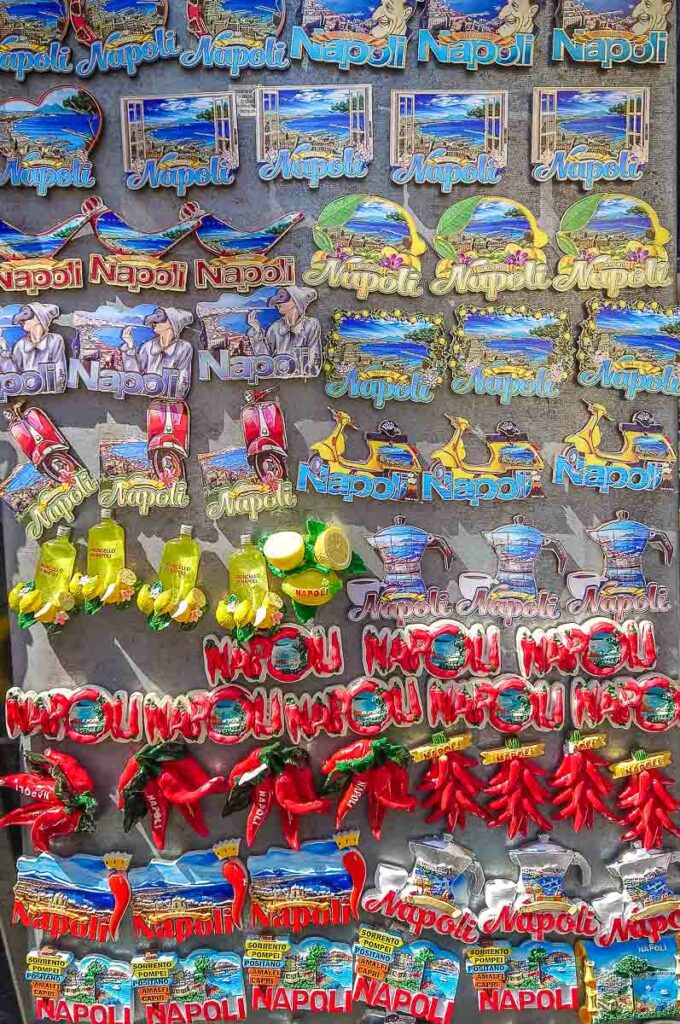
BEST ORGANISED TOURS IN NAPLES
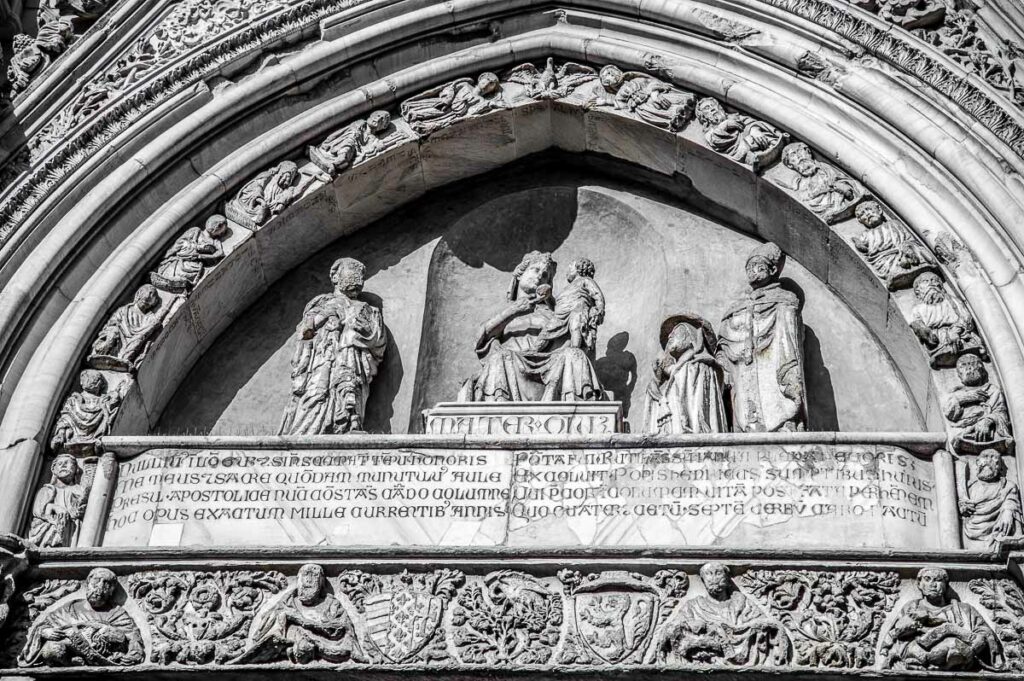
Booking an organised tour in Naples with a reputed tour guide or travel company is a shortcut to getting to know on many different levels this vibrant, stimulating, and often overwhelming city. It’s like stepping through a secret door to discover Naples’ best corners and hidden gems which otherwise may be difficult to come across one by one on your own.
With a millennial history, a rich catalogue of art, delicious local food, and many traditional crafts with outstanding output, Naples is a must-see city in Italy. This is a place that keeps many secrets that it reveals to only those in the know. No matter how many books or guidebooks you may read about Naples before coming here, the City of Pizza, Volcanoes, and Nativity Scenes can still be a shock to the system. You may find yourself ambling through its ancient streets unsure where to head to first and what to delve into next.
It is at this point that an expert local guide or a reputable tour company can be of great help. With a structured approach and offering tours covering specific fields of knowledge or tailored to your personal interests, you can see and experience the maximum of Naples within the shortest amount of time.
Here are some of the best and most highly recommended tours to take in Naples organised by category:
- Sightseeing: Hop-on Hop-off Bus ; Walking Tour with Underground Ruins ; Walking Tour with the Most Famous Monuments
- History: Pompeii with an Archaeologist ; Pompeii and Mount Vesuvius ; Pompeii and Herculaneum
- Food: Street Food Tour ; Do Eat Better Experience ; Secret Food Tour
Alternatively, select directly local tours and activities in Naples on GetYourGuide , Viator , and Tiqets .
Even if you decide against booking a tour and then you change your mind at the last moment, don’t worry! Tour guides can be hired in situ in many museums and sights in Naples. For example, when you visit Herculaneum, you will see the tour guides’ desk next to the entrance.
BEST VISITOR PASSES FOR NAPLES AND CAMPANIA
There are several visitor passes for the city of Naples and the region of Campania in Italy. In general, they cover a period of one, three, or seven days and provide free and discounted access to the best and most popular sights and museums here. Most of them also include free transport either as an included perk or as an add-on option.
The most popular visitor passes for Naples and Campania are issued by the following companies:
Campania ArteCard
Naples Pass
Both offer different options in terms of pass duration and number of free sights covered by each pass. So browsing their websites and choosing the right card for you is worth the time.
On Tiqets you can also find visitor passes just for Vesuvius and Pompeii, too.
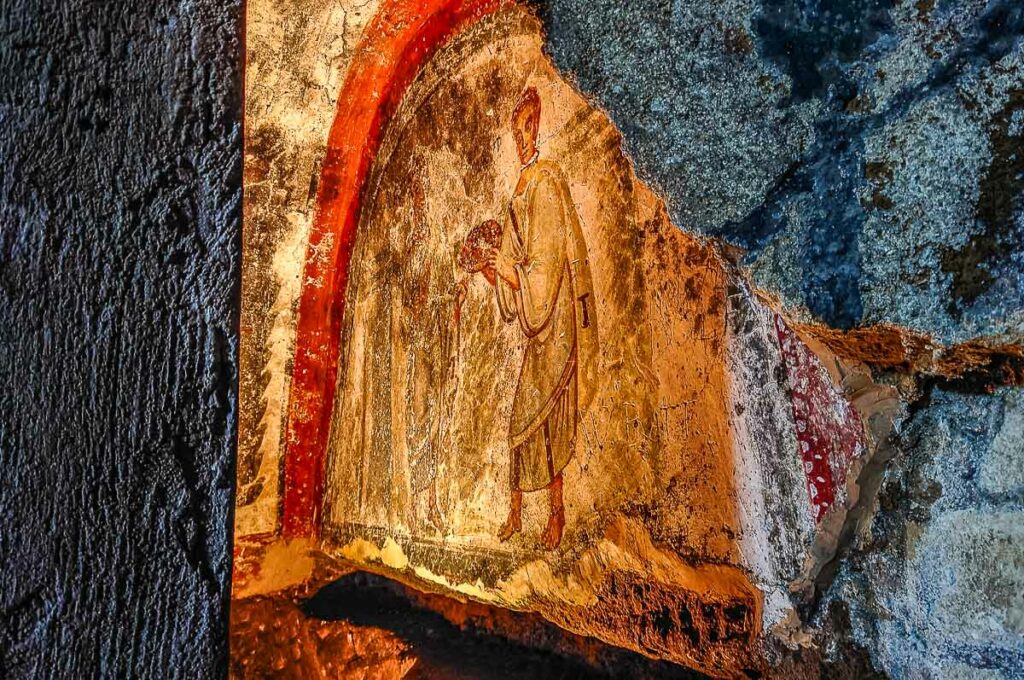
We purchased the three-day Campania Artecard as we wanted to be able to use it on our day trip to the Phlegraean Fields, too. In my personal experience, the card was useful but it had some shortcomings.
Only the seven-day card is physical. The others are virtual. You have to download an app on your phone which provides you with special QR codes to scan every time you use public transport or visit a sight. This meant that we needed to make sure that we had enough battery left at all times and that the internet was working wherever we were.
Often, the QR code wouldn’t scan easily, especially at the train stations, so we had to go find someone to let us in through the barrier. In the process, we would get approached by small-time crooks offering to open the barrier for us in exchange for a small tip.
As far as we understood, children travel for free on the parent’s card if they are under a meter tall. As our child is over a meter, we needed to go buy tickets for her with all the queuing this entailed. I would have loved to be able to pay a bit more for the card but to have my child’s travel on it or simply to have the option to buy a child’s card from the get-go.
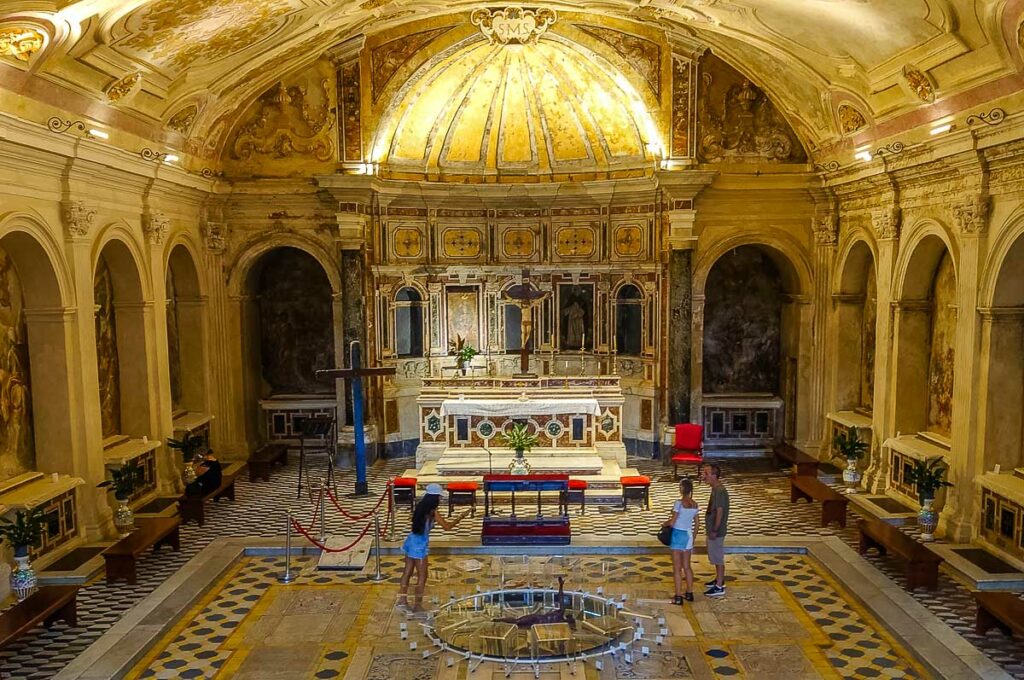
Another thing to have in mind is that the card seems to cover a specific number of days and not a specific number of hours. In other words, no matter how early or how late in the day you activate it, it counts the day of activation as a full day.
Otherwise, the card is handy as it saves you quite a lot of money. Especially, if you plan your visits in such a way that you head to the most expensive sights first. It also allows you to jump the queues at museums and sights which is a great timesaver. The app has a lot of excellent information about the sights and landmarks to see in Naples. This can give you lots of ideas for places to explore which makes your stay in Naples even more exciting.
BEST DAY TRIPS FROM NAPLES
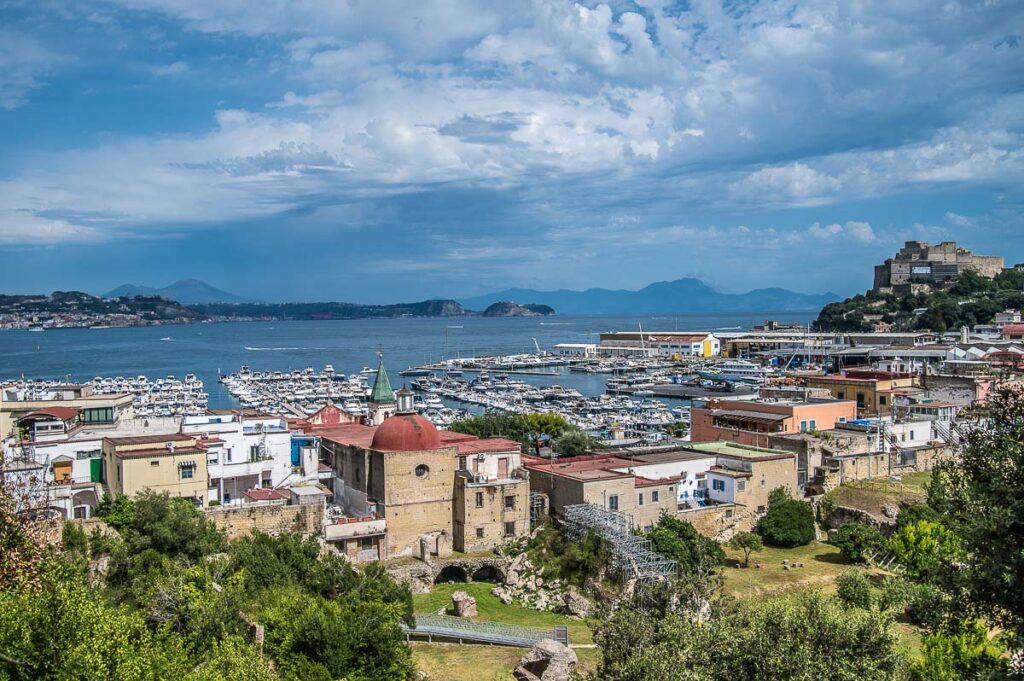
For everything that Naples has to offer, right next door to this vibrant Italian city you will also find an almost overwhelming number of must-see destinations. No matter what you are after – ancient ruins, picturesque towns, coastal villages, diving trips, natural beauty or panoramic views – take your pick from this list:
Ancient Roman Cities and Landmarks – Herculaneum and Pompeii don’t really need an introduction. Destroyed by the eruption of Mount Vesuvius in 79 AD, today the excavations of these two ancient Roman towns are a must-see if you love history and archaeology. If you have time to spare, don’t miss the Virtual Archaeological Museum of Herculaneum and Boscoreale , Oplontis , and Stabiae in the vicinity of Pompeii. Take the Circumvesuviana train and you can easily get from Naples to all of these ancient Roman hotspots by yourself. Alternatively, you can also book this highly recommended day tour which takes in Pompeii and Mount Vesuvius. If you have little time to spare, then this two-hour visit to Herculaneum in the company of an archaeologist is a great option to consider.
Phlegraean Fields ( Campi Flegrei ) – a truly exciting yet little-visited by mass tourists area right next to Naples. Here you will find small towns with fresh seafood, impressive ruins, and volcanic heritage. From the enormous Flavian Amphitheatre and the ancient Roman macellum in Pozzuoli to the Archaeological Park of Cuma and the Piscina Mirabilis in Miseno, this is the best day trip from Naples you have never heard of. I particularly loved the Roman baths in Baiae. The sea here guards the remains of once lavish Roman villas. Protected as part of the Submerged Archaeological Park of Baia, they can be seen as part of a diving or snorkelling trip.
N.B.: If little-known historic sites are your thing, then make sure that you also head to the Archaeological Site of Pausilypon halfway between Naples and the Phlegraean Fields. You can read more about it here .
Islands near Naples: a handful of beautiful islands are a short ferry ride away from Naples. The most famous one of them all is Capri but if you have the time, don’t miss Ischia and Procida. Check ferry timetables and ticket prices at the official websites of the ferry operators SNAV , Caremar , and Medmar . Don’t forget to book a boat tour of Capri in advance for maximum fun during your time on the island.
Amalfi Coast ( Costiera Amalfitana ) – this beautiful stretch of coastline along the Gulf of Salerno is dotted with small towns that are the essence of picture-perfect Italy. Amalfi, Positano and Ravello are the most famous among them and every high season suffer the effects of overtourism. Head there in the low season to avoid the crowds and for a more authentic experience. To simplify your travel arrangements, you can also book an organised day tour . Alternatively, make a plan to discover for yourself the lesser-known corners of the Costiera Amalfitana , for example, Vietri sul Mare and Atrani.
Other destinations to visit from Naples – here in no particular order but all deserving a day trip (or a longer stay) are some more must-see places for you to easily explore coming from Naples: Royal Palace of Caserta , Archaeological Park of Paestum and Velia , and the towns of Sorrento, Benevento, and Gaeta. If you have little time but you want to see the most, then you can book an organised tour taking in Sorrento and the highlights of the Amalfi Coast.
IS NAPLES SAFE?
The question ‘Is Naples safe?’ surely is one of the first things that pop into the mind of any traveller considering a visit to Naples in Italy.
For decades, books, films, and news stories have all presented this vibrant city as a beautiful yet decaying place where danger lurks around every corner. Speaking truthfully, Naples definitely is an edgy city. The consequences of limited financial means are easy to stumble upon even right next to major landmarks. Some areas here seem to experience real penury.
On the plus side, however, I felt that Naples is a friendly city where it was immensely enjoyable to walk around and talking to people felt natural and easy.
Some time ago I used to live in Northern Italy which I got to explore in depth. Yet, I always felt like an outsider and even in the city that my family called home for six years – Vicenza – there were people who refused to talk to me on account that I was a foreigner and others who kept me at arm’s length and took obvious offence to the fact that I would speak to my own child in my mother tongue instead of Italian.
In contrast to this, Naples felt easy to slot into. While I was situationally aware at all times, this didn’t interfere with my feeling relaxed, happy to explore, and at ease to talk to people. We all have been fed with cliches about Italy and some of us may have been left disappointed when some of these cliches didn’t live up to reality. Naples for me lived up to some of the best expectations people may have of Italy – friendliness, ease of communication, and the strive to create beauty in any and all circumstances. It’s a shame that this striking in so many ways city has been experiencing financial deprivation over such a long period of time. This, obviously, has left a deep imprint on its fabric!
The friend of a friend who met us at Naples Airport gave us some safety advice which I found applicable to any other large, lively city in the world. For example, no flashy jewellery, expensive watches, or branded accessories (which was easy for me as I don’t wear any jewellery when I travel), sticking together after dark (we are a family of two parents and a small child, so we tend to stick together when we walk around), and not exploring deserted areas at night (this we don’t do in principle).
Depending on where you come from and what urban environment you may be used to, what you may find unsettling in Naples at first glance are the quantities of rubbish towards the end of the day, the proliferation of graffiti (some of them are rather good), and (in some corners of the city) the obvious signs of people living rough. This is not exclusive to Naples. I live in a rather economically deprived town in England, so locally we have some of these issues affecting the community at large, too.
Before travelling to Naples, I didn’t know what to expect and I had seen all the negative reviews online. I am glad to report that I found Naples a joy to explore. It was stimulating on so many levels and offered such a rich list of things to do that I felt I could return to this city time and time again to get to know it better. Naples is full of life and this was such a wondrous thing to see and experience.
Safety is always a concern when travelling. I am speaking as the almost victim of a violent mugging in a public place in a large European city (not in Italy!), so you can be sure that when I am in a new place, especially with my child and my camera around my neck, I have my head on a swivel.
Naples is a city of great contrasts. Poverty is not conveniently hidden away here. You can see that survival is tough for many people. Beauty and decay occupy the same spaces. So, if you want to spend your holidays in a highly presentable and polished environment, then maybe Naples is not your destination. If, on the contrary, you are looking to see a place that has nurtured life in all its manifestations – from the creative to the destructive – for close to three millennia, then Naples is an excellent choice to consider.
As in all other places, be travel-smart. Keep your belongings close to you, be aware of your surroundings, in control of your abilities, and don’t engage in conversations with overly friendly people who approach you first. They are running a small-time scam where they give you some information and then ask for a tip. And, if you need a good list with lots of common-sense safety tips applicable to all destinations, have a look at this article on my blog.
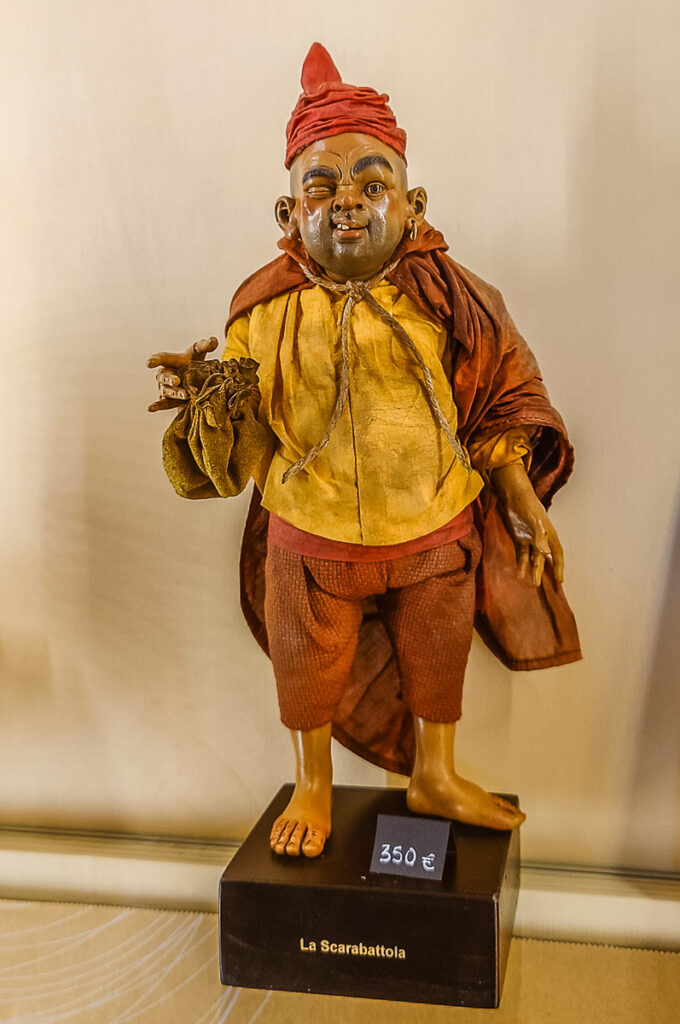
BEST TRAVEL GUIDES FOR NAPLES

WHAT TO BUY FOR NAPLES

WHAT TO BUY IN NAPLES
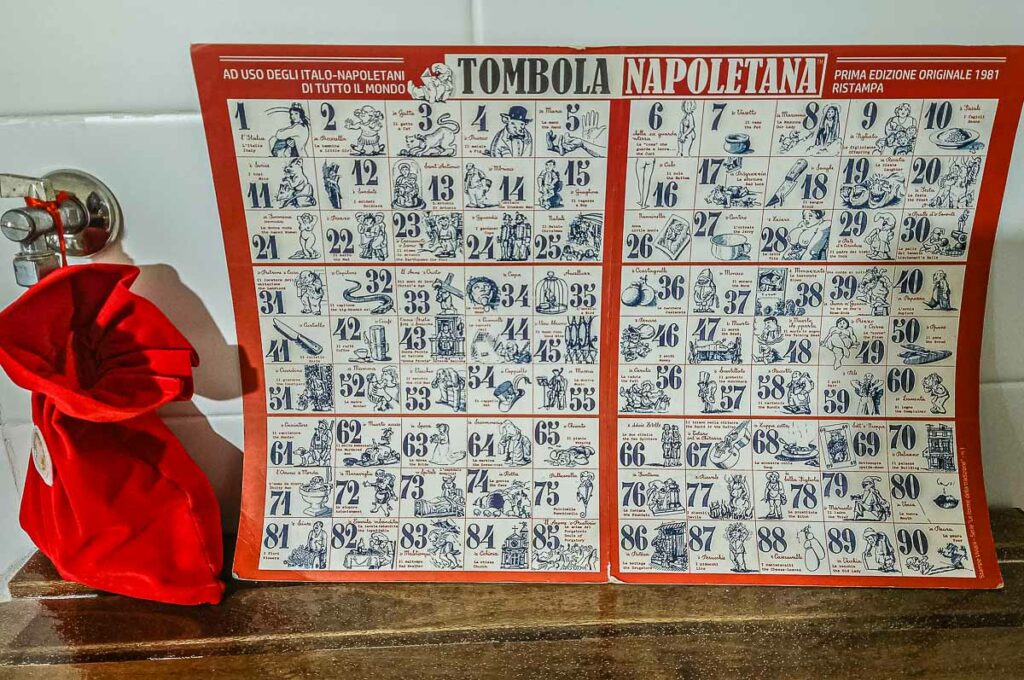
Shopping in Naples is an exciting experience on many levels. From artisan products and luxury goods to treat yourself to heaps of imaginative and colourful souvenirs to take home for family and friends, you will be tempted to spend, spend, spend time and time again.
Artfully arranged shelves and windows tempt you with handmade Nativity scenes , hand-painted Neapolitan tambourines, beautiful ceramics, hand-carved cameos , antique books, and so many more weird and wonderful, unusual and eclectic, rare and irresistible things.
Prices accommodate every budget! So, here are some cool things to buy in Naples and some of the best local makers to purchase them from:
Handmade Neapolitan Nativity scenes from Fratelli Capuano , La Scarabatola , and the shops along Via San Gregorio Armeno . Handmade Nativity scenes (known as presepe or presepio in Italian) are an intrinsic part of Naples’ artisan heritage.
Corno portafortuna (also known as cornicell o ) – you will see these chilly-like horns all around Naples. Traditionally red, nowadays they come in all sizes, colours, and variations. The locals believe that this Neapolitan amulet protects you and brings you good luck. For it to work, however, it needs to be handmade and given to you as a present. Apparently, you can’t just buy your own! D’Auria Artigiani make a large selection of cornicelli . Otherwise, you will find these amulets all over Naples.
Cameos by Gerolomini Gallery – this elegant shop has a wide selection of beautiful handmade cameos and coral jewellery. It also has a small museum dedicated to the delicate art of cameo-carving which is typical for the area around Naples.
Handmade bags and purses by Jiji Lovemade – I fell in love with Jiji’s colourful, vibrant bags during my week in Naples this summer. With beautiful patterns, they are both practical and elegant, perfect for city living and weekend travel.
Neapolitan tombola – a cheeky lotto-like game that Neapolitan families play together, especially at Christmas. Many small shops along Spaccanapoli and Via San Gregorio Armeno sell it.
Artisanal chocolate by Gay-Odin – this over a century-old Neapolitan company makes high-quality chocolates and chocolate-based products.
Cucumella – this traditional Neapolitan flip pot produces smooth and strong coffee. With its elongated design, it is a great conversation starter and is a great gift for the coffee lover in your life.
BEST BOOKS ABOUT NAPLES

5 CURIOUS FACTS ABOUT NAPLES
1. Naples has 52 patron saints – one for each week of the year. The city’s main patron saint is San Gennaro with whom napoletani signed a notarised contract on 13th January 1527 stipulating that the saint was to protect them from plagues and eruptions of Vesuvius.
2. In Naples, you can see not just the worldwide famous sculpture of the Veiled Christ , but also the sculpture of the Veiled Son. Both are carved from a single block of marble and the latter is the work of Jago – an Italian sculptor currently residing in New York. The Veiled Christ is in the Sansevero Chapel. The Veiled Son is in the Basilica of San Severo fuori le Mura. Both are a must-see!
3. Via di San Gregorio Armeno (also known as Via dei Presepi ) is Naples’ famous street that houses the workshops of the artisans who make the famous Neapolitan presepi . These intricate Nativity scenes include dozens of figurines and represent the Holy Family in the stables often surrounded by purely Neapolitan characters and settings. Curiously, millennia ago, this same street was lined with workshops producing terracotta figurines which people bought and left as votive offerings at the adjacent temple of Ceres – the Roman goddess of agriculture.
4. Naples’ historic city centre is one of the largest in Europe. Its many layers – from the deepest catacombs and underground water cisterns to its tall obelisks and church domes covered with majolica tiles – are the result of 27 centuries of history. Its surface encloses 1,700 hectares, 1,021 of which were declared a UNESCO World Heritage Site in 1995!
5. Napoletani are football-mad and are particularly obsessed with Maradona. Hailing from Argentina, the legendary footballer played for S.S.C. Napoli from 1984 to 1991 and took the Neapolitan team to the top of the game. To this day, Maradona has a god-like status in the city. Everywhere you go you will see his face on flags, murals, and even packets of crisps.
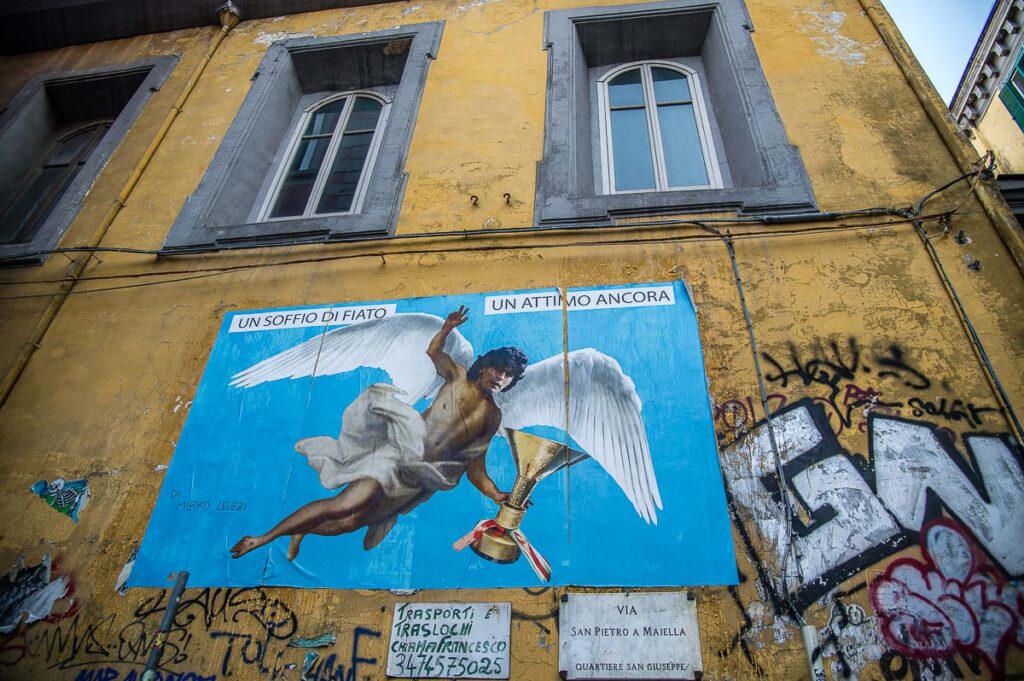
MY TOP 5 TIPS FOR NAPLES
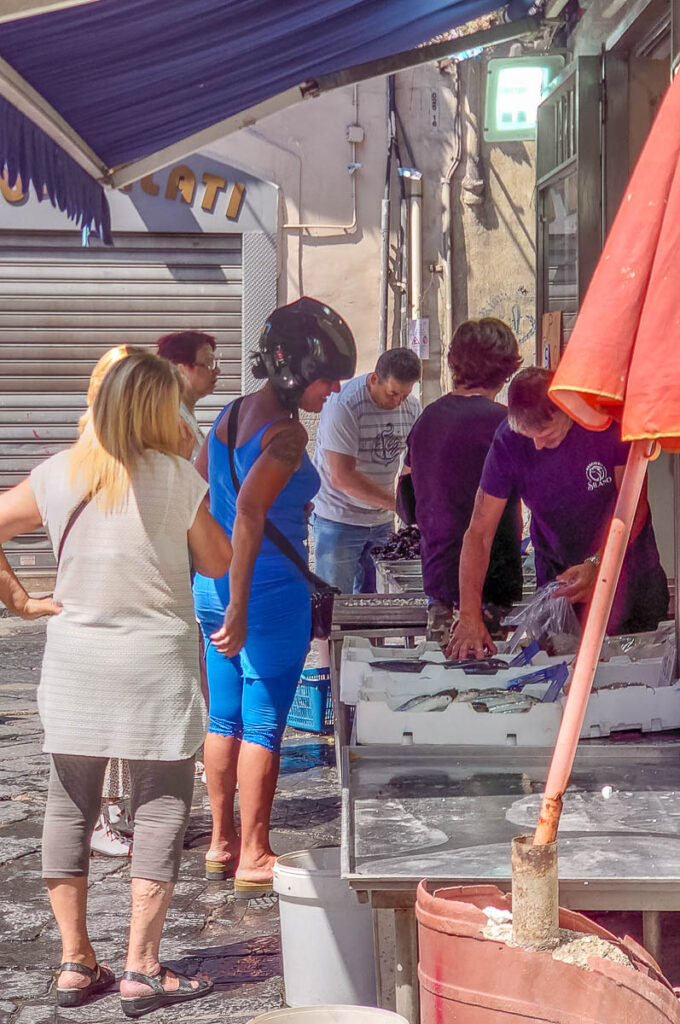
- Explore Naples area by area. This is a large and exciting city with lots to see and do. Group the sights you want to visit based on their proximity to one another instead of exhausting yourself by running all over town every day of your stay.
- Where possible, book entry tickets and tours in advance. This will minimise waiting times and will allow you to make the most of your day. Tiqets is a great resource for tickets for Naples’ best museums and landmarks. Viator is my favourite tool for booking guided tours.
- Bring your appetite. Naples is a city where eating is akin to an elevated cultural experience. From bakeries and family-run trattorias to restaurants with sea views and unmissable gelaterias, Naples runs on excellent food. Don’t skip a meal!
- Embrace Naples’ joy of life! This is a vibrant city that stimulates the senses on many different levels. Let it get under your skin!
- Indulge in people-watching. Naples is as much about its historic and artistic heritage as it is about its people. Take time every day to just stop and take in little scenes of daily life. Many napoletani are worthy of a book and you can read their story on their faces, in their gestures, and in a conversation with them.
5 THINGS NOT TO DO IN NAPLES
- Don’t expect to see the whole of Naples in a day or two. This is a large city with lots of major sights and plenty of hidden gems.
- Don’t hire a car. Traffic in Naples is intense, the driving style is incredibly assertive, and the historic quarters are akin to mazes of narrow streets. Free parking spaces can be very difficult to come across, so parking needs to be organised in advance. Most importantly, Naples has several ZTL’s (limited traffic zones) which are accessible only with special dispensations (for example, local residents and hotel guests) and more or less cover the areas with the biggest concentrations of landmarks and sights.
- Don’t buy counterfeit luxury and designer goods . Heavy fines are in place for tourists tempted to buy knock-offs which you may see being sold from sheets spread directly on the ground around town.
- Don’t be negative about Naples and/or its icons. As with every large city with a millennial history, Naples has its own specific problems which are easy to spot. The least a visitor to the city can do is to show respect to the people who have to deal with them on a day-to-day basis. Neapolitans have also elevated certain personalities to a god-like status. Disrespect is not tolerated no matter how well-based your opinion about them may be.
- Don’t accept unsolicited offers for help. Most often than not they will be followed by a request for a tip. At busy spots around town, for example, train or metro stations, you may be approached by a smiley person eager to explain how to get from point A to point B. Don’t engage! If you really need directions, it’s best to ask at the ticket office or a uniformed employee.
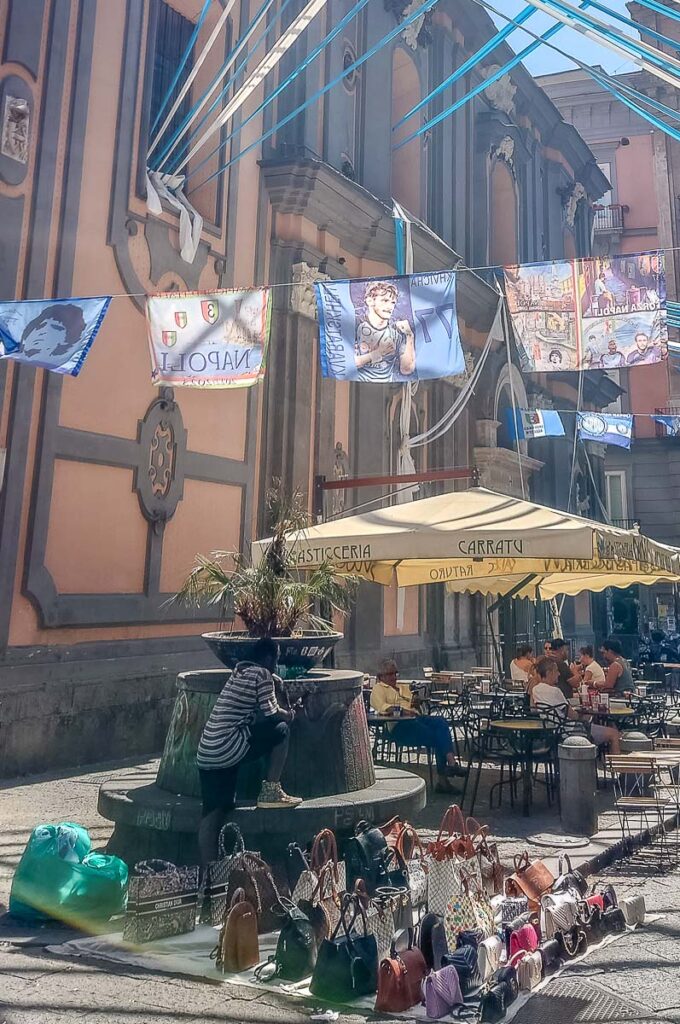
MORE INFORMATION ABOUT ITALY
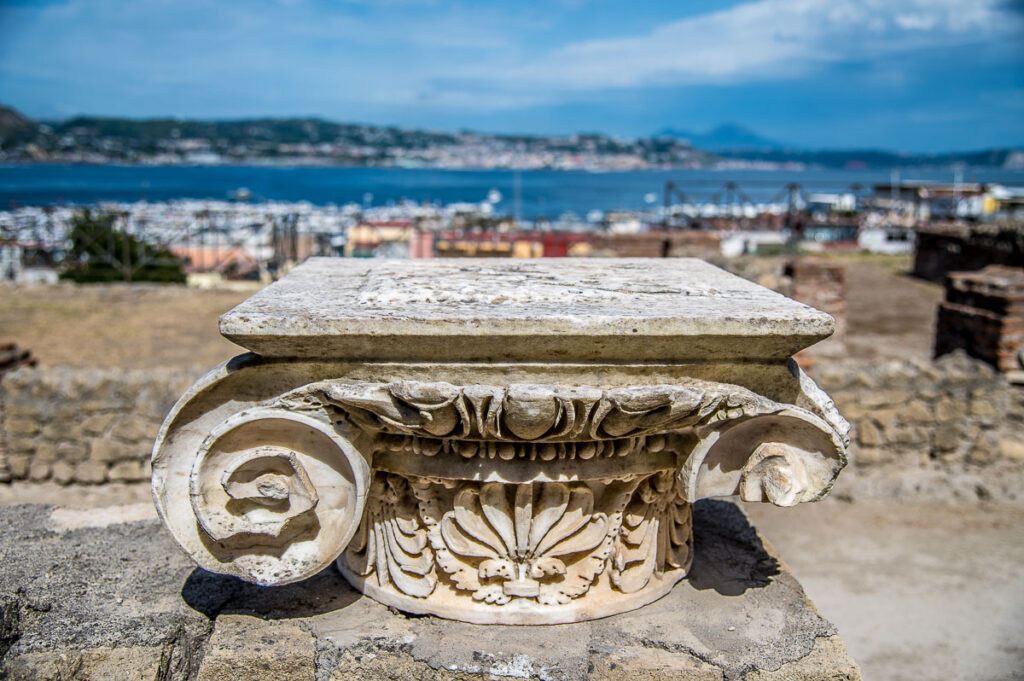
I have been blogging about travel in Italy for almost ten years now providing detailed and first-hand tried and tested information about the best things to do in this beautiful country. It’s all based on my close to twenty years of visiting Italy solo and with my family. Six of them, we actually spent living in Vicenza in the north of the country .
If you are after in-depth researched and illustrated with dozens of original photos articles about Italy, have a look at the following categories and blog posts:
- Italy – a full list of all my blog posts about Italy
- 10 Reasons to Visit Northern Italy
- Veneto , Trentino , Emilia Romagna , Umbria – full lists of all my blog posts about these Italian regions
- Venice , Padua , Lake Garda , Lake Como , Milan – full lists of all my blog posts about these must-see destinations in Italy.
In addition, right at the end of this page, you will find a list with links to some of my most popular blog posts about many beautiful and exciting cities, towns, and regions to visit in Italy. So, just scroll down and then click on the ones you want to know more about.
Finally, Italy’s official tourism website is a great source of the latest news about travel in Italy. Otherwise, this is one of the best guidebooks about Italy.
THANK YOU FOR READING
Have a look also at my ultimate travel guides for Venice , Lake Como , and Lake Garda .
For more useful information like this, please, like my blog’s page on Facebook and Instagram and subscribe to my strictly no-spam newsletter.
Email address:
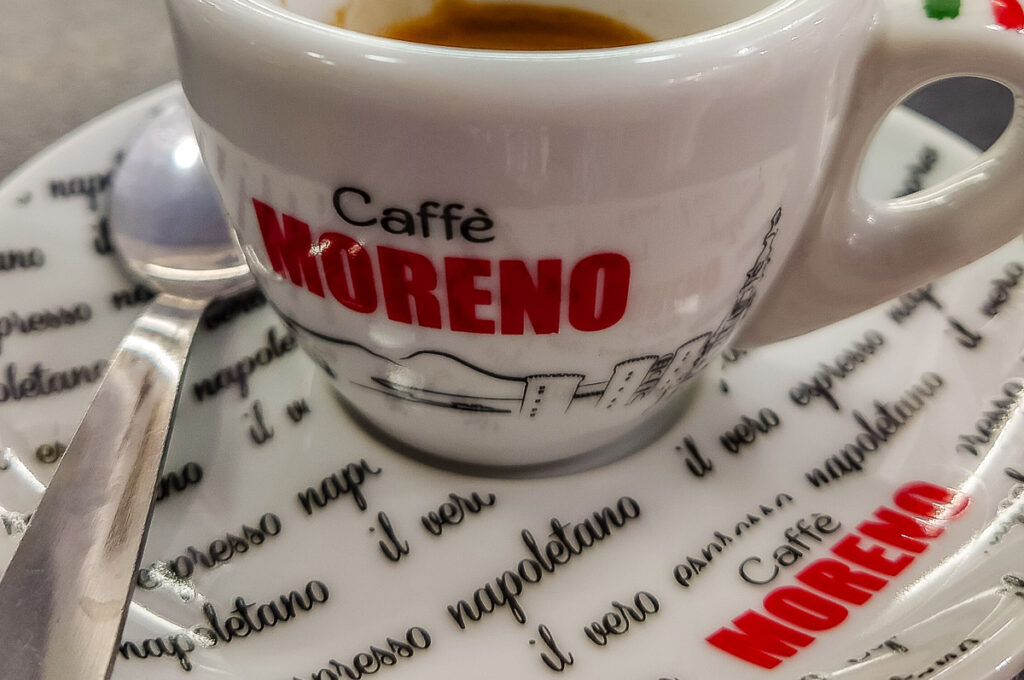
TRAVEL TOOLS
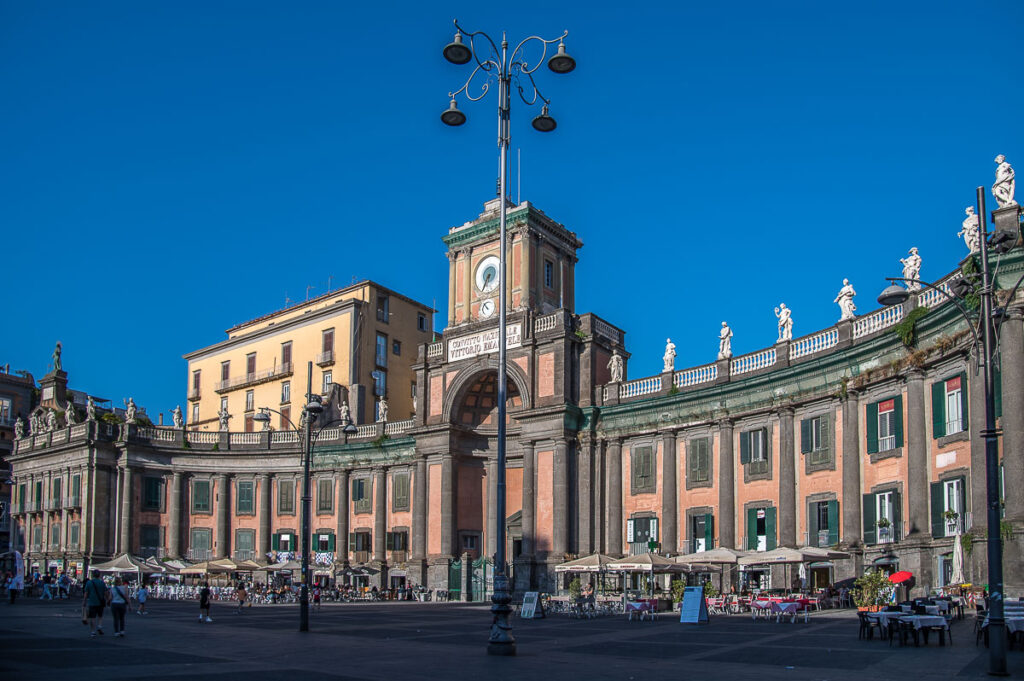
Get Ready for Your Trip to Naples in Italy
Get a guidebook from Amazon. Buy plane tickets , train tickets , and bus tickets through Omio. Research accommodation on Booking.com. Select local tours and activities on GetYourGuide , Viator , and Tiqets .
EVEN MORE HELPFUL INFO ABOUT ITALY FOR YOU
Best of Italy: Italian Piazzas , Italian Markets , Accommodation for Every Budget , Best Times to Visit Italy , Italy in Summer , Italy with Kids Italian Food: Best Italian Food Gifts , Cheap Italian Food , Rules of Italian Breakfast , Italian Breakfast Foods Italian Coffee: Italian Coffee Culture , Italian Coffee Drinks , History of Coffee in Italy Christmas in Italy: Fun Facts , Things to Do , Italian Nativity Scenes , Panettone , Christmas Guide Northern Italy: Best Cities to Visit , Major Airports , Reasons to Visit Lake Como: Ultimate Travel Guide , Best Towns , Best Things to Do , How to Get to Lake Como , Milan to Lake Como , Best Airports , Photos of Lake Como Lake Garda: Ultimate Travel Guide , Best Towns , Desenzano del Garda , Lazise , Riva del Garda , Malcesine , Torri del Benaco , Punta di San Vigilio , Campo di Brenzone , Borghetto and Valeggio sul Mincio , Map of Lake Garda , Getting Around Lake Garda , Lake Garda with Kids , 8 Best Airports , Venice to Lake Garda , Verona to Lake Garda , Milan to Lake Garda , Bologna to Lake Garda Venice: Ultimate Travel Guide , Essential Tips , Things to Do , Major Landmarks , Hidden Gems , How to Navigate Venice , Venice in a Day for Art Lovers , Train Stations , Nearest Airports , Best Tours , Beaches of Venice , Quotes about Venice , Boats in Venice , Haunted Venice , Day Trips from Venice , Arco del Paradiso Verona: Things to Do in One Day , Verona Opera Festival , Day Trips from Verona , Romeo and Juliet Itinerary , Verona to Venice , Verona to Milan Padua: Things to Do in One Day , 101 Facts About Padua , 10 Reasons to Visit Padua , Day Trips from Padua Vicenza: Things to Do , Day Trips from Vicenza , Best Museums , The Beauty of Vicenza Veneto: Top Places to Visit , Unique Adventures , Most Colourful Places , Mysterious Places , Most Beautiful Lakes , Reasons to Visit , Main Cities , Prettiest Small Towns , Most Beautiful Villages Lombardy: Best Cities and Towns , Reasons to Visit , Brescia Friuli Venezia Giulia: Venzone , Most Beautiful Villages Emilia Romagna: Bologna , Ravenna , Comacchio , Most Beautiful Villages Marche: Reasons to Visit , Gradara , Frasassi Caves , Temple of Valadier Umbria: Reasons to Visit Perugia
Everything you need to know before your trip to Naples
Dec 2, 2021 • 5 min read

The fun and vibrant city of Naples is perfect for your next vacation © Alessandro Biascioli / Getty Images / iStockphoto
Naples, Italy's third-largest city, thrives on contradictions. As one of the oldest continuously inhabited urban areas in the world, Naples is both chaotic and cultured, opulent and gritty, exuberant and understated, with architectural gems to discover around every corner.
Founded by Greeks in the first millennium BCE, Naples has witnessed over 2500 years of history unfold from its magnificent perch along the Mediterranean Sea, with Mount Vesuvius looming in the distance.
We can thank Naples for inventing pizza, but culinary delights abound, and caffè culture is found in its many charming coffee bars. Many tourists skip Naples as they make their way to the Amalfi Coast or Pompeii archeological park , but this intriguing city, with its captivating architecture, rich history, and mouth-watering culinary traditions, is not to be missed. Here's everything you need to know before your trip to Naples, Italy.

Best time to visit Naples
The best time to visit Naples is in the late spring, before the summer crowds arrive, or the early fall when the hectic tourist season has come to a close, yet the weather is still sunny and warm. Though winter is less crowded, offering more opportunities to meet the locals, the weather can be rainy.
The Christmas season is hectic in Naples, but the many festivities and holiday traditions, including the Neapolitan tradition of creating elaborate presepe (nativity scenes) , make it worth a visit despite the holiday crowds.
Where to stay in Naples
If it's your first visit to Naples, consider staying in the bustling "Centro Storico," the heart of Naples. Naples' entire central district is a UNESCO World Heritage Site, complete with cobbled streets, elegant palazzos, and historic churches around every corner.
For a more relaxed stay, Chiaia, Naples' seafront neighborhood, offers luxe hotels with stunning views of the Mediterranean Sea. Chiaia is best known for its many independent fashion boutiques, but you'll also find high-end shops here such as Prada and Armani.
Families will enjoy a stay in Posillipo, a quieter, more residential neighborhood located along the northern coast of the Gulf of Naples. Posillipo is home to several beaches and parks. Don't miss Virgiliano Park, a green oasis in the city where terraces overlooking the whole Gulf of Naples offer vistas of the beautiful islands of Ischia, Capri, and Procida.
Italian is the official language in Naples. That said, most people in Naples and Campania speak the lively Napolitano (Neapolitan) regional dialect. You'll find English spoken in most hotels and restaurants, but pack an Italian phrasebook and learn a few key phrases before your trip so you can communicate with locals.
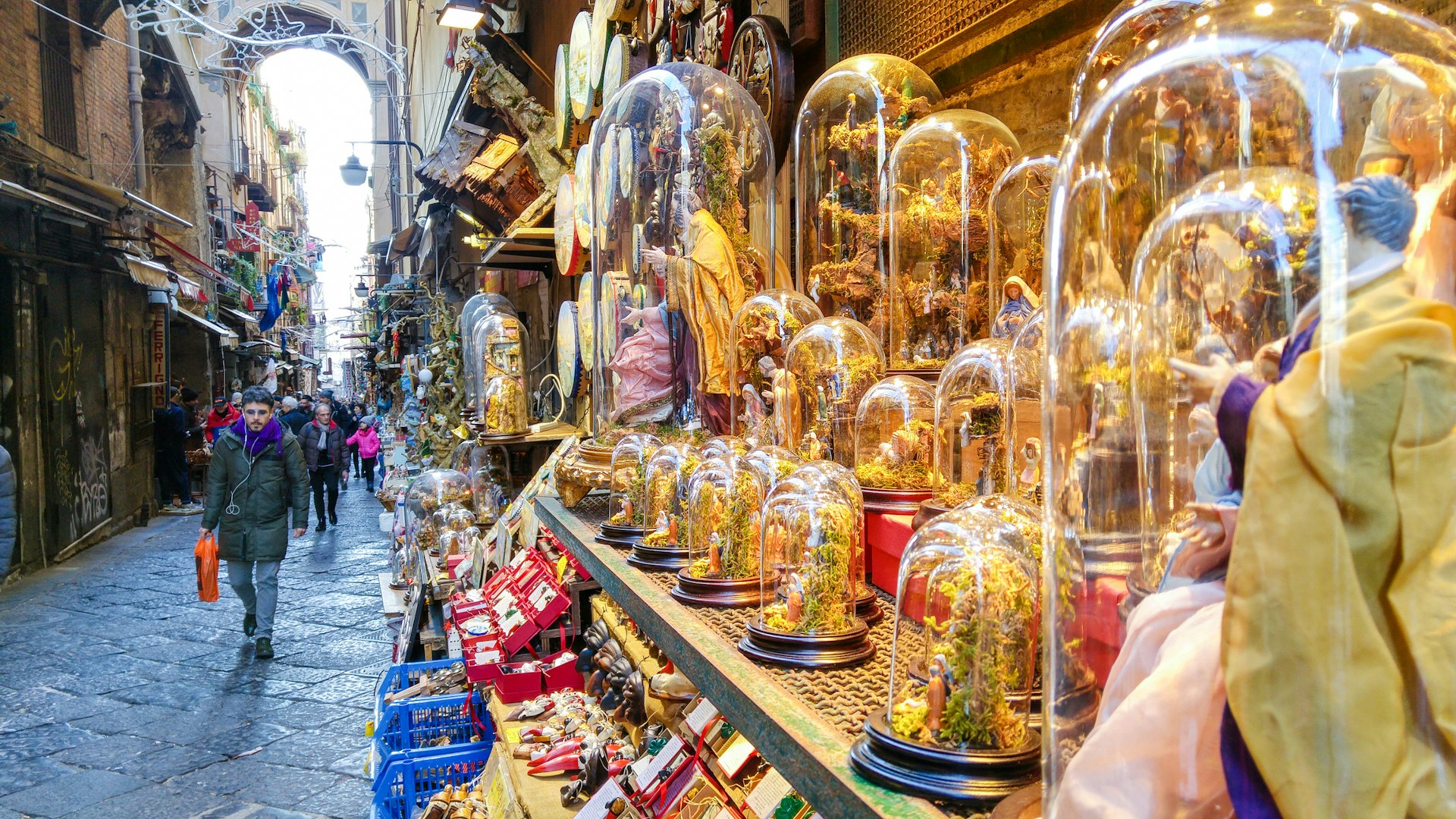
The Euro is the official currency of Naples and the rest of Italy. Credit cards (Visa and Mastercard) are widely accepted, but street market vendors, taxi cab drivers, smaller shops, and eateries may not accept credit cards and usually prefer to be paid in cash. Tipping is not standard in Italy, but it is common to add about €1 per diner to tip restaurant waitstaff for good service or round up the bill. At a bar, for example, leave 1 Euro for an 80 cent espresso.
Getting Around Naples
Naples' main tourist attractions are centered along the seafront and Centro Storico, so it's easy to get around on foot. The city has an extensive public transportation system with Metro trains, buses, trams, and even funiculars (incline railways) that transport rides up prominent hills in the city. Regional trains connect visitors to Pompeii, Herculaneum, and towns on the Amalfi Coast, including Sorrento. Naples International Airport is connected to the city by bus.
Renting a car in Naples isn't advised since parking is scarce, the narrow, one-way streets can be challenging to navigate, and traffic is always an issue, so opt for walking or taking public transportation. Taxis are plentiful, but never enter one without negotiating the price beforehand to avoid being overcharged.

Sightseeing passes
If you plan to spend a lot of time sightseeing in Naples, save money with a Naples ArteCard . The pass includes free admission to up to three museums and a 50% discount admission to attractions thereafter, plus free travel on all public transportation. Some attractions have limited capacity, so you may need to book a few visits in advance. The ArtePass also includes tourist sites and museums outside of Naples, in the surrounding region of Campania, including museums in Pompeii.
You can buy it online and receive it immediately via email or app, but be sure to activate it manually on first use at any UnicoCampania transport network turnstile or at the ticket office of any participating museum. Visitors aged between 18 and 25 will save even more money with the Naples ArtePass 3 days Young pass.
Is Naples a safe city to visit?
Naples is generally safe to visit, and most major U.S. cities outrank Naples in terms of crime levels. Violent crime is rare, but petty crime remains an issue. Pickpockets can be a problem in crowded places, around tourist landmarks, on the metro and at train stations, so keep your belongings secured in a money belt.
In the case of a medical emergency, dial the free number 118 anytime, anywhere in Italy, to request emergency assistance or an ambulance. Finally, Mount Vesuvius is an active volcano, and earthquakes are also possible, so keep an eye on the news before your trip.
You might also like:
Italy's best dishes and where to try them Where to find your favourite pasta shapes Eat Italy: learn about Italian food culture with this Lonely Planet's book
Explore related stories
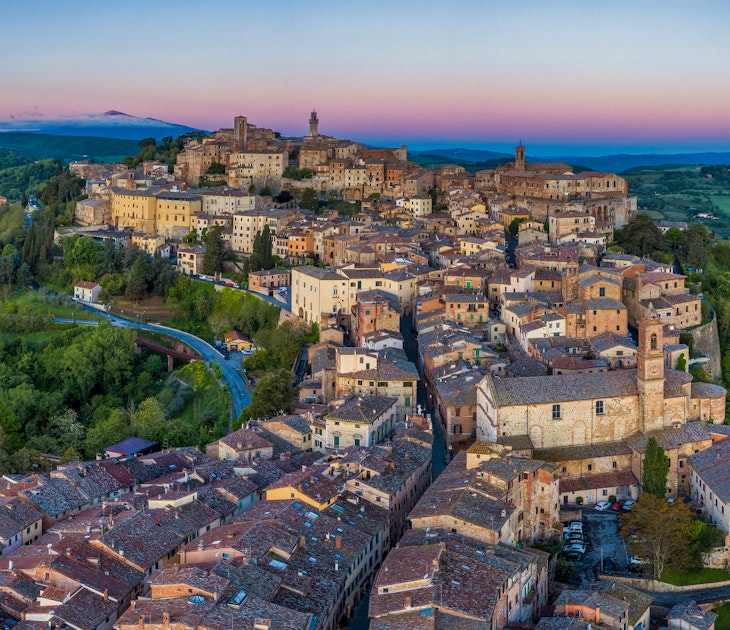
Destination Practicalities
Apr 7, 2024 • 11 min read
Follow our local advice on the best ways to really experience this classic region of Italy.

Mar 26, 2024 • 6 min read
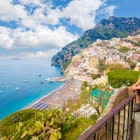
Mar 22, 2024 • 7 min read

Mar 21, 2024 • 6 min read
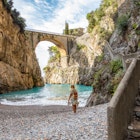
Mar 18, 2024 • 7 min read
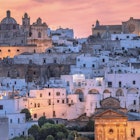
Mar 15, 2024 • 10 min read

Mar 8, 2024 • 6 min read

Mar 1, 2024 • 5 min read

Feb 28, 2024 • 5 min read

Jan 31, 2024 • 6 min read

From its charming waterfront under the shadow of Vesuvius, to its beautiful and bustling historic centre: Naples is a stunning city
Its position as a meeting place for various peoples since ancient times has had a profound impact on Naples, making it a cultural hub. This is evident when walking through its streets, full of artistic and architectural treasures. It is a city with a unique magic, blossoming with natural attractions. From amazing food to all kinds of entertainment, you will never be bored.
What to see in Naples
- Must-see places
- Surroundings
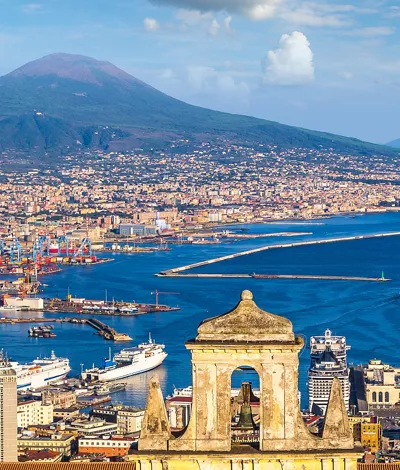
2 days in Naples: the itinerary
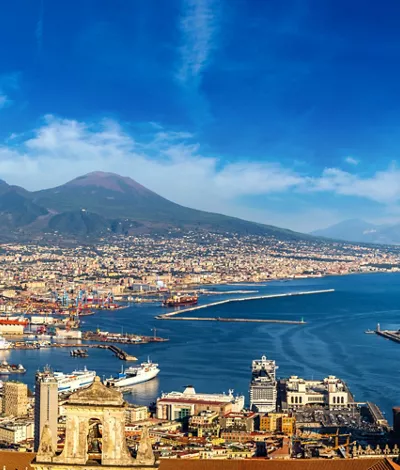
A 10.000-step itinerary around the centre of Naples
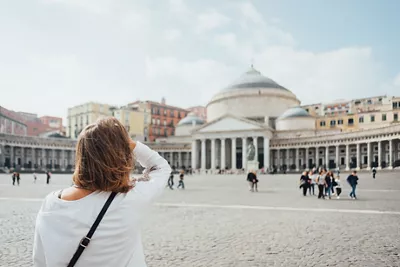
The enchanting historic centre of Naples UNESCO World Heritage Site
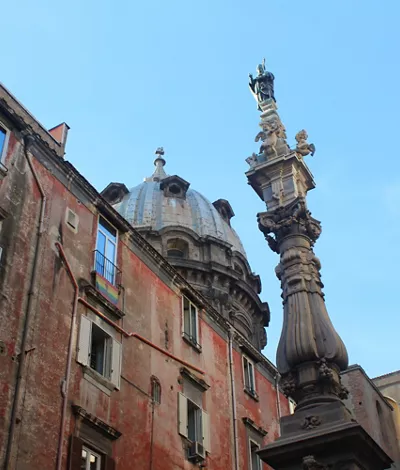
In Naples for the Feast of San Gennaro: between tradition and spirituality

Street food in Naples is the quintessence of wonders for the palate
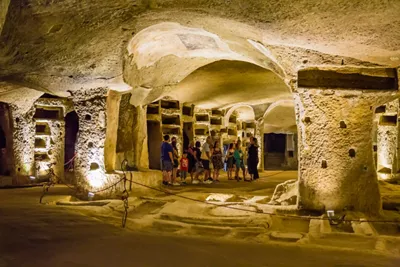
The Catacombs of Naples
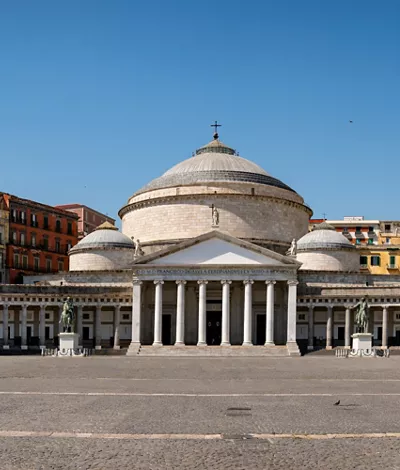
Piazza del Plebiscito
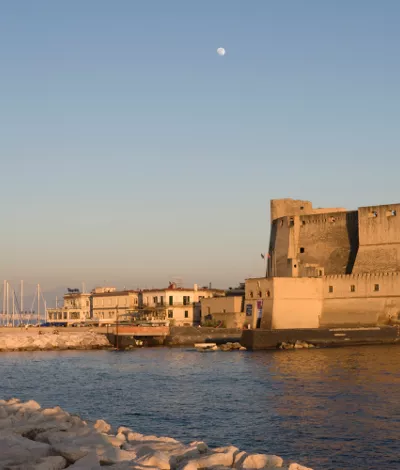
Castel dell'Ovo
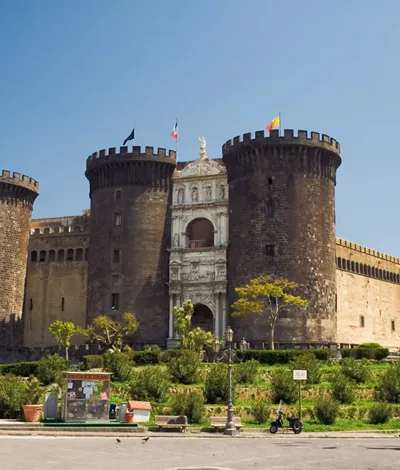
Castel Nuovo or Maschio Angioino
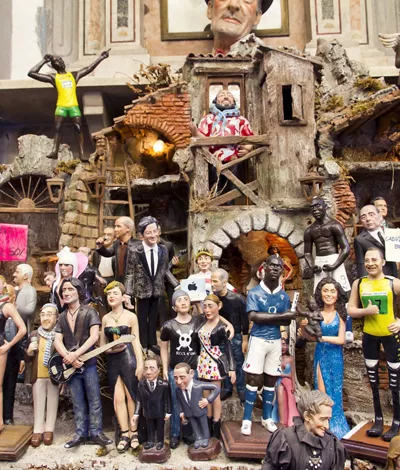
San Gregorio Armeno
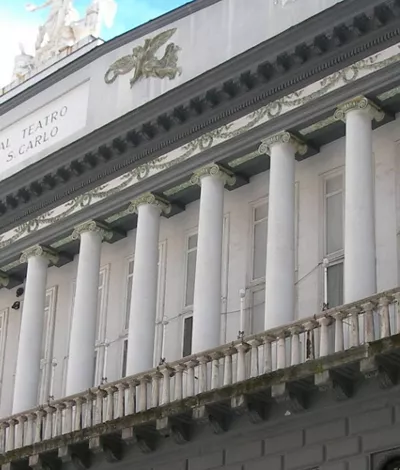
San Carlo Theatre
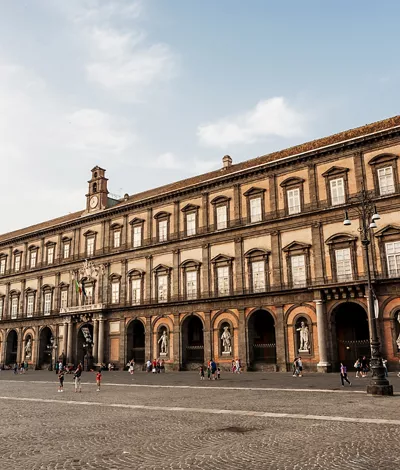
Royal Palace of Naples
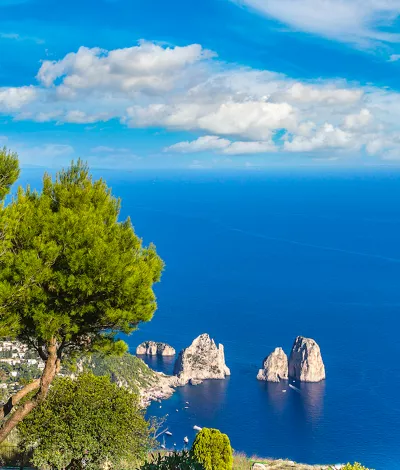
Ischia, Capri and Procida
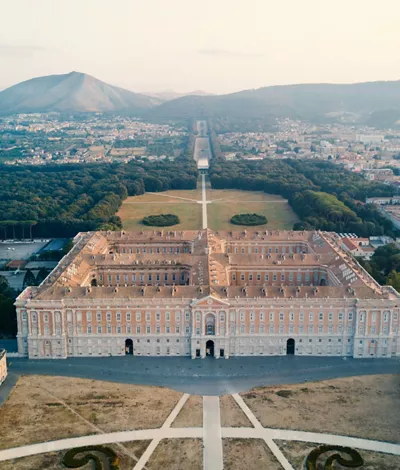
Reggia di Caserta
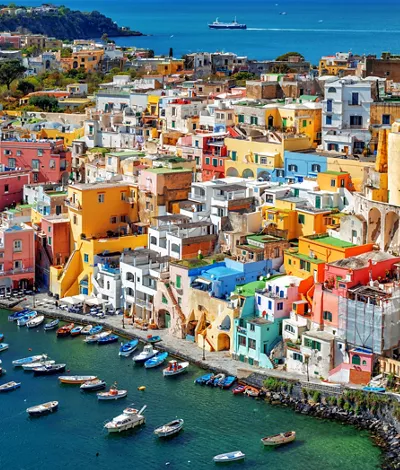
Procida: the enchanted island of watercolour houses and turquoise sea

The Sorrento peninsula: emerald green waters and the scent of lemons
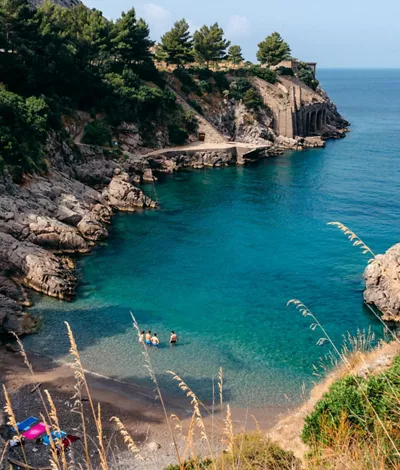
10 pristine beaches not to be missed while visiting the Sorrento Peninsula
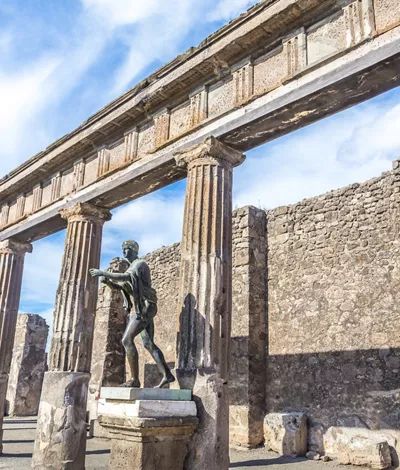
Discovering the archaeological area of Pompeii, Herculaneum and Torre Annunziata
Comicon Naples: the most important network of pop events in Italy
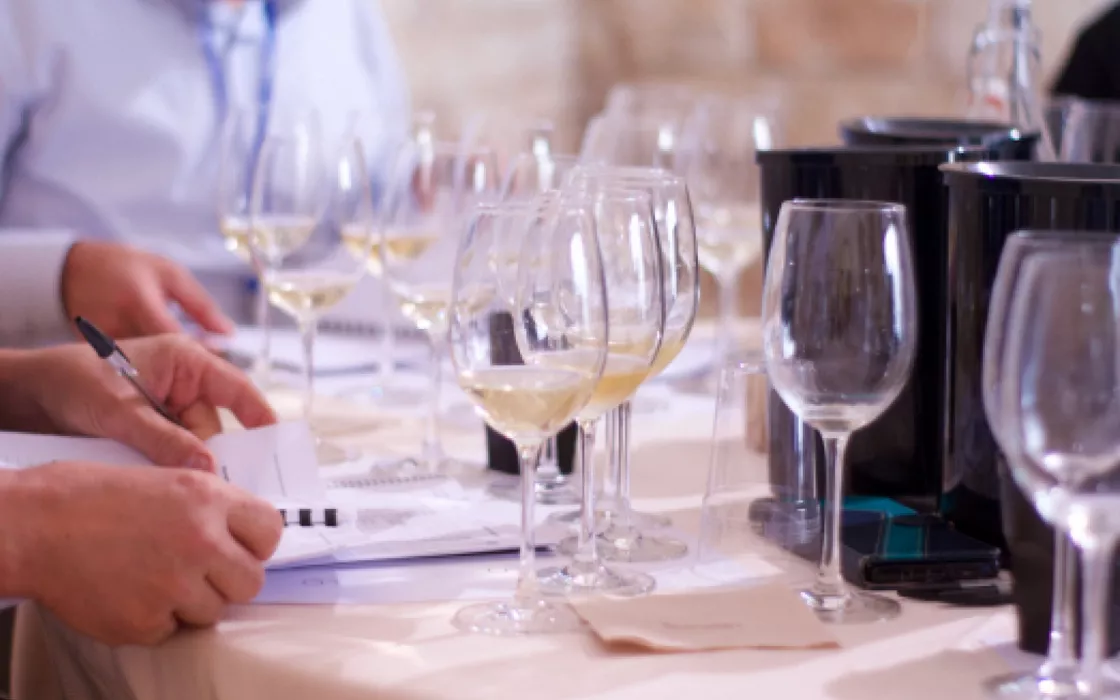
Vitigno Italia
An enchanting city of sea and culture
Naples not only welcomes, but literally embraces all who visit: it is well-known for its warmth, not only in terms of the weather. Overlooking the sea and with Vesuvius in the background, Campania's capital city has a colourful centuries-old history, with countless monuments to admire. There is even plenty to explore underground, with organised tours of the labyrinth of tunnels that lie below the city. The gastronomic tourism here is unrivalled: ready to try the best pizza in the world?
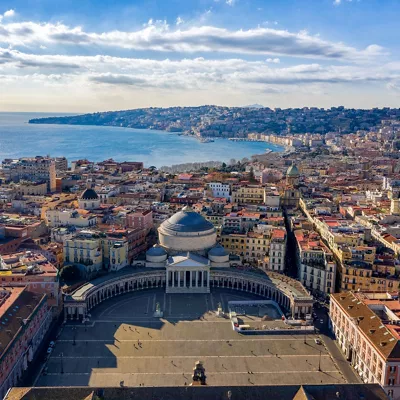
From its charming waterfront under the shadow of Vesuvius, to its beautiful and bustling historic centre: Naples is a stunning city. Its position as a meeting place for various peoples since ancient times has had a profound impact on Naples, making it a cultural hub. This is evident when walking through its streets, full of artistic and architectural treasures. It is a city with a unique magic, blossoming with natural attractions. From amazing food to all kinds of entertainment, you will never be bored.
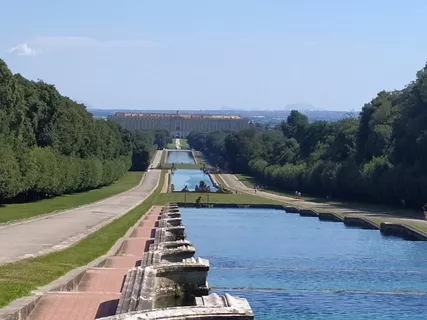
Discovering Bourbon splendour just outside Naples The province of Caserta should be discovered and savoured starting with one of the masterpieces of Italian Baroque: the magnificent Royal Palace, built by Charles III of Bourbon on the outskirts of Naples. Here, you can spend an entire day strolling through the huge park surrounding the main building, amidst a manicured English garden and fountains that will leave you speechless. A visit to the Royal Apartments, starting with the imposing Scalone d'Onore often used as a TV and film set, is a magical experience. Another obligatory stop for those wishing to discover this area is the medieval village of Casertavecchia with its alleyways full of charm and history, restaurants for you to sit down and enjoy local delicacies and panoramic terraces from which you can take unique photographs. Near Caserta, you can also admire one of the most ingenious structures from the Bourbon era: the aqueduct built by Luigi Vanvitelli to supply water to the entire city and its surroundings. In Santa Maria Capua Vetere you can take a step back in time and stroll through the well-preserved remains of the Campano Amphitheatre, built when the Western Roman Empire was at its peak.
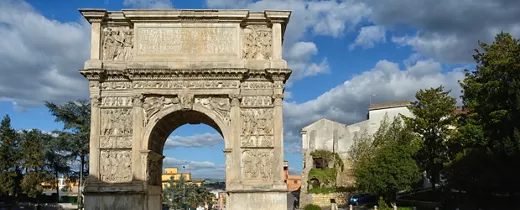
Benevento is a beautiful but complex city, founded thousands of years ago in the hinterland of what is now the region of Campania, more than 60 km from Naples. Nowadays, all things considered, from most parts of Italy it is easier to get to the reserve by high-speed train than by plane or motorway. If you're looking for answers about the complex configuration of the city, with all its narrow alleys, irregularly-shaped squares, Roman stones and Baroque palaces built over the centuries - then the best place to start is the Sannio Museum, which traces an outline of the region's history. But if that sounds a bit full-on, why not enjoy a stroll around the streets first, before entering the museum. One of the most popular places for a peaceful stroll is Corso Garibaldi, a large and much-loved main street which certainly has its fair share of shops, the church of St Sophia in the centre, the Rocca dei Rectori at the end of the street and the Arch of Trajan at the end of a short side street. But perhaps the town's pride and joy is Caffè Strega. Inside, the walls are adorned with posters of ladies in flowing garments (perhaps witches?), there are tables for chatting or even studying (Benevento is also an important university town), as well as rows of the town's famous liqueur. There is more, of course: the Duomo itself, or the modern art installation by Mimmo Paladino, near the Sannio Museum. Another point to note is that according to legend, Benevento was founded by a Greek, Diomedes, a wandering veteran of the Trojan War. But let's not go over the top. Sleeping dogs (and Greek heroes) are best left to lie!
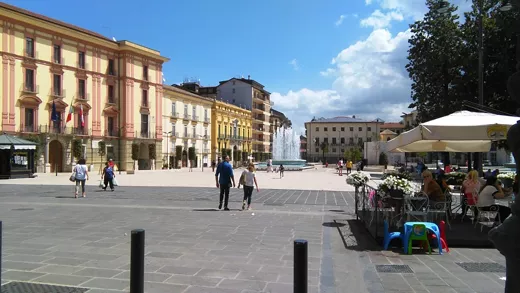
Nature, art and faith in green Irpinia In the pristine nature of Irpinia, tranquillity, beauty and itineraries intertwine, between art, faith and nature. The Avellino basin is framed by the Monti Picentini mountains and dotted with castles, abbeys and villages to explore, including the beautiful village of Monteverde. The Serino forests are the perfect backdrop for a picnic. Nature lovers can immerse themselves in the Lake Conza Oasis, explore Caliendo Cave or be enchanted by the Calabritto Waterfalls. In Avellino, you can admire Piazza della Libertà, with the Bishop’s Palace, and discover the 36-metre-high Clock Tower and the majestic cathedral dedicated to St Mary of the Assumption and St Modestinus. Foodwise, you can enjoy gnocchi, bean and chestnut soup, caciocavallo cheese, stuffed peppers and local wines: Taurasi, Greco di Tufo and Fiano di Avellino. The heart of religious tourism in the area is the Montevergine Sanctuary, a monastic complex built in 1126 at an altitude of 1,270 metres. It is accessible on foot from Ospedaletto d’Alpinolo or by cable car from Mercogliano. Another splendid monastic complex is the Abbey of San Guglielmo al Goleto in Sant’Angelo dei Lombardi. Towering over the valleys, the Lombard-built castle of Avella and the Norman Castle of Ariano Irpino offer an insight into the past. The medieval castle of Rocca San Felice is associated with the legend of Margaret of Austria’s ghost, which roams there under a full moon.
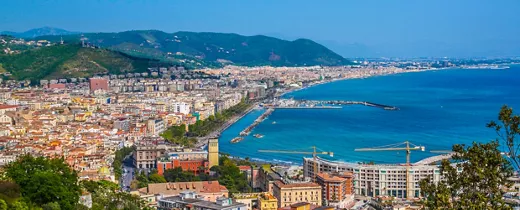
Nature and history nestled between the sea and the mountains Overlooking the Tyrrhenian Sea, the province of Salerno boasts some of the most popular and visited tourist destinations in Italy. The historical centre of the capital, restored after the damage caused by the 1980 earthquake, preserves its original medieval structure intact, the best example of which is the Cathedral, built by the Norman prince Robert Guiscard. Stop, too, at the Church of the Annunziata with its beautiful Baroque bell tower, the Arechi Castle, the Church of S. Pietro a Corte and Piazza Flavio Gioia, known as the Rotonda because of its characteristic shape on which Porta Nova opens,monumental gateway rebuilt in the 18th century. There is no shortage of green spaces in the city, such as the Mercatello park, the Pinocchio park for children and the Minerva Gardens. The Salerno coast is dotted with unmissable villages. Amalfi, Positano, Maiori and Minori, Vietri sul Mare are just some of the towns where you can enjoy clear sea, breathtaking views and culinary delights. A compulsory stop at the archaeological area of Paestum to discover the majestic Greek temples, perfectly preserved. Trekking and nature lovers cannot fail to be enchanted by the Path of the Gods a scenic route from Agerola to Positano, and the natural beauty of the Cilento National Park, Vallo di Diano e Alburni.

Continue living like an Italian
Subscribe to the Newsletter so as not to miss places, events and experiences for experiencing the best side of Italy: the authentic one.
Keep up to date
Would you like to learn about the most authentic experiences to be had in Italy, stay up to date on the most interesting events, discover our special offers and receive lots of insider hints and tips?
Save your favorite places
Create an account or log in to save your wishlist
Do you already have an account? Sign in
- United Kingdom
- Curated Stays
- Wine Travel
- About Isabelle
- Work with Us
22 Essential Things to Know Before Visiting Naples, Italy
- Isabelle Hoyne
- February 15, 2024
** Disclosure: some of the links on this site are affiliate links and should you make a purchase through these, I may receive a small commission at no extra cost to you. Thank you for your support!**
Following my own numerous explorations of Naples, this guide arms you with crucial insights to be aware of before you visit the city. From history to food, accommodation to day trips and getting there and around, here are 23 essential things to know before visiting Naples, Italy .
Naples is a well-known city in southern Italy, but it is also one that is gravely misunderstood. Many travellers skip through its airport on their way to the Amalfi Coast and don’t give this diverse, historic city a look-in. That, in my opinion, is a grave error.
Those who know a little about Naples might allocate half a day to head into city centre and sample from the source the city’s most delectable dish – pizza. Others may tack on a night in Naples so they can use it as a base to go and explore nearby Vesuvius or the ancient city of Pompeii.
While these visitors are on to something, they’re still a bit wide off the mark as to just what this city is all about.
Rough around the edges, the historical centre of Naples is a hodge-podge of narrow, cobbled streets. Apartment buildings are strung with a festoon of sheets and unruly scooters play cat and mouse with pedestrians, beeping with indignity when the crowds fail to part in prompt fashion.
Thought that was a pedestrian zone?
Well think again, for here they march to the beat of their own drum and shopping, walking, driving, eating and living all mesh together as one with all activities often taking place within a few square metres of each other.
With a fascinating history that stretches back to the ancient Greeks, the city of Naples followed a slightly different path to other places in Italy.
You’ll notice it when you get there, especially if you’re a regular visitor to Italy – the food is different, the architecture is in a class of its own and the people, as a generalisation, have much more time for tourists when compared to other large cities in Italy.
This Naples city guide will help you navigate through the many nuances of Naples. Navigating the vibrancy and chaos of Naples can be an exciting adventure, yet knowing where to focus your attention can truly enrich your experience.
Discover, amongst other things, why I think you should prioritise a visit to the serene Catacombs of San Gennaro over the more chaotic Naples Underground, as well as what you need to know about safety in Naples.
This guide, honed by my visits and extensive research, is designed to navigate you through the many layers of Naples’ charm. From savouring pizza to strolling the historic streets, get ready to uncover the unexpected surprises of visiting Naples, Italy.
Useful resources for your trip to Naples, Italy
Trains: Check Omio to search schedules and buy tickets Flights: Find the cheapest flights on Skyscanner Ferries : Search ferry schedules and book tickets here Airport transfer : Get a quote & book here Top rated Naples attractions & tours ⭑ Naples Underground ⭑ Catacombs of San Gennaro (*Cultured Voyages top pick*) ⭑ Street Food Tour with Local Guide ⭑ Small Group Naples Pizza Making Experience Best day trips from Naples ⭑ Naples or Sorrento: Full-Day Pompeii and Mount Vesuvius Tour ⭑ From Naples or Sorrento: Amalfi Coast Full-Day Trip ⭑ Island of Capri Full-Day Tour with Lunch Cultured Voyages recommended accommodation ➡ Quatrum Napoli ( plush guesthouse with rave reviews ) ➡ Grand Hotel Santa Lucia ( waterside luxury with sea views ) ➡ Decumani Hotel De Charme ( central hotel with old school charm ) ➡ Artemisia Domus ( extremely well-located luxe-for-less pad ) ➡ La Casa Sul Nilo ( old world luxury on a budget ) Don’t forget to pack! Ricks Steve’s Naples & Amalfi Coast // In the Shadow of Vesuvius: A Cultural History of Naples // compression packing cubes (my #1 travel item) // good walking shoes (these are my tried and tested favourites of all time!)
Things to know before visiting Naples, Italy
It’s gritty, but that’s part of its charm.
One arrives in Naples and is met by an assault of the senses. The first thing that hits you is a sheer cacophony of sound. A barrage of lilting Italian voices fight to be heard over the sound of revving engines, beeping horns and the rattle of tyres over worn cobblestones. It’s all one big great, beautiful chaos.
Grandiose buildings erected in wealthier times now have faded, peeling facades and many today carry graffiti (although efforts are being made to renovate some of these). Sheets are strung from balconies, as well as across narrow, winding alleyways to dry and neighbours shout across the narrow voids to each other.
Naples is a densely populated city, with many living in the confined spaces of apartment lodgings and life, naturally enough, spills over into the streets sometimes.
With that comes a bit of a rubbish problem – Naples is by no means the cleanest city you’ll ever visit – and you will have to be prepared to see quite a bit of rubbish in the streets, piled up around bins.
From the 1990’s to 2010’s, the Camorra (Campania’s branch of the Mafia) infiltrated the waste business, which led to a rubbish crisis in Naples. Local government has since taken back control and there has been a vast improvement, but do expect to see some rubbish about.
RELATED READING | Best Things to do in Naples Italy
Naples is distinctly different to other cities in Italy
Naples simply bursts with attitude and unlike the – dare I say it – more sterile cities further north in Italy, the hubbub and helter-skelter aspects of the city are more akin to major urban centres in South-East Asia .
The root as to why Naples is so different from the rest of the country lies in its history and the fact that it’s operated rather independently for centuries; millenia even.
The city dates back some 4,000 years and is one of the oldest cities in the world. Having first been established by Greek settlers, by the 6th century BC the ancient city of Neapolis had been erected and with it, the Neapolitan culture that Naples is famous for – even the Romans couldn’t shake it when they conquered the area.
Following the Romans, Naples was ruled by a succession of Goths, Byzantines, Lombards and Normans, before it became part of Kingdom of Sicily, of which it became the capital in 1266.
After a few more power shifts, Naples played a major role in the Italian Renaissance of the 15th century and subsequently nurtured some of the greatest artists the world has ever known, including Renaissance bad-boy Caravaggio and master of sculpture, Bernini.
The Neapolitans tried to go it alone in the 17th and 18th centuries, but both its attempts to establish a republic failed. It unified with the rest of Italy in 1861 (although from conversations I had with locals while there, still feels a little cut off from the north of the country today).
Continuing on the theme of independence – you can’t keep a Neapolitan down – in 1943 they were the first Italian city to rise up against Nazi occupation. When Allied forces arrived in town, Naples, they discovered, was already free.
With a past that differs to Italian cities further north, Naples presents a unique tapestry.
This city layers its distinct aspects one upon another. Its cuisine, the life it had under the grip of the Mafia, and its obsession with Maradona – footballing legend and Naples’ Argentinian born, adopted son – all contribute to its character.
Additionally, there’s an underlying gritty, yet bohemian edge. You’ll come to see that Naples really is different to anywhere else you’ll visit in Italy.
RELATED READING | Where to stay in Naples, Italy
Football is a religion, and Maradona is a God
In the pulsating heart of Naples, football transcends mere sport; it’s a fervent religion, and Diego Maradona, its undying deity.
The city’s passion for its beloved team, Napoli, is palpable in every corner, every chant, and in the sea of azure that floods the streets. This fervour reached a crescendo in early 2023, when Napoli clinched their first Italian Serie A title in 33 years .
Wander through Naples, and you’ll find the streets festooned with football banners and flags, a vivid tapestry of blue and white that flutters in the Mediterranean breeze.
Souvenir shops overflow with Napoli memorabilia, each item a sacred relic to the local faithful.
But it’s the reverence for Maradona that truly encapsulates the city’s love affair with football. The Argentine legend, who led Napoli to its previous Serie A titles in 1987 and 1990, is not just remembered; he is venerated.
In the labyrinthine alleys of the Spanish Quarters, Maradona’s legacy is immortalised in a huge, vibrant mural and the subsequent shrine of sorts that’s built up around it.
Maradona’s story is inextricably linked to Naples – his extraordinary talent mirrored in the city’s own gritty resilience and flamboyant flair. To understand Naples, one must understand this unbreakable bond with football, where every goal is a communal heartbeat, and Maradona seems to forever be its guiding spirit.
It sits in the shadow of an active volcano
There’s no getting away from this one – Naples sits in the shadow of a humdinger of a volcano, the infamous Mount Vesuvius. Astonishingly, more than two million people live in its vicinity.
Vesuvius is highly monitored and has been studied intensely due to its eruptive past. At the moment, the volcano is in a period of ‘active rest’, and visitors can today hike the paths of Vesuvius National Park , even walking to the top of the crater if they so desire.
At its highest point, Vesuvius is 1,127 metres tall, with a crater that measures 450 metres in circumference and reaches a depth of 300 metres.
Thought to be around 400,000 years old, Vesuvius in its present form is actually the union of two cones – the older Mount Somma cone, which sits on the outside, and the younger internal cone that is Vesuvius.
The soils in the area of Vesuvius are rich in minerals and the area has become synonymous with food production as a result – more on that later in this post.
The slopes of Vesuvius are planted with orchards and vineyards and wine produced there is called Lacrima Christi , which is Latin for “Tears of Christ “.
READ NEXT | Top 14 Naples Wine Tours [2024] + Tips To Choose The Right One
Pompeii and Herculaneum are a stone’s throw away
Vesuvius is most famous for its most fatal eruption of 79AD, which today has left us with the preserved Roman towns of Pompeii and Herculaneum. Both these towns had a different eruption experience, which has led to two different types of remains today.
In the first phase of Vesuvius’ eruption, a huge column of volcanic ash, gas and rock shot into the air and rained down on nearby Pompeii.
It trapped inhabitants in the town under falling buildings, which led to a far higher human cost than in nearby Herculaneum, where many inhabitants had the chance to escape.
The second phase of the eruption became horrifically fatalistic. Pyroclastic flows seeped from the crater with intense speed and ferocity. Pompeii was covered under ash 4-6 metres deep, while Herculaneum was buried under an astonishing 25 metres of ash.
Today, visitors can walk the streets the ancient Romans once did and marvel at fast-food outlets, sporting arenas, public baths, brothels, places of worship and gathering and private homes, some with vivid frescos and mosaic floors. Archaeologists remain at work and there are regular discoveries still to this day.
The best of these you will find in Herculaneum.
Under its 25 metre covering of ash it found better protection against the march of time, along with the fact that the upper floors of Pompeii’s buildings did not survive the barrage of volcanic rock in phase one of the eruption, so more of Herculaneum remains intact.
| Plan a visit: See all visiting options for Pompeii and Herculaneum here
It’s home to an ancient underground system of caverns and catacombs
The city of Naples and the area surrounding it sits on a fantastic natural resource, and that is the marvellously durable material of tuff rock.
Inhabitants of the area have been wise to this fact for many years and when building their city of Neapolis in the 4th century BC, the Greeks extracted this tuff rock in large quantities, using it to build the city walls, temples and underground tombs.
The rock extraction process left great underground caverns and later, the Romans came along and applied their engineering prowess to repurpose these into aqueducts, which supplied water to the city of Naples.
Over time, these grew into a vast network stretching to some 450km under Naples.
A new aqueduct was built in the early 1600’s but this eventually fell out of use by the early 1900’s, when a more efficient water system was created.
These underground caverns and passages were abandoned, until they found great purpose as bomb shelters during the Second World War – at 40 metres below the surface, it is estimated that the tunnels saved some 200,000 lives.
It is now possible to visit Naples Underground , to explore some of the water cisterns, bomb shelters and ancient caverns.
In addition to this, is the much younger in comparison Bourbon Tunnel. The masterplan of Ferdinand II, who was a Bourbon king of Naples and Sicily in the 19th century, the tunnels were constructed as an escape route by an increasingly paranoid Ferdinand. They stretched from his palace to the army barracks.
Never used by Ferdinand, they found purpose during WWII as bomb shelters, but not before Mussolini dumped many wrecked vehicles, which can still be viewed today, eerie and dust-covered, during a guided visit to the Bourbon Tunnel.
Finally, are the spectacular catacombs in Naples, of which there are three. The largest are the Catacombs of San Genaro , who is Naples’ patron saint.
Stretching to some 60,278 square feet, they contain around 2,000 burial recesses, 500 sarcophogi held within wall niches and some remarkable 5th-6th century frescoes. It’s an extremely worthwhile visit and one I highly recommend.
History and culture buffs will fall in love with Naples
On the basis of the city’s long history already outlined in this post, history buffs are guaranteed to fall in love with Naples. Having passed through so many hands throughout the millenia, most ruling entities left a mark on the city that can still be viewed today.
The earliest of those marks is the vast, ancient cave system underneath the city, where you can still see the chisel marks left by Greek slaves in the tuff rock thousands of years ago.
This, you will be able to explore in more detail via a guided tour of Naples Underground , with tours led in a variety of languages. You’ll also be able to see the remains of some of the original, 4th century BC city walls in Piazza Bellini .
I’d also recommend a visit to one of Naples catacomb systems. The spectacular San Genaro catacombs were recovered through a local initiative and they are managed by “ La Paranza, ” a group formed by local youths.
Their renovation and opening to tourists has led to a regeneration of the area and provides an opportunity for you to contribute to and support a very worthy social initiative.
The National Archaeological Museum of Naples is world famous and holds within its walls a vast collection of artefacts, including many of the frescoes and some tiled mosaics, from the destroyed cities of Pompeii and Herculaneum.
If you’re planning a visit to nearby Pompeii and/or Herculaneum a visit to the museum should also be a must in your itinerary.
It is possibly the Bourbons who left the most visual impact on what we see of Naples today in terms of its architecture in the historic centre.
You can learn more about them in the Royal Palace of Naples located in Piazza del Plebiscito and their impressive art collection, which contains masterpieces by artists from every Italian school of painting, is housed in the Capodimonte Museum , a grand palazzo that overlooks the city centre from on high.
Naples is also home to one of the most famous important sculptures in the world; The Veiled Christ . Completed by Giuseppe Sanmartino in 1753, the veil and its folds on this masterpiece are carved with exquisite delicacy and tickets to see it book out well in advance, so make sure to purchase yours a few weeks before you head to Naples city.

There is an ever-evolving street art scene
Naples’ streets are an open-air gallery, where the walls narrate stories through vibrant street art. This art form, blending the contemporary with the traditional, is an integral part of Naples’ urban landscape and offer insights into its soul.
One cannot miss the iconic “ Madonna with a Pistol ” by Banksy, a piece rich in irony, juxtaposing religious imagery with a symbol of organised crime. It’s a striking commentary on the complex interplay of faith and societal issues in Naples.
In East Naples, the Murales Park , birthed from a collaboration between “INWARD” and Arteteca, is more than art; it’s a social project.
Here, Jorit Agoch’s “Ael. Tutt’egual song’ e criature” portrays a Romany child, symbolising integration and hope. Similarly, his hyper-realistic “Gennaro” at Forcella intertwines the familiar with the divine, merging the face of a friend with that of San Gennaro, the city’s patron saint.
As you meander through Naples, the works of Exit Enter, with their whimsical stickmen, and Alice Pasquini’s mysterious women, add layers of intrigue and strength to the cityscape. Blu’s large-scale mural at the Ex-OPG Je so’ Pazzo, depicting the horrors of imprisonment, is a powerful, unsettling presence.
In the Quartieri Spagnoli, the immense Maradona mural by Jorit , a tribute to the football legend, is one of the most visited pieces of street art in the city.
Each piece of street art in Naples tells a story, a blend of history, culture, and social commentary, making the city’s walls a canvas of collective expression.
Naples is safe for tourists…
When most people hear ‘Naples’, they immediately think ‘Mafia’. This, unfortunately, is a little unfair to Naples as there is a whole lot more to this life-filled city.
Naples is a safe city for tourists to visit. It is a city on the up and has made great strides in recent years to shake off its former associations to crime, poverty and corruption.
While the Camorra does still operate in the city (as they have done for around 400 years) you need to think about this a little more logically if that fact makes you nervous – basically, they have bigger fish to fry than your average tourist.
Cities in the US like Philadelphia and Chicago rank higher than Naples in terms of crime.
It is more in your line to worry about the more ‘regular’ mishaps that befall tourists when visiting any busy city – pickpockets and petty theft. This can be avoided by ensuring you don’t wear anything too flashy and by ensuring your belongings can’t be accessed easily.
Wear a secure, cross body bag that you can safely close and if you are wearing a backpack, to make sure you wear both straps properly over your shoulders.
Like most major cities, the area around the train station ( Garibaldi ) is a bit dodgy so pay attention around here. While the areas around the Archaeological Museum and the Spanish Quarter are fine during the day, exercise more caution at night and stick to well lit areas.
Naples is a place that is full of narrow, cobbled streets (i.e. great escape routes if you know these streets well), so to counteract this I would just stick to the main thoroughfares at night as you’re not familiar with the city.
All of the above being said, while according to Numbeo crime rates in Naples fall on the higher side, these tend not to be related to tourism.
…but you should avoid the train station at night
As dusk falls over Naples, the vibrant hum of the city takes on a different tone, especially around Napoli Centrale, the main train station. It’s wise to exercise caution here after dark, particularly if laden with luggage.
Thefts, often swift and non-violent, are not uncommon, even in the broad light of day. As it gets darker and quieter later in the day, the area becomes a fertile ground for opportunistic pickpockets and luggage snatchers, who are adept at exploiting a moment’s distraction.
This isn’t to paint a picture of pervasive danger but to advise vigilance.
In Naples, as in any major city’s central station, there’s a heightened risk of petty crime. The key is not paranoia, but preparedness. Keep your belongings close, your backpack in front and your valuables securely tucked away.
In crowded areas, maintain a firm grip on your luggage and stay alert to your surroundings.
Remember, these are mostly crimes of opportunity, not aggression. Naples’ rough-around-the-edges charm requires a street-smart approach.
Look confident, be aware, and you’ll navigate the city’s nuances with the savvy of an experienced traveller.
Locals are extremely welcoming, but there may be a language barrier
The citizens of Naples are incredibly proud of their city and of being ‘ Neapolitan ‘.
Despite what would appear to be an initially gruff demeanour, Neapolitans are exceptionally helpful, friendly and interested in where you’re going, what you’re up to and if you’re enjoying your time in their city.
I’d actually go as far as saying that out of all of the larger cities and touristic destinations in Italy that I’ve been to (which would encompass the likes of Rome, Florence, Milan, Venice, Tuscany, the Amalfi Coast, to name but a few).
I really felt like Neapolitans have time for you and actually want to engage in conversation and share their opinions (side note – the same can be said for the residents of nearby Ischia ).
It’s definitely useful to have a few Italian phrases prepared – while many Neapolitans speak English, there are also a lot that don’t.
While some of these are happy to gesticulate, nod and smile enthusiastically in the face of any language barrier, do both yourself and the lovely people you will meet a favour and learn some simple and commonly used phrases.
Many of Naples’ most authentic restaurants won’t have menus in English – nor should they, for that matter as we’re the ones visiting their country!
To get around this, however, there is a simple solution if you don’t speak Italian and that is to download the Google Translate app. From there, you can use the camera icon in the translate box to hover over menus and voila – instant translation to English.
RELATED READING | The Perfect Rome, Naples & Amalfi Coast itinerary
There’s a hip edge to Naples
While Naples is very much a city steeped in history and tradition, I definitely feel that there’s a distinctly hip undercurrent at play.
I felt this to be particularly apparent on my most recent visit to Naples at the end of 2023, even compared to the same time a year earlier. The city, always vibrant, thrums with a new, youthful energy, a testament to its evolving character.
On my recent visit, sipping a cocktail in a bar nestled between Piazza Bellini and Piazza Dante, I was struck by the scene around me. The crowd, a mix of stylishly dressed young locals, exuded an air of effortless cool.
The areas around Piazza Bellini, Spaccanapoli, and Via Tribunali seem to be the epicentres of this up-and-coming vibe.
Here, the narrow, cobbled streets, once just historical pathways, are now pulsating with the lifeblood of a new generation. Students and young creatives appear to flock to these quarters, infusing them with an infectious, hip energy.
Amidst the ancient facades, a new scene is emerging.
Bars selling craft beers and artisanal cocktails dot the landscape, each with its own unique flair yet unmistakably Neapolitan. Artisanal shops and boutique clothing stores line the streets, offering a blend of contemporary style and traditional craftsmanship.
This is the new Naples – vibrant, edgy, and unmistakably cool.
It’s the home of the pizza
And so we get to the pizza.
There’s a difference to actual Neapolitan pizza and the ‘Neapolitan-style’ pizza you may have been hoodwinked into ordering at home.
There are very strict guidelines in place for what constitutes a true Neopolitan pizza and these have been put in place by the Associazione Verace Pizza Napoletana (AVPN).
This organisation provides strict guidelines, together with a certification that deems a pizzeria to be an official provider of Neapolitan pizza.
So what constitutes a Neapolitan pizza?
First, is a wood-burning oven, heated to around 900F (485C). Pizzas are cooked for around 90 – 120 seconds.
They must be 30-35 cm in diameter with a raised outer crust but its with the ingredients where the wheat really gets sorted from the chaff, for in order to be designated as Neapolitan pizza, all ingredients must come from Naples own region of Campania.
This might not sound like much, but here I must remind you of Mt. Vesuvius and those rich, fertile soils in its radius. Until you’ve actually tasted tomatoes grown in the region, or mozzarella made from cows who have been reared near to Naples, then you may just be missing a trick.
When you get to Naples, you’ll discover some of the best and most famous pizzerias in the world.
The headline act here is L’Antica Pizzeria Da Michele (tip – go really early if you want a table here, or order a takeaway pizza instead, the earlier the better too), which found immortal fame after Julia Roberts featured in a scene from the movie Eat, Pray, Love here.
Then you have Sorbillo , another guidebook favourite on the Neapolitan pizza scene.
I enjoyed a rather fabulous pizza at the more upscale Palazzo Petruchi Pizzeria as well, but the pizza I’m most pining after is the star-shaped, ricotta-stuffed delight from Pizzeria Da Attilio . Don’t miss out on this no-fuss, no-frills neighbourhood pizzeria. It truly is outstanding.
There’s more to eat than just pizza
So what do you eat in Naples if you’re not a pizza lover, or want to sample something else? The answer is lots!
Naples is home to some rather delicious food besides from pizza and much of this is focussed on the local produce from sea and land that they have available.
Pasta lovers should ensure that they try three dishes; any form of pasta alla Genovese , Neapolitan ragu and spaghetti alla Vongole, a relatively light pasta dish made with fresh local clams, garlic, olive oil and parsley.
There may be a dash of white wine and some tomatoes thrown in from time to time too.
The Genovese and ragu options are similar – both include a hearty, slow-cooked base of meat and onions. The ragu has the additional element of tomatoes in the recipe.
Both are truly delicious – the Genovese has a comforting, gloopy, caramelised sauce, whereas the ragu comes with large chunks of meat and a richer sauce.
Two establishments I can recommend for each are Tandem Ragu for, naturally enough, the ragu and La Locanda Gesu Vecchio for a mouthwatering pasta alla Genovese. You will need to book both in advance.
Also, while you are in Naples, make sure you eat a truck load of their deliciously creamy mozzarella and incredibly flavoursome homegrown tomatoes – there is beauty in simplicity sometimes and Campanian produced tomatoes and mozzarella are truly exquisite.
Finally, for those with a sweet tooth the local sugary snack is the clam shaped sfogliatella, a flaky pastry with many folds that give it a somewhat mermaid-like quality.
Some are even filled with creamy ricotta and dusted with sugar. They are perfect to grab with a quick espresso while on the move.
Traffic is nuts and their own rules of the road apply
When it comes to the traffic in Naples, you’re going to have to cast to one side the motoring rules with which you are familiar and adopt to the horn beeping, reckless melee.
Simply put, the traffic situation will seem positively bonkers to someone who comes from a place where people generally follow the rules of the road. That’s not to say that the Neapolitans don’t have their own system – for all the mania that ensues, it all somehow, someway, seems to work.
Whatever about cars, what you will need to be most careful of are the scooters, on which people bulldoze up pedestrian-filled streets with a cursory beep here and there – you will quite literally need to watch your back.
A lot of people don’t seem to wear helmets and of those who do, some of these bizarrely choose not fasten the chin strap!
If you need to cross a road, don’t expect anyone to stop unless you’ve actually made the commitment and are on the zebra crossing. Even at that, expect cars on the lane that you haven’t reached yet to keep driving, and don’t be surprised if a scooter keeps coming and simply drives around you.
It’s easy to both reach and get around in Naples
One fabulous bonus point that Naples can lay claim to is how well connected it is and how relatively easy it is to get there from many places in Europe.
Getting to Naples by train
The train system within Italy is great, and Naples is extremely well connected to other main urban centres in Italy via the fast train network. It’s also very well connected to France via Milan, as it is to the likes of Zurich and certain cities in Germany via the same route.
Munich, cities in Austria and Prague are easily connected too, via Rome and Bologna. This is just a small example of other cities in Europe that you can reach Naples from should you wish to travel by train.
| Search & book : Check train routes and purchase tickets in advance here (you may have to wait until closer to your journey to book your train tickets.
Flying into Naples Airport
Naples Airport is extremely accessible from the city and without traffic, is only around a 15-20 minute drive from city centre, and vice versa.
The airport is serviced by approximately 20 airlines , including European budget favourites like Ryanair and easyJet, meaning that you’ll be able to get to Naples by air from a lot of cities in Europe.
Naples also services some international airlines, but you may have to travel through larger airport networks like Rome, Frankfurt, Dubai etc if you’re coming from further afield.
| Search & book : Search for flights here .
Getting from Naples Airport to city centre
One thing that makes Naples an excellent city to visit is how relatively short and easy it is to get to city centre from the airport, which is only around 6km from city centre.
While there is no train running from Naples train station to Naples Airport, the Naples Alibus Airport Shuttle schedules plenty of buses that run throughout the day.
Tickets cost €5 and the bus stop is located in close proximity to the entrance of the airport. It has two stops in the city; Central Train Station and Molo Beverello Port. You can find more information here .
Alternatively, you’ll find that there are plenty of taxis available outside the airport. Again, they are right outside the door.
It can be a little overwhelming when you come out the door of arrivals at Naples Airport, and you’ll likely be approached once or twice with the offer of a transfer as you make your way outside.
Ignore these, as they are likely unlicensed drivers, and just keep going and you’ll spot the rank across the road right outside of the arrivals hall.
Rates are pre-determined and your driver can give you an indication of what this will be when you get into the car – they usually have a printed off sheet in the car. There may also be some surcharges if you are travelling with luggage and several people.
| Find a driver : If you’d like to schedule a transfer in advance, you can search for and book drivers here.
How to get around Naples
Naples is extremely walkable, and you may find that you won’t need to use public transport much, if at all during your visit, with the exception of getting to and from the airport (and perhaps taking the funicular up to Sant’Elmo – there’s no way I’d be walking that!).
While you can also take buses, here are three main ways you can get around Naples, besides from on foot:
Metro | There are two lines (line 1 and 2). On line 1 (which lays claim to Naples’ famous ‘art stations’) tickets cost €1.10 for a single journey, but you can also purchase daily and weekly passes, at €3.50 and €12.50 respectively.
You’ll most likely take this line when visiting the city.
Tram | There are three tram lines in operation. Those you’ll likely use are Line 1 from Piazza Garibaldi to Piazza Vittoria and Line 4 from San Giovanni to Piazza Vittoria. Tickets cost €1.50 onboard from the driver, or €1.10 when purchased in advance from a newspaper stand.
Funicular | Naples is a very hilly city and there are four funiculars in operation to take locals up the steep hills of certain neighbourhoods.
The one you are most likely to take as a tourist is the Funicolare di Montesanto from Montesanto to Castel Sant’Elmo. Tickets cost €1.20 each way and can be purchased at the station.
If you need to use a mixture of public transport options, you can purchase a TIC (Ticket Integrato Campani) which will cover you for metro, bus and funicular services. There are a mixture of single tickets, one-day and weekly passes, starting at €1.60 for a 90-minute period.
READ NEXT | The Best Rome, Naples, Amalfi Coast Itinerary
The Amalfi Coast is at your fingertips
Naples is a gateway to the Amalfi Coast and many people choose to combine their time in Naples with some time on one of the most famous stretches of coastline in the world.
Depending on where you are going along the Amalfi Coast, getting to your final destination can prove to be a little tricky. In general terms, it’s easiest to first get yourself to either Sorrento or Salerno by train and then make your way to your town of choice. Search schedules and book train tickets here .
If you can, always opt for the ferry to get you as close as possible to your accommodation – that way, you’ll be able to better avoid the infamous traffic that clogs the tiny road that snakes its way along the sea.
In high season, I would strongly recommend booking ferry tickets online in advance for peace of mind. Search ferry routes and book tickets here .
If you’re tight on time in Naples but still want to see some of the Amalfi Coast, then your best bet is to take an organised tour – that way, you’ll be rid of the complications that logistics would otherwise cause.
This well-reviewed Amalfi Coast full-day tour takes in Sorrento, Positano, Amalfi and Ravello and offers the add-on of an optional boat trip while in Amalfi too.
READ NEXT | Best Sorrento Wine Tour
It’s the perfect base for island hopping
Naples sits within the Bay of Naples, which is home to three islands; Capri , Ischia and Procida.
Contrary to popular opinion, Capri doesn’t actually form part of the Amalfi Coast (which sits within the district of Salerno), but gets included in many Amalfi Coast itineraries due to its close proximity to both Positano and Sorrento (which, as a side note, is also not part of the ‘official’ Amalfi Coast, although it is very popular as a base for exploring same).
Capri is the most famous of these islands of the Bay of Naples. It has been drawing in the rich and famous for many a century and is home to the sprawling clifftop ruins of Villa Jovis, where the infamous Roman Emperor Tiberius holed himself up in the 1st century AD.
Many others flocked to Capri in subsequent centuries, drawn by the astonishing natural beauty and seclusion that the island offered.
Seclusion today, however, is relatively hard to come by as Capri is heavily visited. Home to a host of luxury hotels and boutiques, it is an upscale destination with prices to match and receives many day-trippers, amongst those others who chose to stay a little bit longer.
RELATED READING | Escape to Paradise: The Insider’s Guide to Visiting Capri
Ischia is a real underrated gem on this part of the Italian coast. This volcanic island is a special one, in that it boasts healing thermal waters which you can visit and bathe in if you so wish.
A relatively small island of six separate communes, there is also much else to be discovered on this more slow-paced island. Its most famous attraction is the unique Castello Aragonese, built on a small separate islet and today home to a hotel and large museum complex.
RELATED READING | Capri or Ischia: Which Island Paradise Should You Choose?
Procida is the smallest of the islands of the bay, but it does it is oh-so charming and perfect for a day trip, during which you’ll be able to see much of the island.
Completely under the radar until recently, when it was voted as Italy’s Capital of Culture for 2022, this tiny island is home to charming pastel houses and some beautiful beaches. It’s also less than an hour from Naples by ferry.
You won’t find too many hotels in the historical centre
One thing that really stood out to me when both searching for accommodation and wandering through the streets when I got there was that there are very few hotels in Naples centro storico.
I don’t see any problem in that whatsoever though, as what it does mean is that much of the accommodation in this atmospheric part of town comes in the form of unique guesthouses in beautifully tall, historic buildings that have been renovated recently to make the most of their charms ( like this fabulous one ).
If you do prefer hotels, you’ll find a handful of lovely ones in the vicinity of the port and Piazza del Plebiscito.
Some of these offer sweeping views of the shimmering waters of the Bay of Naples, where you’ll be able to pick out the islands of Capri, Ischia and Procida and gaze on the hulking presence of Mount Vesuvius on the horizon.
While you might come across some hotels offering good value around Garibaldi (which is located in the wider San Giovanni a Teduccio area), I would shy away from those.
It’s one of the dodgier areas of the city as it’s close to the train station and you would do better to stick to the centro storico areas around Via Tribunali, Via Toledo and Plebicito.
Search all Naples accommodation using the map below, or read my dedicated post of where to stay in Naples . It goes through each of the best neighbourhoods to visit one by one, with recommendations of where to stay for each.
Naples travel guide – common question to have before visiting Naples
Is naples worth visiting.
As outlined thoroughly in this post , Naples is a city like no other and is absolutely worth visiting. Full of history, bursting with culture and home to a bustling, vibrant atmosphere, this city in southern Italy offers a different experience to any other city that you will visit in Italy.
While it can be said that the majority of cities in Italy offer the same three factors – history, culture and atmosphere – Naples has had a somewhat alternative history as part of different kingdoms throughout the centuries.
This has shaped the city in a different way and has led to unique outputs in terms of culture.
RELATED READING | Is Naples Worth Visiting? 17 Pros + 5 Cons to Help You Decide
How much time to spend in Naples
While you can easily visit Naples as a two-day weekend city break , I think you need three full days to explore Naples properly ( see my 3-day Naples itinerary ). This is especially true if you want to visit Pompeii or Mount Vesuvius.
If you’re a history buff, a day in itself could be spent exploring the National Museum, which doesn’t leave a whole lot of time for eating pizza, or discovering peculiarities to Naples like the Christmas-decoration filled Via San Gregorio Armano.
If you’d like to visit some of the islands or the Amalfi Coast as day trips, and use Naples as a base, then I would add on an extra day for each additional destination you would like to visit.
When is the best time to visit Naples
Naples is pretty pleasant all year round, although both its hottest months of July and August should be avoided. March and October see the most rain, so by the process of elimination, this leaves the shoulder months of April/May/June and September to be the best time to visit.
I visited in early October and found it to be perfect sightseeing temperature. The weather was warm and it was mainly sunny.
It did rain heavily on one day, however, when we were staying nearby on the island of Ischia but this was throughout a 10 day period when on the rest of the days, the weather was a consistent 24 degrees celcius and very sunny.
Is Naples safe at night
Like any city, you should take precautions when out at night, especially if you are not familiar with the place.
Stick to main, well-lit streets at night that have some foot fall on them, and don’t wander outside of the main areas.
Close to the city centre, there are a couple of areas that you’ll want to take extra care in at night (or just stay away from them if you don’t have to go there) – the Spanish Quarter, Piazza Garibaldi and the Museo area.
Where to go next – more Naples posts
- One day in Naples | Best of Naples in One Day – What to See, Eat & Do
- Two days in Naples | A Perfect 2 Days in Naples Itinerary for Culture & History Buffs
- Three days in Naples | How to See Naples in 3 Days – Where to Go, Eat & Stay
- How many days in naples italy | How Many Days in Naples are Enough? Essential Tips & Itineraries
- Naples wine tours | Top 14 Naples Wine Tours [2024] + Tips To Choose The Right One
- Things to do in Naples | 40 Captivating Things to Do in Naples, Italy
- Naples accommodation guide | Secret Naples: Where to Stay in Naples Italy – Best Areas & Accom modations
- Is Naples worth visiting | Is Naples Worth Visiting? 17 Pros + 5 Cons to Help You Decide
- 10 days in Amalfi Coast | The Perfect 10 Day Amalfi Coast Itinerary For A Luxurious But Authentic Trip
- 4 days on Amalfi Coast | A Blissful 4 Day Amalfi Coast Itinerary – Sun, Sea & Scenery
- Rome, Naples & Amalfi Coast | A Rome, Naples, Amalfi Coast Itinerary for Culture, Food & Scenery
Amalfi Coast
- 10 days on Amalfi Coast | The Perfect 10 Day Amalfi Coast Itinerary For A Luxurious But Authentic Trip
- 4 days on Amalfi Coast | A Blissful 4 Day Amalfi Coast Itinerary – Sun, Sea & Scenery
- Ravello travel guide | Best things to do in Ravello – a complete Ravello Travel Guide
- Sorrento wine tours | 10 Best Sorrento Wine Tasting Tours & Experiences
- Capri travel guide | Escape to Paradise: The Insider’s Guide to Visiting Capri
- Capri or Ischia | Which Island Paradise Should You Choose?
- Ischia travel guide | Ischia Travel Guide: 27+ Essential Things to Know in 2024
- Is Ischia worth visiting | Is Ischia worth visiting? 17 Pros + 4 Challenges To Help You Decide
Enjoy this Naples travel blog? Please share and save for later
Related topics.
- Destination Guides
Hi there! I'm Isabelle, aficionado of immersive travel experiences and unique, luxurious hotels. You'll most likely find me camera in hand, or nerding out on research in advance of my next trip. A major foodie, history and scenery lover, nothing makes me happier than soaking in the atmosphere and culture of the destination I'm visiting.
You May Also Like
- Lisbon & Tagus
Is Sintra Worth Visiting? 12 Pros, 5 Challenges + Top Tips
- March 5, 2024
- French Riviera
Where to Stay on the French Riviera: 11 Best Locations (& Hotels)
- February 29, 2024
How Many Days to Spend in Sintra: Tips, Itineraries + More
- February 23, 2024
Input your search keywords and press Enter.

- Things to do in Naples
The Best Experieces All Around Naples
Typical products, Fashion, Souvenir...
Museums, Castles, Archaeological Sites...
Pizzerias, Restaurants, Street Food, Bakeries...
Visit the places of Naples for free
Discover the wonders of Naples
Wellness, Where to drink, Fun...
- Choose your accommodation
Best Bed & Breakfasts in Naples
Best hotels in Naples
Best vacation rentals in Naples
Best Hostels in Naples
Discounts at the best facilities in Naples
- Naples Pass

Discounts, museums and public transport in Naples
- Tips for visiting Naples
Info, luggage storage, maps, useful numbers...
Visit Naples in autonomy
Travel for free throughout Campania
Where to park your car in Naples
- Visit Naples

Traveller guide for the city of Naples
- Attractions
- Napoletanity
Accedi gratis alle principali attrazioni di Napoli ed ottieni sconti nelle migliori attività

- Ingresso gratuito alle principali attrazioni di Napoli
- Trasporti pubblici gratis per tutta la Campania
- Sconti nei migliori Hotel, Ristoranti e Attività commerciali
Top 10 things to do in Naples

10. Galleria Umberto e Saint Carlo theatre

Galleria Umberto I is a public shopping gallery in Naples. It is located directly across from the San Carlo opera house. The San Carlo is the oldest continuously active venue for public opera in the world, opening in 1737, decades before both the Milan’s La Scala and Venice’s La Fenice theatres.
9. Capodimonte royal palace and museum
In 1738 Charles of Bourbon decided to transform his hunting lodge located in the wood of “ Capodimonte ” in a Royal Palace – Museum in order to host the Farnese Collection received from his mother. In fact, even today, walking through the big halls of the building, it seems that the Bourbon family went out of the house just before our entrance. The museum contains masterpieces of: Tiziano, Masaccio, Botticelli, Rafaello, Guido Reni, Brueghel the Elder, Andrea del Sarto, Ribera, Goya, Pinturicchio, Vasari, Mattia Preti, Ribera, Andy Warhol, Mimmo Jodice, Alberto Burri, Mario Merz, Joseph Kosuth, Enzo Cucchi, Michelangelo Pistoletto and the extraordinary “ Flagellation of Christ ” by Caravaggio .
Get in free with Naples Pass ❯
Naples Cathedral
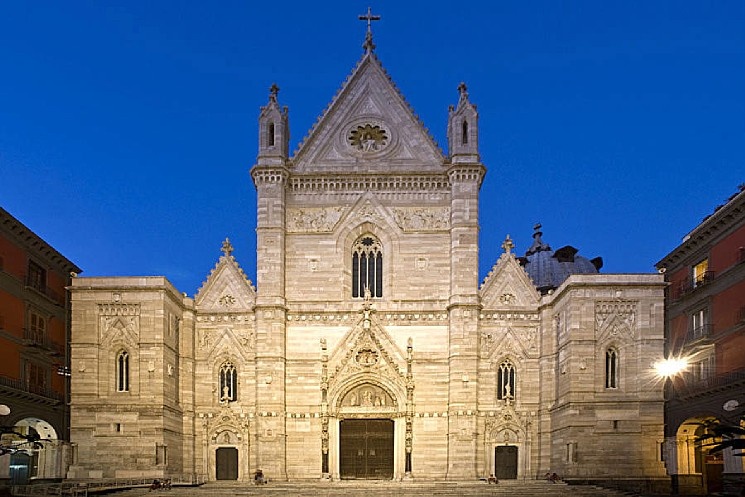
Although dating back to the late 13th century, the cathedral has been altered considerably due to earthquakes and restoration, especially after the one of 1456, but the 1407 doorway in the center of the front has survived. In the south aisle is the sumptuous 17th-century chapel of San Gennaro , patron saint of Naples. On its main altar, a silver bust contains the skull of the saint, who was martyred in 305, in the time of Diocletian . In the tabernacle are two vessels containing the saint’s blood, which is believed to have the power of liquefaction, celebrated with solemn ceremonies in the cathedral each September 19.
7. Piazza del plebiscito
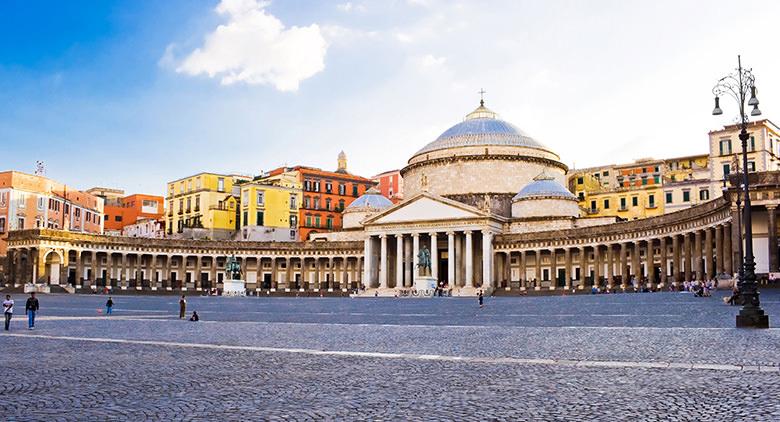
When looking for things to do in Naples you should include a visit to its largest piazza . At six acres, this public space is a gathering spot for a casual stroll, a backdrop for large scale art installations, a phenomenal New Year’s Eve celebration, and a stage for world famous singers and performers. Here visitors will find the Palazzo Reale , a 30-room Royal House Museum, as well as Biblioteca Nazionale Vittorio Emanuele III , the largest library in southern Italy.
6. Mount Vesuvius and Pompeii ruins
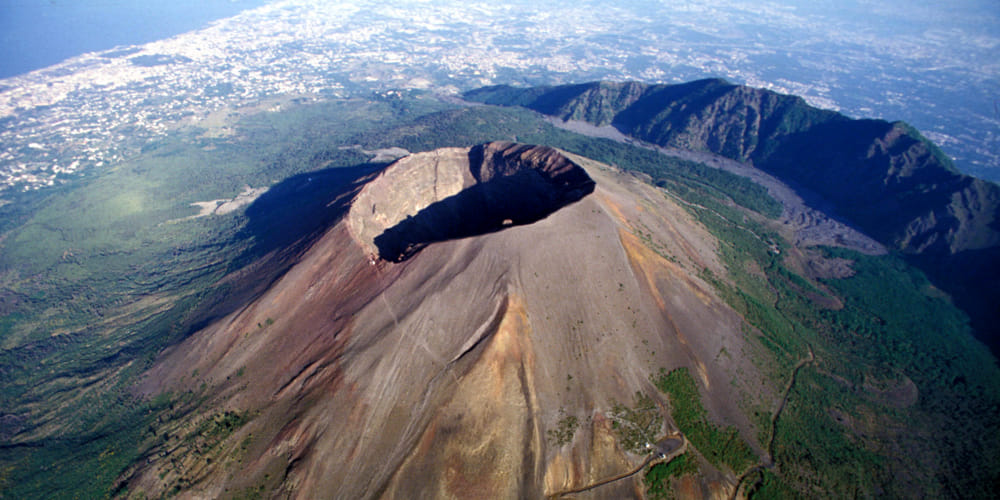
Mt. Vesuvius known for covering Pompeii with ash, rock and lava 2,000 years ago (and which last erupted in 1944) is just 10 kilometers (6 miles) from Naples. There are tour buses that can take you directly to the car parking lot, or for those who prefer to travel more independently, it will be a short train trip and a bus. This is a Naples attraction not to be missed.
Find out how to book ❯
5. National Archeological Museum
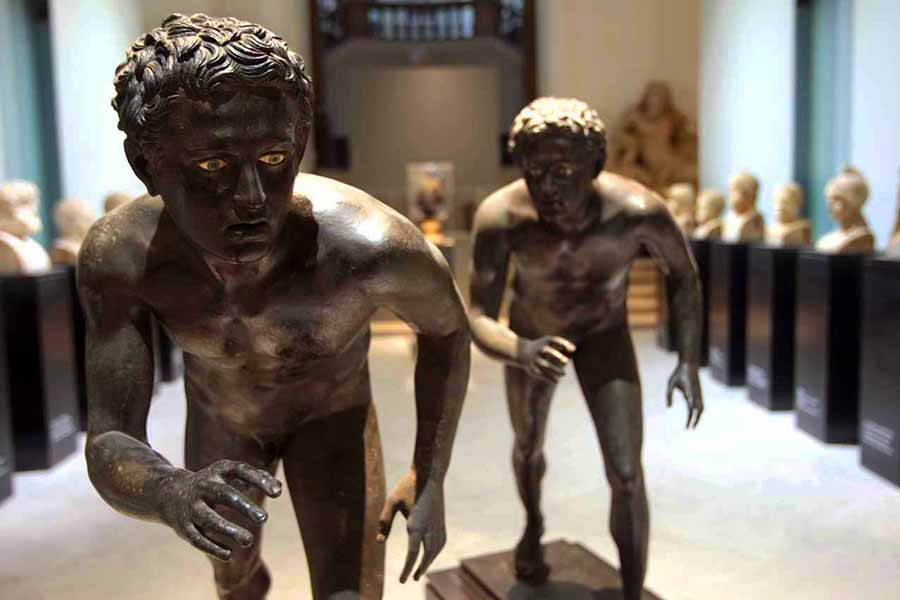
Originally the museum was an horse riding school, then the location of the University. The Archeological Museum was inaugurated in 1816 and nowadays it’s one of the most important museums of the world because of the quality and quantity of works exposed. Many of the objects come from excavations at Pompeii and other nearby archaeological sites.
4. Veiled Christ at Cappella Sansevero

Carved in 1753 by Giuseppe Sanmartino , it shows the figure of Christ lying under what looks like a piece of the thinnest of fabrics. The facial features are clearly visible, as are the body and even the crucifixion wounds, but the entire body is covered by the delicate folds of a cloth. The visual effect is truly stunning. There are two other sculptures of note in the Capella Sansevero , each dedicated to one of the parents of the man who commissioned them and built the chapel, but it’s the Veiled Christ which rightfully commands all the attention.
3. Castel dell'Ovo
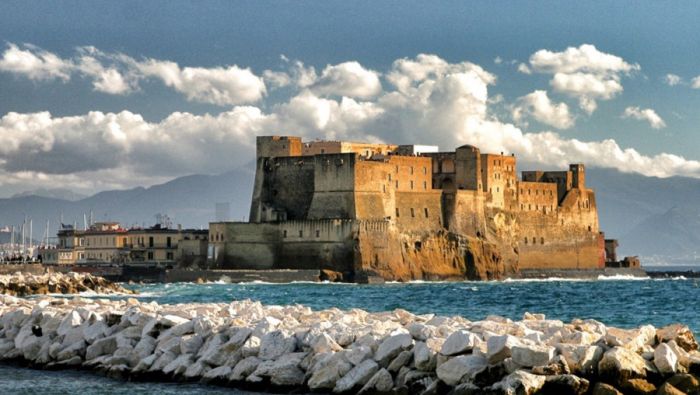
The Castel dell’Ovo is the oldest standing fortification in Naples. The castle’s name comes from a legend about the Roman poet Virgil , who had a reputation in medieval times as a great sorcerer and predictor of the future. In the legend, Virgil put a magical egg into the foundations to support the fortifications. Had this egg been broken, the castle would have been destroyed and a series of disastrous events for Naples would have followed.
2. Walk along Spaccanapoli - Unesco World Heritage Site

The city of Naples comes alive in all its splendor, chaos and charm on the street colloquially known as Spaccanapoli , or “ Via San Biagio ”. It is the main street that divides Naples and is the heart of the historic center. Begin in the Piazza del Gesù Nuovo and discover the traditional pizzerias and pastry shops, as well as some of the best monuments and churches in the city. Via San Gregorio Armeno , off Via San Biagio , is famous for its nativity workshops and stores .
1. Eat Pizza

It may sound weird that the first thing to do or see in a city is actually something to eat, but this is, after all, the birthplace of pizza (probably Italy’s most popular food export) and the locals take their signature dish very seriously. Make sure you go to a pizzeria that’s serving “pizza vera napoletana,” true Neapolitan pizza , and you’ll be good to go. See recommended Pizzerias on Visit Naples.
We recommend the purchase of Naples Pass , the official digital tourist card of Naples: unlimited transportation, discounts in museums and free pizza .
Find out more about Naples Pass ❯
Is Hotel Not Hotel a hotel? Or is it one of Amsterdam’s newest restaurant and bar hot spots? You decide! Autore della citazione

Los Angeles
LA is always so much fun!

La Pizza migliore del mondo

Ti consigliamo
Lascia un commento.

Scopri subito come risparmiare!
RELATED LINKS
On this page, naples hotels, getting around naples, sightseeing & tours, transport from naples.

- Rome hotels
- Venice hotels
- Florence hotels
- Naples hotels
- Pisa hotels
- Sorrento hotels
- Rome Fiumicino Airport
- Rome Ciampino Airport
- Venice Marco Polo Airport
- Pisa Airport
- Naples Airport
- Civitavechia (Rome) Cruise Port
- Naples Cruise Port
- Rome public transport
- Venice water bus (vaporetto)
- Florence public transport
- Naples public transport
- Sorrento local buses beyond Amalfi
Naples sightseeing & attractions of great historical interest
Overview of major historic sights in naples, a city of poverty, culture and contrast.
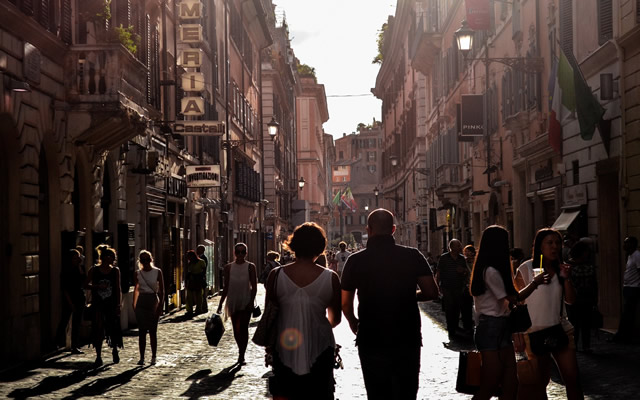
Naples unique city experience
Let's face it, the main attractions that draw people to Naples, namely Pompeii , Mount Vesuvius and Herculaneum are outside the city and indeed we give each of these their own dedicated pages.
But the City of Naples is worth at least a day of anyone's time and if you are into museums, art, architecture or culture much longer.
Yes, the City of Naples has its museums, cathedral and other religious monuments but perhaps suffers from Naples being in Italy. Anywhere else, many of these would be show-stoppers but visitors reach Naples after having visited Rome and Florence a day or so before. So the contrast is unfair.
What Naples does offer is its own unique city experience. Your expectations may be slightly confused. Isn't this a very poor city, lots of poverty and will I be safe?
It is also a modern city too, a thriving port, a playground for the rich and famous in the nearby island of Capri with cultural museums and great churches.
Naples is all of that, a city of diverse experiences. It can be raw at times, but pleasantly so. It's not neatly packaged for modern tourism and to be treated like a theme park. The only real way to explore the city is independently and walking most of the time.
Below are the main attractions your favourite guidebook will point you towards and they are indeed a fine framework to frame your visit around.
You will be rewarded though if you don't organise a tight itinerary to be followed with military timing. Try to expect the unexpected and have contingency to indulge in whatever hidden personal treasure you find.
Getting around Naples City Naples Cathedral Spaccanapoli Santa Chiara church National Archaeological Museum Naples Piazza del Plebiscito San Martino Unico Artecard Campania
Getting around Naples City
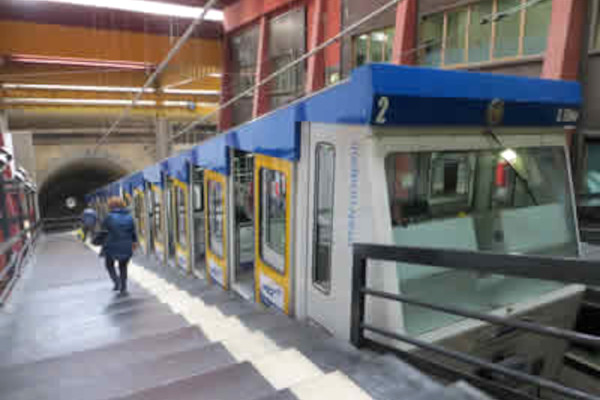
Whether you arrive at the Central Station or the ferry/cruise port or are lucky enough to stay in a hotel in central Naples you may well be fine just walking everywhere. All the main sights are easily walked to from any point in the centre.
As ever there is a Naples open top hop-on hop-off sightseeing bus that visits all the main sights along three separate routes.
There is a good local bus network and it's conceivable you might use the limited Metro for a short ride.
How you can access the network is explained on City of Naples public transport page .
The public transport maps have the main sights marked too and are a good way of getting orientated with relative locations.
One public transport option you may well want to take is one of the funicular railway up to San Martino for great views. The funicular is an attraction in its own right.
If you can, try and walk back down into the city via one of the many steep walkways getting glimpses of everyday neighbourhood Naples.
Top of the page
Naples cathedral (duomo di san gennaro).
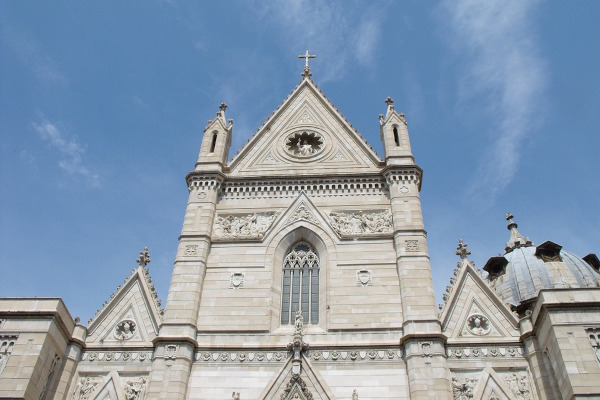
A Gothic cathedral built in the 13th century in the north east sector of the historic centre, about a 10-minute walk from Central Station, though local buses go to the door.
The cathedral is dedicated to Naples patron saint San Gennaro or Saint Januarius. A vial of the saint's blood is brought out three times a year - on the first Saturday in May, September 19 and December 16 - and if it liquefies, all is well. If it doesn't... fears are held for the safety of Naples. Luckily, it nearly always liquefies.
The cathedral contains some excellent artworks including frescoes. o one side of the cathedral is the 4th century Basilica Santa Restituta, the oldest chapel in Naples. Under here is an interesting archaeological site tracing the Greek, Roman and early Christian city.
Spaccanapoli and Via Tribunali
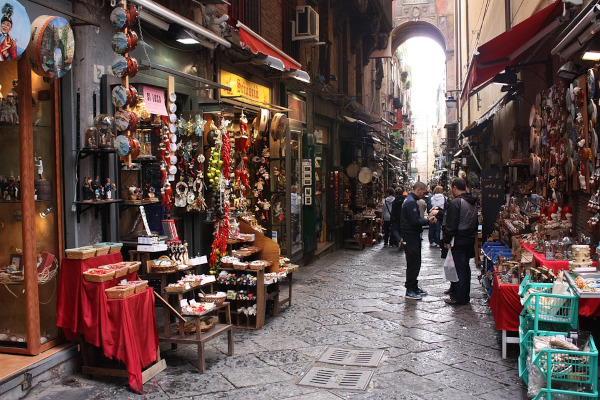
The Spaccanapoli and Via Tribunali form the east-west pedestrian spine of the historic centre of Naples and with good reason most visitors head for and perhaps linger more than they scheduled.
Originally the heart of the Greek and Roman city, the Spaccanapoli district is a string of narrow, winding streets and is mainly a pedestrian zone. The area has arcades dating back more than 1,000 years.
As a tourist honey-pot there is a fair share of tourist tat but the scale of this area is huge and the tight alleys reveal something of interest around almost every corner, especially if you look up as well as from side to side.
If you venture away from the Spaccanapoli and Via Tribunali tourist area, perhaps around Spacuano Castle, some of the alleys may not look as inviting and safe.
Santa Chiara church
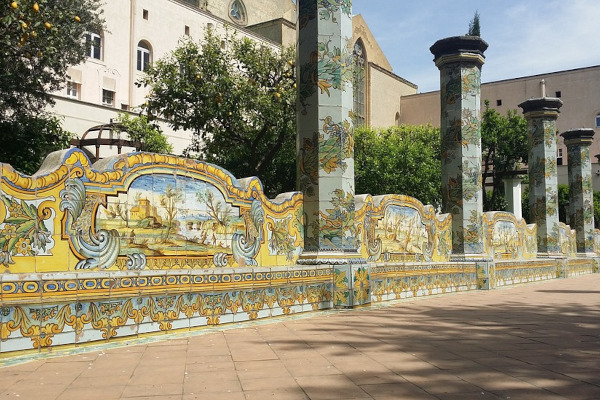
As you might expect in the old historic centre there are plenty of churches, with many worthwhile to visit. Santa Chiara is one of these and sits on the Spaccanapoli in the south west sector of the historic centre.
Santa Chiara Church is part of a large complex that includes a monastery with beautiful cloisters decorated with majolica tiles and frescoes and an interesting archaeological museum.
The National Archaeological Museum of Naples
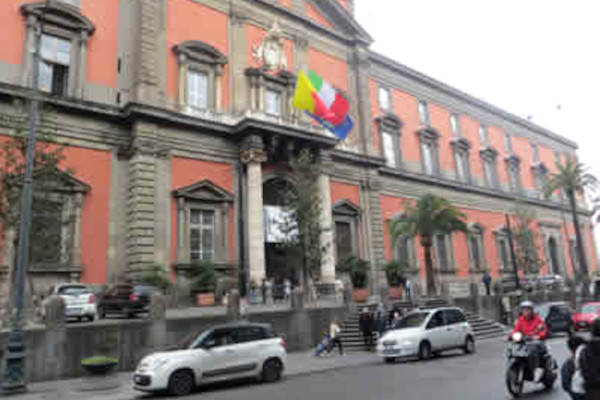
The Naples Archaeological museum is one of Italy's top archaeology museums drawing many of its exhibits from Pompeii and Herculaneum outside the city.
The museum has one of the world's best collections of Greek and Roman antiquities, including mosaics, sculptures, gems, glass and silver, and a collection of Roman erotica from Pompeii.
The museum is at the north western periphery of the historic district and is served by a Metro Station (Museo) that is of limited use for visitors as well as buses.
Piazza del Plebiscito
Piazza del Plebiscito is the center of modern Naples, just south of the historic centre and only 5 minutes' walk from the cruise/ferry terminal. San Francesco di Paola, on the piazza, is a huge domed church. Palazzo Reale, the Royal Palace, is across the square. Inside you can visit the restored rooms and royal apartments and visit the roof garden where there are good views of the bay.
San Martino
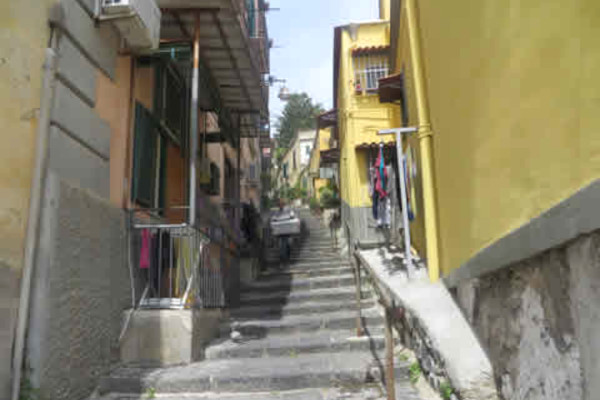
San Martino is on top of a steep hill just west of the historic centre. The excuse you need to come up here is the Museum and Monastery of San Martino from where there are great views of the entire city of Naples spread out below you.
Take the Funicular Centrale, one of the longest in the world that leaves from Via Toledo by Galleria Umberto, just north of Piazza del Plebiscito for another great experience.
An equally good experience is to walk back down the hill not via the circuitous roads but by the many walkways/steps. There is a walkway down immediately in front of Piazza San Martino by the entrance to the museum that winds down past old houses with no vehicular access to the historic centre below. More scenic options are on the other side of the hill where you will see steps marked on most of the tourist maps.
San Martino Museum is housed in the Certosa di San Martino a large monastery complex dating from 1368 next to Sant Elmo Castle, which you can also visit. Museum exhibits are housed in the former living quarters of the monks.
Expect paintings and sculptures from the 13th-19th centuries, the museum is famed for Neapolitan nativity scenes. The monastery gardens have fruit trees, flowers, fountains and magnificent views.
Unico Artecard - 3 day tourist pass for Naples, Pompeii etc, including public transport
Aimed squarely at the visitor to Naples this pass combines public transport in Naples for 3 days, (including the Naples airport bus) plus entry to two attractions from a long list that includes the National Archaeological Museum in Naples and Pompeii and Herculaneum.
From the third attraction onwards you enjoy up to a 50% discount on standard tickets.
NAPLES CAMPANIA ARTECARD

• Digital pass • Get free entry to 2 of over 40 sites in Campania • Exclusive discounts on your third site • FREE travel on public transport for duration of pass • Access to exclusive events
MOST POPULAR NAPLES TOURS 2024
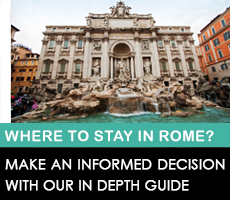

16 Top-Rated Tourist Attractions in Naples & Easy Day Trips
Written by Barbara Radcliffe Rogers Updated Mar 23, 2023 We may earn a commission from affiliate links ( )
Even if you've been to many Italian cities, nothing prepares you for the exuberant, colorful, and sometimes chaotic hubbub of Naples. The entire population seems to be in the streets that spill down into its harbor, and they're all talking at once.
Colors here seem brighter, and aromas of pizza–Neapolitans claim to have invented it–waft through the air, along with operatic areas (everyone here is a tenor waiting to be discovered), laughter, and maybe an argument or two. It's a city that will keep all your senses busy.
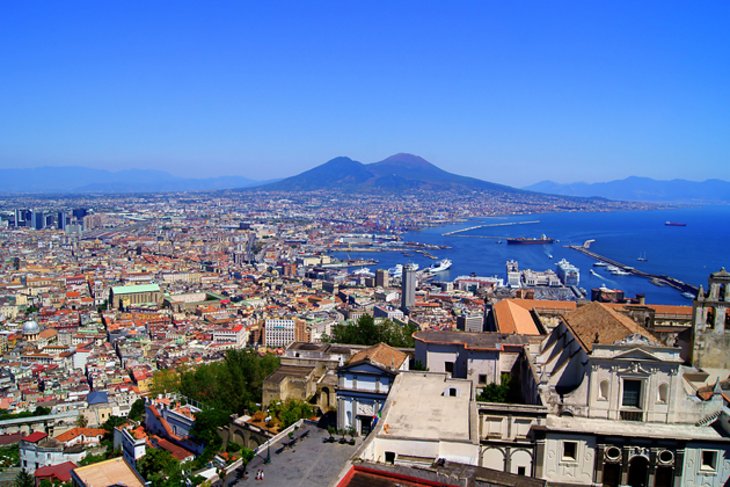
That's not to say it doesn't have a bounty of things to do and attractions for tourists. One of the world's finest archaeological museums holds the treasures of nearby Pompeii , and much more. For centuries, Neapolitans have lavished attention and riches on their magnificent churches, while royalty of several great houses of Europe have decorated its palaces.
The city's long history, dating back to the Greeks in the eighth century BC, included Byzantine, French, Spanish, and Austrian rule, each of which left its mark. And beyond the churches, palaces, and museums , the narrow neighborhood streets, broad promenades, and parks you'll find while exploring Naples are sights in their own right. Find more great places to visit here and nearby with our list of the top tourist attractions in Naples.
See also: Where to Stay in Naples
1. Castel Ovo and the Lungomare
2. national archeological museum, 3. cappella sansevero, 4. capodimonte royal palace and museum, 5. castel nuovo, 6. catacombs of san gennaro, 7. shopping for presepi on via san gregorio armeno, 8. palazzo reale (royal palace), 9. teatro di san carlo, 10. shopping at galleria umberto i, 11. san martino monastery and museum, 12. cathedral, 13. galleria borbonica (bourbon tunnel), 14. san domenico maggiore, 15. santa chiara, 16. exploring santa lucia, where to stay in naples for sightseeing, day trips from naples, herculaneum, amalfi coast, caserta palazzo reale, benevento and the arch of trajan, castellammare di stabia, map of tourist attractions in naples & easy day trips, naples, italy - climate chart.
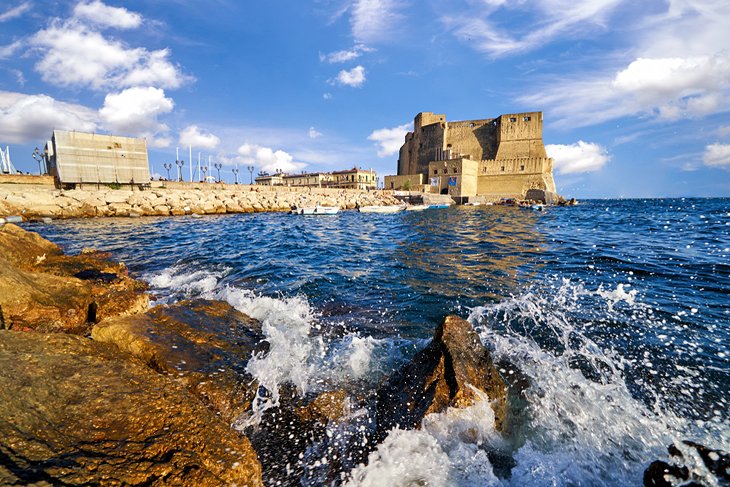
Along the waterfront, at the historic gateway to the Mediterranean and the world, you can get a feel for this vibrant city. Naples harbor is divided into separate docks and basins by a series of piers and breakwaters, and is always bustling with activity.
The Lungomare is a beach promenade that follows the shore for about 2.4 kilometers along Via Partenope and Via Francesco Caracciolo in the Chiaia neighborhood, with beautiful views across the bay to Vesuvius and plenty of cafés and ice-cream shops. Stroll here, enjoy the views and lively atmosphere, and sample Naples' contribution to food history–margherita pizza.
Sitting on a promontory at the end of Via Francesco Caracciolo is the 12 th -century Castel Ovo, the oldest castle in Naples. The views of the harbor, ferries, bay, and Mt. Vesuvius are even better from its ramparts, and inside is an Ethno-Prehistory Museum with ceramics and other artifacts from ancient Naples. There is no charge for admission to the castle and museum, which, like the Lungomare, are among several free things to do in Naples.
Beyond the castle lies the busiest part of the Port of Naples, with the cruise port and departure point for ferries to Sicily, Sardinia, and elsewhere. Farther south, from the quay on the Calata di Beverello, boats sail to Ponza, Capri, and Ischia. Naples is the principal port for southern Italy, and the harbor is its heart.
Official site: http://www.castel-dell-ovo.com
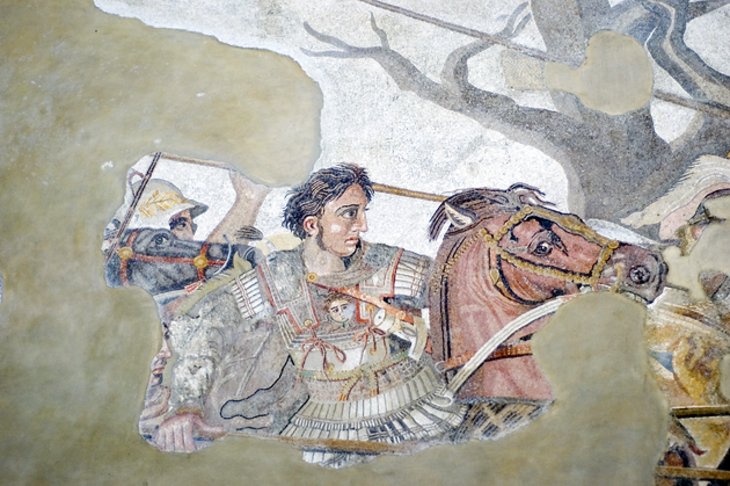
The Museo Archeologico Nazionale holds one of the world's finest collections of antiquities, many of which were brought here from early excavations of Pompeii. In fact, more of the city's artistic highlights are here than at the site itself. In addition, it has the art treasures of the kings of Naples, the Farnese collections from Rome and Parma, the collections from the palaces of Portici and Capodimonte, and material from Herculaneum and Cumae.
The ground floor is devoted mainly to marble sculptures, including the Farnese Hercules, a colossal 3.17-meter statue found in the Baths of Caracalla in Rome, and the Farnese Bull, the largest marble group that has come down from antiquity. On the mezzanine is the collection of ancient mosaics from Pompeii , including the famous 6.20-meter Alexander's Battle .
On the first floor (second floor to Americans), in the central Salone dell'Atlante, is the Farnese Atlas. Here, too, is the collection of bronze sculpture from Pompeii (recognizable by the green oxidation) and Herculaneum (with a dark patina). Look especially for Apollo Playing a Lyre , a 5th-century original from the Peloponnese, found in the Casa del Citarista in Pompeii.
Also on this floor is the remarkable collection of ancient wall paintings, mainly from Pompeii but also from Herculaneum and Stabiae. The bronze household utensils and other bronzes, terra-cotta vessels, and a large model of Pompeii are worth seeing, too.
Address: Piazza Museo 19, Naples

The Cappella Sansevero was built in 1590 as the private chapel of the Sansevero family and later became its burial chapel. In the 18th century, it was elaborately embellished in Baroque style by the eccentric mystic Raimondo di Sangro, Prince of Sansevero.
Of the sculptures that he commissioned, the most outstanding artistic features are in the ethereal Veiled Christ by Sammartino (1753) and two others that show the figures draped in what appears to be a translucent tissue of marble. Another, also carved from a single block of marble, shows a male figure partially wrapped in a net, free falling in places and so intricately carved that it seems impossible that it's really made of stone.
The chapel's most unusual exhibits are the pair of Anatomical Machines, demonstrating the human circulatory system and muscles, built on actual skeletons using wire, silk, and beeswax. Needless to say, the Prince's strange collection, added to all the Masonic symbols he incorporated into the chapel, gave rise to dark rumors about him and the scientific experiments he carried out in his adjoining palace.
Address: Via De Sanotic 17/21, Naples
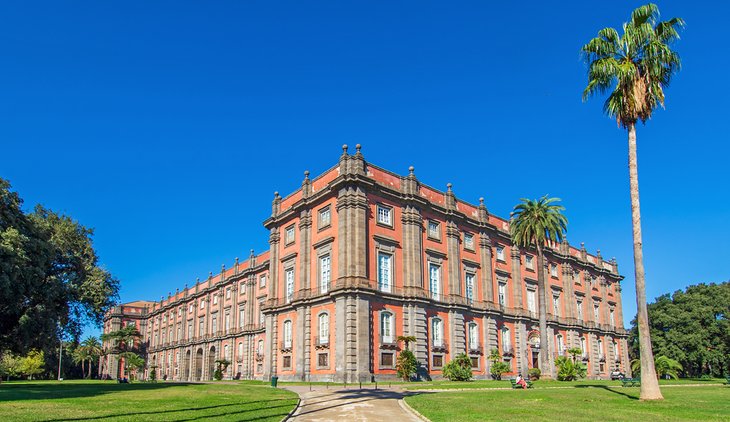
Intended originally as a hunting lodge for King Charles III, the Palazzo Reale di Capodimonte grew to become the royal residence and a place for the king to house the Farnese collection, which he had inherited. The collection includes portraits of members of ruling families by Titian and formed the basis for the National Gallery (Galleria Nazionale), one of the finest art collections in Italy, now housed here.
Its more than 500 pictures include, in addition to the Titians, works by Mantegna, Caravaggio, Raphael, Botticelli, El Greco, Bellini, and Neapolitan artists of the 17th and 18th centuries.
In the royal apartments, you'll find furniture, tapestries, and porcelain used in the palace during the Bourbon and Savoy dynasties. The small room, Salottino di Porcellana , is completely lined with porcelain.
In the park that surrounds the palace, which was the royal hunting grounds, King Charles III founded the Capodimonte workshops to produce ceramics. This highly decorative work became quite famous, and you'll see products of the workshop at the convent Santa Chiara. Wander in the beautiful park, along avenues shaded by huge trees, past battered statues and a pond.
Address: Via Milano 2, Naples
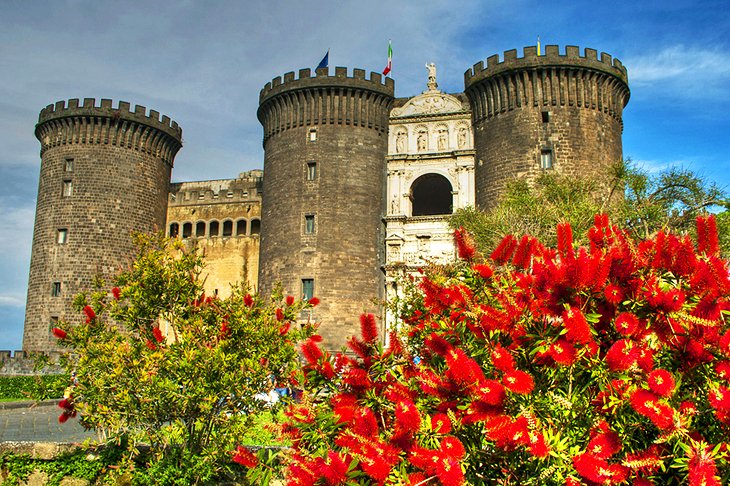
On the south side of the Piazza del Municipio, the five-towered Castel Nuovo, also known as the Maschio Angioino, was the residence of kings and viceroys of Naples. Its history reflects the various rulers–French, Aragonese, Spanish, and Austrian-–each adding and renovating to suit the times.
It was originally built by Charles I of Anjou in 1279-82, and was enlarged by Alfonso I of Aragon, who had the grand Early Renaissance Triumphal Arch between the towers added between 1453 and 1467 to celebrate his victorious entry into the city. Parts of it are used for events and expositions, but the Armoury Hall, the southern courtyard, the Charles V Hall, and the Sala della Loggia are usually open. In the courtyard is the Gothic church of Santa Barbara (or Cappella Palatina).
Address: Piazza Castello, Naples
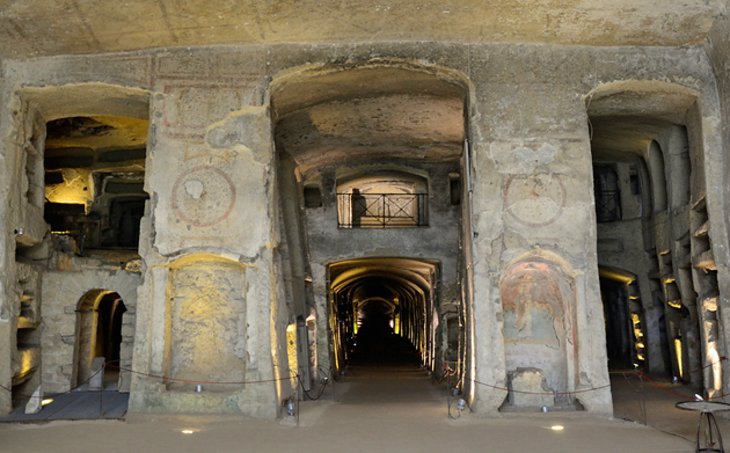
The second-century Catacombs of San Gennaro, like the Roman catacombs, are a maze of passages and tomb chambers but are more ambitious architecturally and have finer paintings than their Roman counterparts.
There are two levels of these, and in the upper catacomb's vaulting are frescoes from late in the second century. Here, too, is the small Crypt of the Bishops and the large underground basilica, with three naves cut into the stone and decorated with frescoes from the fourth through sixth centuries.
The basilica was built near the catacombs in the fifth century, and although it has undergone several changes, it is a rare example of early Christian architecture. Even after major renovations during the Aragonese era in the 14th and 15th centuries, its basic structure of three naves and a semi-circular apse remains.
Address: Via Capodimonte 13, Naples
Official site: http://www.catacombedinapoli.it/en/places/catacombs-of-san-gennaro-naples?ref=ok
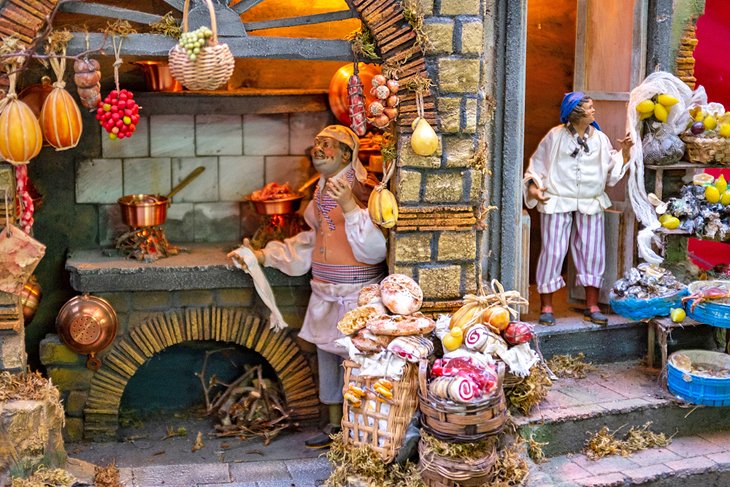
If you are looking for souvenirs that are unique to the city, terra-cotta Nativity figures are the best things to buy in Naples. But a stroll along Via San Gregorio Armeno is more than a chance to do some shopping in Naples, it is an experience in local life and culture.
During December, you'll find Nativity scenes, called presepi, in churches and public places all over Italy, but nowhere are they so elaborate as in Naples. The best-known craftsmen are here as well, and you will be astonished at the variety and finesse of some of these figures they create.
In Italy these presepi contain far more than the figures central to the night in Bethlehem. You'll find animals, buildings, shops, children, and entire villages of everyday activity surrounding the scenes, made of wood, ceramic, terra-cotta, plaster, and other materials, some dressed elaborately in sumptuous fabrics.
Miniature collectors will find tiny furniture, foods, animals, even entire shops and rooms. The most typical of Naples are the figures made of terra-cotta, and you'll find some of the most artistic at the studio of Giuseppe and Marco Ferrigno.
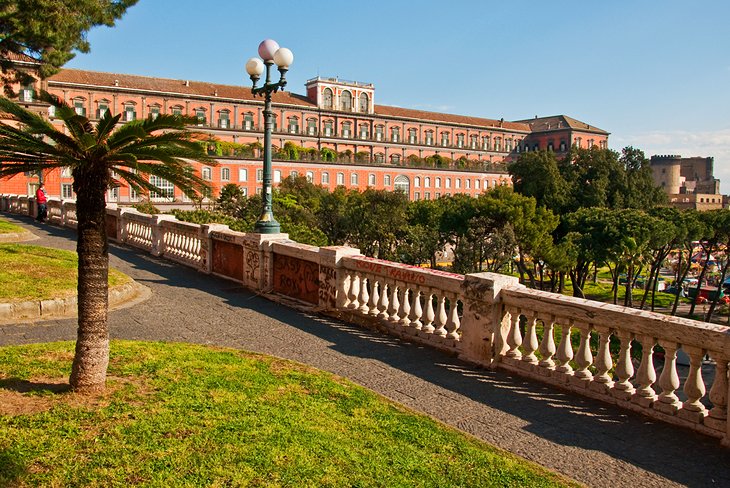
Along the east side of Piazza del Plebiscito is the former Royal Palace, begun in 1600 by Domenico Fontana and restored from 1837-41. It is one of four palaces in the area that were used as residences by the Bourbon kings. On the long facade are eight marble statues of the various kings who ruled Naples.
Inside, you can see the grand staircase of white marble, built in 1651, a theater, and more than two dozen rooms in its state apartment, with furniture, tapestries, porcelains, and sculptures. It's rarely crowded, inexpensive, and you get a free audio tour. Many tourists consider this one of Naples' most interesting and unsung attractions.
Address: Piazza Plebiscito, Naples
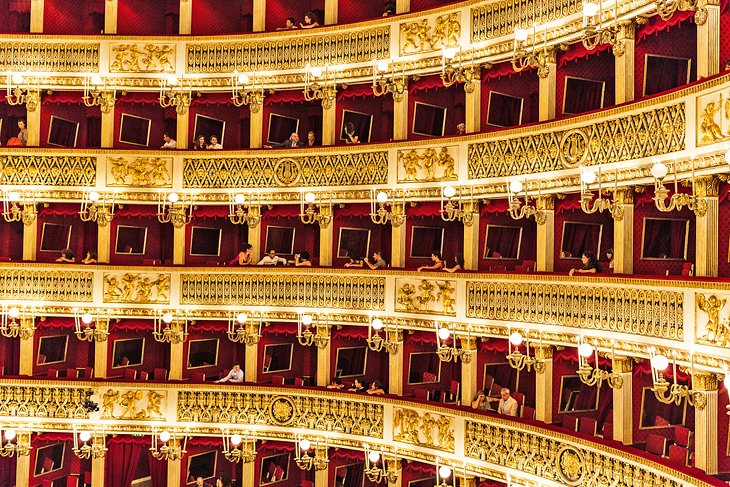
One of the largest theaters in Europe and one of Italy's premier opera houses, the Real Teatro di San Carlo was built by King Charles of Bourbon, adjoining his Royal Palace. It was completed in 1737, and along with being the oldest continuously active opera house in Europe, it was the model for opera houses everywhere. Six levels of ornately decorated boxes surround the interior, highlighted by the even more lavishly ornate royal box.
In addition to operas, performances include concerts and ballet. Along with its outstanding acoustics, San Carlo has the reputation of attracting the noisiest and worst-behaved audiences in Italy. Woe betides the tenor who misses his high C here.
Address: Via San Carlo 98, Naples
Official site: http://www.teatrosancarlo.it/en
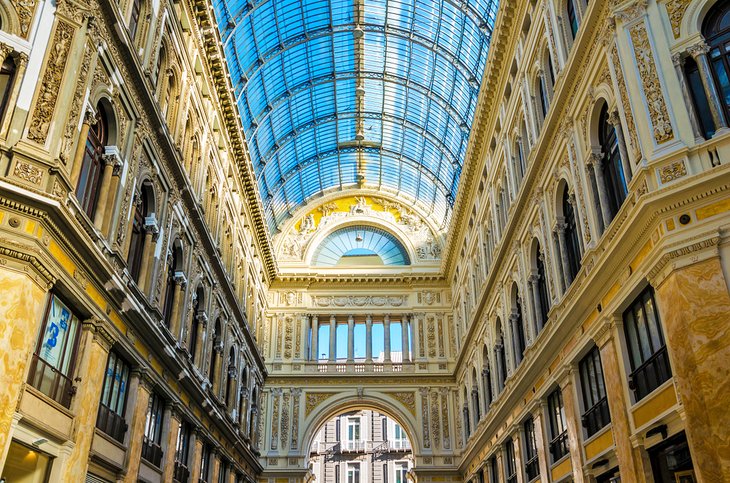
Whether or not you are a dedicated shopper, you'll want to see this popular attraction for its architecture and grandeur. Built between 1887 and 1891, Galleria Umberto I was named for Umberto I, then King of Italy. Designed as a public place for shopping, businesses, cafés, and social space, the tall building has four wings with iron and glass vaulting. These converge at the center under a glass dome, for spectacular effect.
One of the wings opens onto the San Carlo Opera House. Although the Galleria is no longer the center of Naples' café society, it is still a lively place to visit, with shops, restaurants, and cafés. The interior is decorated with sculptures and paintings.
Address: Via San Carlo 15, Naples, Italy
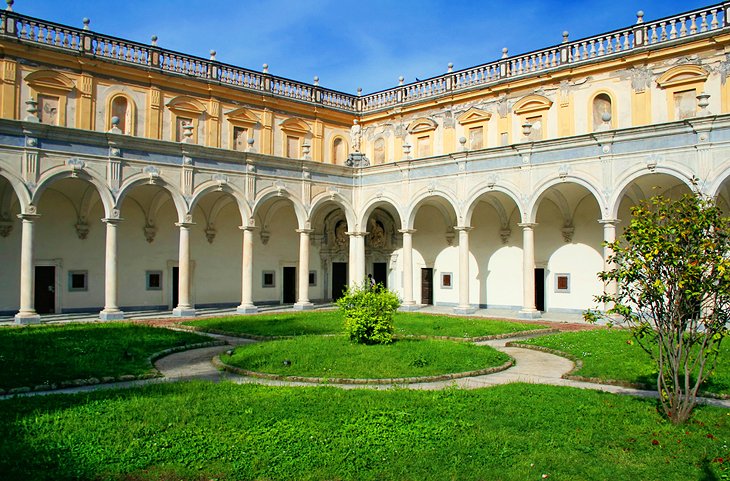
The former Carthusian monastery of San Martino, built in 1325 and rebuilt in the 17th century, also houses the Museo Nazionale di San Martino. The church, where you should also be sure to see the sacristy and treasury, is richly decorated with marble, ceiling frescoes, and paintings from the 17th and 18th centuries.
There are two cloisters, the Chiostro dei Procuratori and the main cloister, which is surrounded by 60 white marble columns. The monastery makes a good setting for the museum, which contains porcelain, an 18th-century state coach of Charles III's reign, and various historical relics from Naples and southern Italy in the 18th and 19th centuries.
If you're not in Naples during the Christmas season, when most churches are displaying the magnificent Nativity scenes (presepi) for which Neapolitan craftsmen are famous, you'll have a chance to see a collection of them here. It includes the Presepe di Cuciniello , an astonishingly detailed depiction of the Nativity with finely-carved animals, buildings, and figures dressed in intricately ornamented fabric costumes. From the Belvedere, superb views of Naples and its bay extend to Vesuvius and the island of Capri.
Address: Largo di San Martino 5, Naples
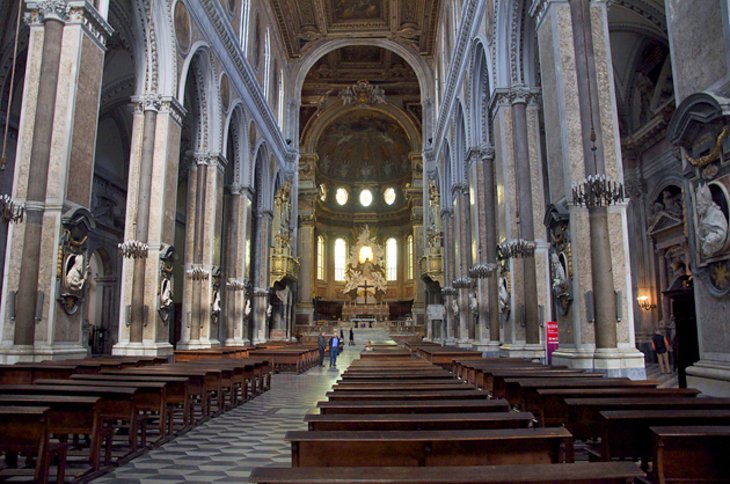
Although dating back to the late 13th century, the cathedral has been altered considerably due to earthquakes and restoration, especially after the one of 1456, but the 1407 doorway in the center of the front has survived. In the south aisle is the sumptuous 17th-century chapel of San Gennaro, patron saint of Naples. On its main altar, a silver bust contains the skull of the saint, who was martyred in 305, in the time of Diocletian.
You can see the saint's tomb in the richly decorated Confessio (1497-1506) under the high altar, and in the underground archeological area, you can see the 4th-century Basilica Santa Restituta , the oldest church in Naples, with excellent ceiling frescoes and columns from a Roman temple.
The Archbishop's Palace and several other churches surround the cathedral, among them the Gothic Santa Maria Donnaregina, with fine 14th-century frescoes by Giotto's contemporary Pietro Cavallini in the elevated nuns' choir, and the Baroque churches of San Filippo Neri and San Paolo Maggiore. Underneath the restored Gothic church of San Lorenzo Maggiore (1266-1324), an archaeological site allows visitors to see layer upon layer of civilization: Greek, Roman, Byzantine, and medieval.
Address: Via del Duomo, Naples
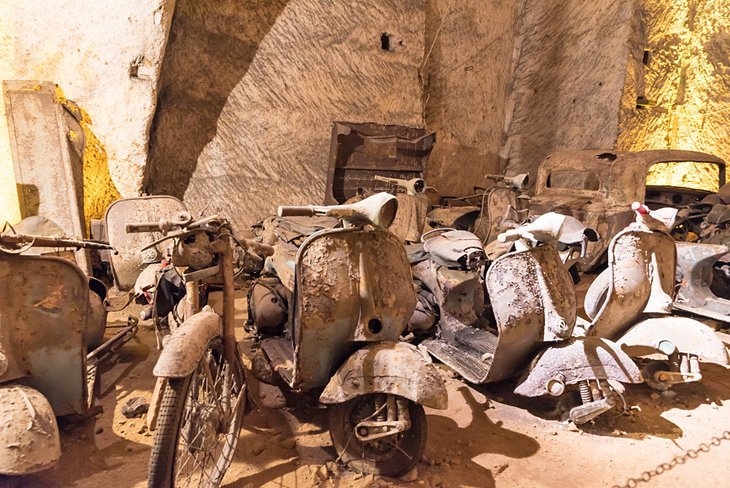
Definitely one of the most unusual things to do in Naples is exploring the unfinished underground passage known as the Galleria Borbonica–the Bourbon Tunnel. It was begun in the 19 th century, on the instructions of King Ferdinand II, as a way for him to escape from the Royal palace to the safety of the military barracks on what is now Via Morelli.
It was never finished, but the carved tunnels were later used as an air raid shelter and emergency hospital during World War II.
Access to its huge galleries and spooky tunnels is by tour, during which you can see the cisterns and a variety of relics and debris from its various uses, including old cars, Vespas, motorcycles, and fragments of statuary and architectural detail.
Address: Vico del Grottone No. 4, Naples
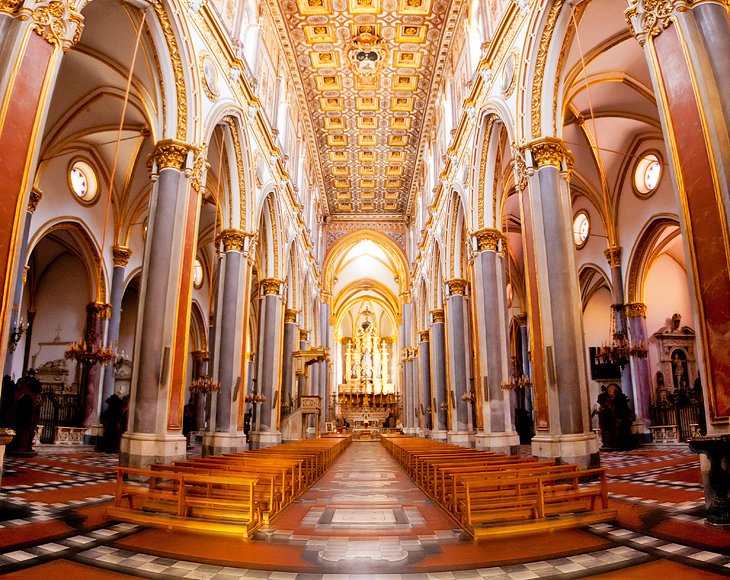
San Domenico Maggiore, built about 1300, is among the most beautiful and interesting churches in Naples, filled with Early Renaissance work. The ornate paneled ceiling leads your eyes directly to the high altar by Cosimo Fanzago.
Each of its 24-sided chapels contains something of interest, especially the Chapel of San Michele Arcangelo a Morfisa at the end of the right nave, which incorporates a 10th-century church. In the Cappellone Crocifisso are a 13th-century Crucification and the 15th-century Burial of Christ.
Beyond the chapel dedicated to Saint Thomas Aquinas (who studied here) is the sacristy, with a frescoed ceiling, Triumph of Faith over Heresy by the Dominicans , and a gallery of 45 sarcophagi belonging to members of the house of Anjou.
Address: Piazza San Domenico Maggiore, Naples
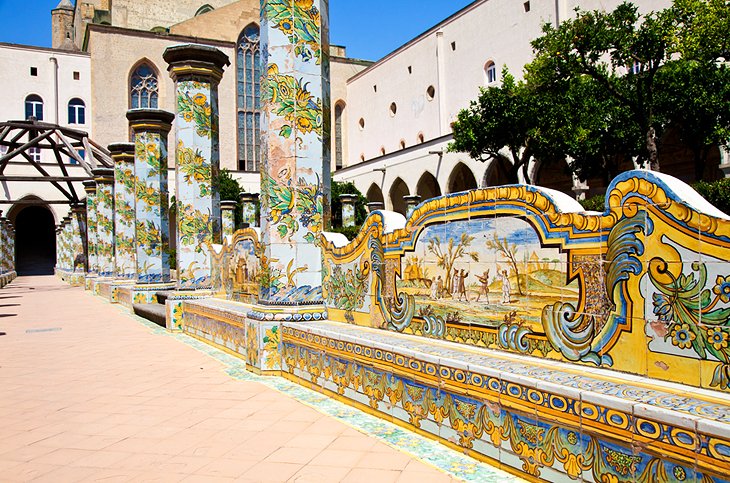
The cloister of the Monastery of Santa Chiara, founded in 1310, looks more like a park in a seaside resort town than a solemn retreat for nuns. Majolica tiles made at the Capodimonte workshops, in vivid colors and lively designs, cover the 66 octagonal columns surrounding its cloister, and between the columns are long benches also covered in tiles.
These seem to bring the secular world inside the monastery walls, with scenes from everyday life of their period–the mid-1700s. Under the porticos, the walls on all four sides of the cloister are covered with 17th-century frescoes of Old Testament scenes.
There are more reasons to visit Santa Chiara besides its surprising and beautiful cloister. Inside on the right is a presepio (Nativity scene) set in a Roman ruin, incorporating mundane daily Neapolitan life along with the sacred creche scene. The figures are dressed in typical local 18th- and 19th-century clothing. The setting in a Roman ruin is thought perhaps to reflect the intense interest in the discovery of Herculaneum in the early 18th century.
While repairing damage after World War II, the intact remains of a first-century Roman thermal spa were discovered, probably part of a villa. This and other finds from the first through fourth centuries make up a small archaeological area and museum.
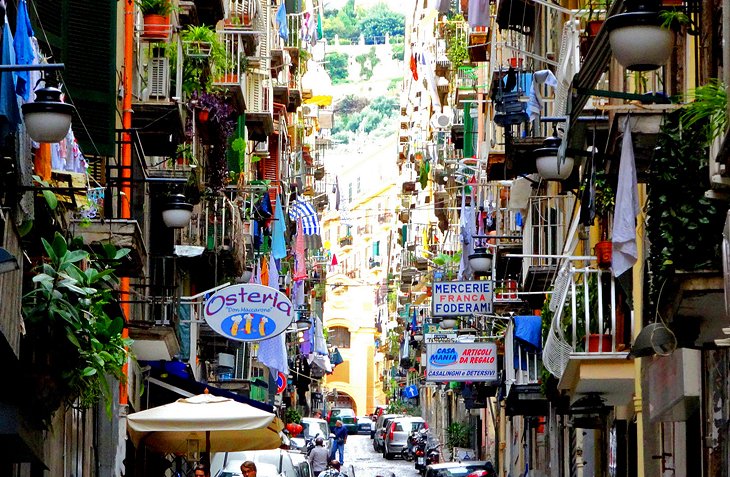
To the west of the Piazza del Plebiscito, on the slopes of Pizzofalcone and extending down to the sea, lies the district of Santa Lucia. South of the wide Via Santa Lucia, this is an area of modern streets laid out on a regular plan, but to the north, it is a picturesque huddle of narrow, stepped lanes where you can see–and be part of–traditional Neapolitan life.
It would be a shame to miss this very real neighborhood of shops and bakeries, artisans' workshops, little cafés where locals down their espresso, and streets where children play. Laundry usually hangs overhead, and conversations are carried on between balconies and windows across the narrow streets. It's a colorful place any time of day, but especially lively in the evening, making it one of the favorite things to do at night in Naples.
Popular tourist attractions in Naples are widely scattered, but two areas are convenient to several of them. These areas are not far apart, so your choice may depend on whether or not you enjoy being in a typical–and colorful–Neapolitan neighborhood throbbing with city life.
If you like feeling the pulse of a passionate city, crowded Decumani is for you, close to the Duomo, Archeological Museum, and several churches. The quieter option is the waterfront Chiaia neighborhood, the part of the more colorful Santa Lucia district, near the Palazzo Reale and the San Carlo opera house. Here are some highly rated hotels in and around these areas:
Luxury Hotels
- A Naples landmark for its elegant style and seafront setting in Chiaia, Grand Hotel Vesuvio caters to film stars and royalty. Its top-floor restaurant is the place for celebratory occasions, with its romantic views of the twinkling harbor lights.
- In the same upscale area and close to chic shops and dining is the Hotel Palazzo Alabardieri , a good choice for anyone planning on shopping in Naples.
- With the same waterfront location and views from the guest rooms, but lower rates, the 4-star Grand Hotel Santa Lucia has upscale amenities such as room service and a concierge. Many of the rooms and suites have balconies.
Mid-Range Hotels
- Although close to the Archeological Museum and Cappella Sansevero, many rooms at Hotel Piazza Bellini overlook a quiet courtyard, and from its uppermost rooms, you can see Vesuvius and the Bay of Naples.
- The elegantly decorated Eurostars Hotel Excelsior is close to the bay and Castel Ovo, and has water views from many of its guest rooms.
- Between Chiaia and Decumani and within walking distance of both, in the atmospheric streets of the old Spanish quarter, the boutique Hotel Il Convento is in a former convent.
Budget Hotels
- In a quiet harbor area, near the landing point for ferries to Capri, Ischia, and Procida, Hotel Rex is steps away from the waterside promenade.
- The convenient and hospitable Hotel Europeo & Flowers is a no-frills option on a quiet back street, around the corner from Piazza San Domenico Maggiore, in the heart of Decumani.
- Farther from other attractions but handy to the main station and trains to Pompeii is the reliable ibis Styles Napoli Garibaldi , which is also near shopping and restaurants.
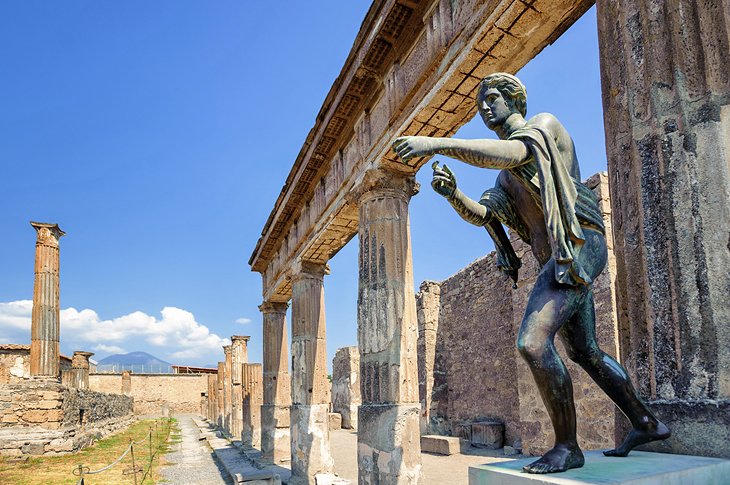
A visit to the National Archeological Museum in Naples will surely whet your appetite for seeing the city's almost more famous neighbor, Pompeii . Several centuries of excavations have uncovered homes, shops, temples, and public buildings of a prosperous city of 20,000 engulfed and frozen in time by the cataclysmic eruption of Vesuvius in AD 79.
An easy way to see this UNESCO World Heritage Site with an expert guide, and also hike to the summit of Mt. Vesuvius, is to take the Mt. Vesuvius and Pompeii Day Trip from Naples . The seven-hour tour includes a delicious Italian pizza lunch.
- Read More: Visiting Pompeii: Top Attractions, Tips & Tours
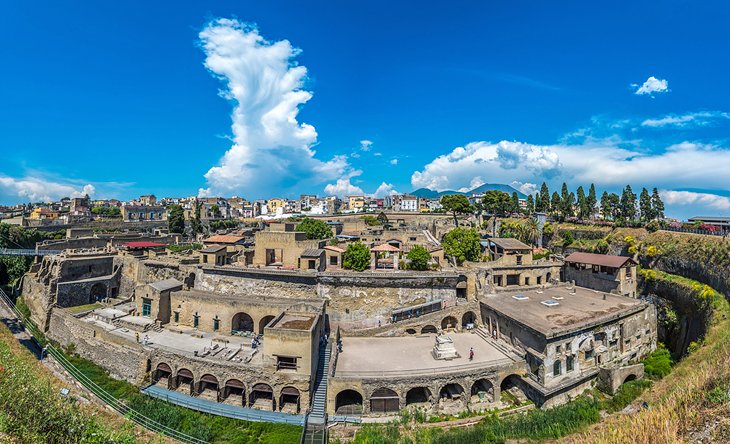
Unlike neighboring Pompeii, the Roman resort town of Herculaneum was engulfed by molten lava instead of ash in the AD 79 eruption of Mt. Vesuvius, and its buildings were supported by the lava as it rose in depth.
The difference had two results: organic materials were preserved in a dry airtight environment, and the cooled stone was so deep and hard that the site was protected from early plunder until modern techniques and sensibilities could preserve its treasures. What you see today gives an even more intimate view of Roman life than Pompeii.
You can visit both of these world-class attractions from Naples, on a Private Tour Day Trip Excursion to Herculaneum, Mt. Vesuvius, and Pompeii . Your expert guide will make sure you see the highlights of each archaeological site, and as an added bonus, you'll get to walk to the rim of the crater on Vesuvius.
- Read More: Visiting Herculaneum: Top Attractions, Tips & Tours
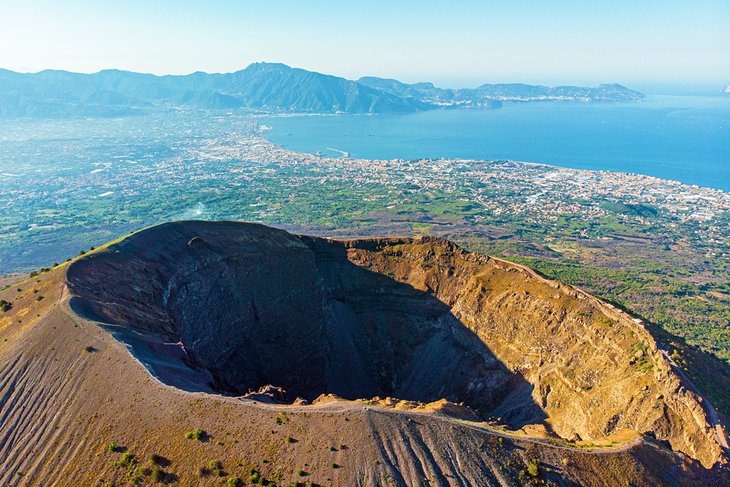
Rearing abruptly out of the plain, 15 kilometers southeast of Naples on the shores of the bay of Naples, Vesuvius is the only volcano on the European mainland that is still intermittently active. It is best known, of course, for the disastrous eruption in AD 79 that destroyed both Pompeii and Herculaneum. Its last major eruption was in 1944, and there have been signs of only mild activity since.
Drive or take a bus from Pompeii or Herculaneum to the Vesuvius National Park lot at about 1,000 meters altitude. Trails lead up the final 200 meters to the rim , which can be followed along its entire perimeter. As you would expect, the views are spectacular.
You can explore the volcano with a guide on the Vesuvius: Half Day Trip from Naples , a four-hour trip that includes hiking to the cone and learning about its history and geology.
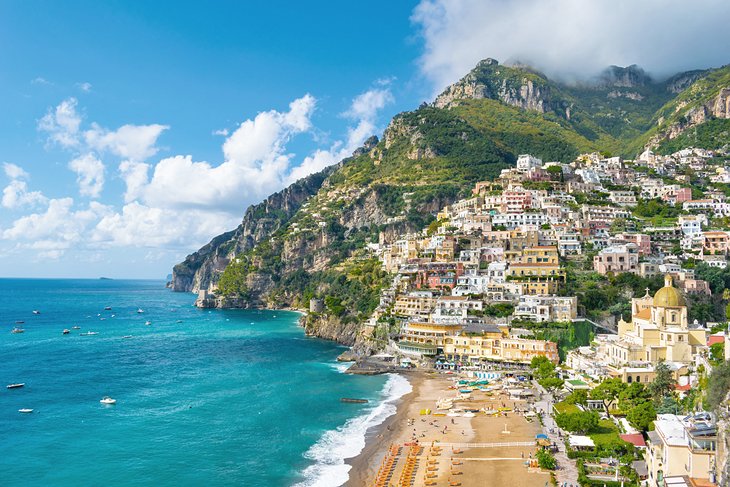
The southern coast of the Amalfi Peninsula, south of Naples, is among the most beautiful in all Europe, with colorful villages clinging to steep mountainsides that drop almost straight into the blue waters of the Mediterranean.
There are several ways to see this coast: by car, bus, boat, or organized tour. While of these a car gives you more freedom to stop and explore on your own (bus schedules make it difficult to spend any time in the towns), the road is narrow and demands 100 percent attention from the driver at all times.
The most flexible solution is the Private Tour: Sorrento, Positano, Amalfi, and Ravello Day Trip from Naples , where you can craft your own itinerary along this spectacular stretch of coast, with the help of your knowledgeable guide. You'll have plenty of time to explore some of the region's most charming towns in the comfort of a private chauffeur-driven car. Hotel pickup and drop-off are included.
- Read More: Exploring the Top Attractions of the Amalfi Coast: A Visitor's Guide
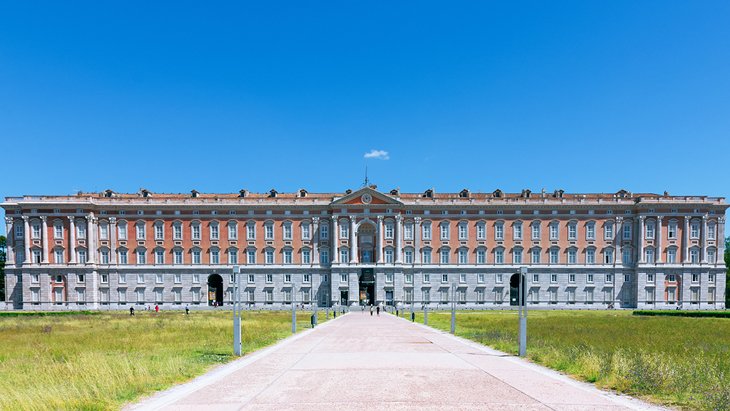
Opposite the station in Caserta is the former Royal Palace, a magnificent 1,200-room residence often compared to Versailles. It was built by Luigi Vanvitelli for King Charles III of Naples and Sicily, beginning in 1752, and today, its interior, well-preserved decoration, and furnishings form a museum of the Bourbon dynasty that ruled here from 1734 to 1860. Particularly fine are the Grand Staircase of 116 steps, the Cappella Reale, the Royal Apartments, and the theater.
In the Second World War, the Palace served as the headquarters of the Allied Middle East Command, and on April 29, 1945, the German armies in Italy signed the surrender document here. Behind it stretches a park with impressive fountains and the Grand Cascade. From the terrace beyond the English Garden, about a 45-minute walk north of the palace, are sweeping views.
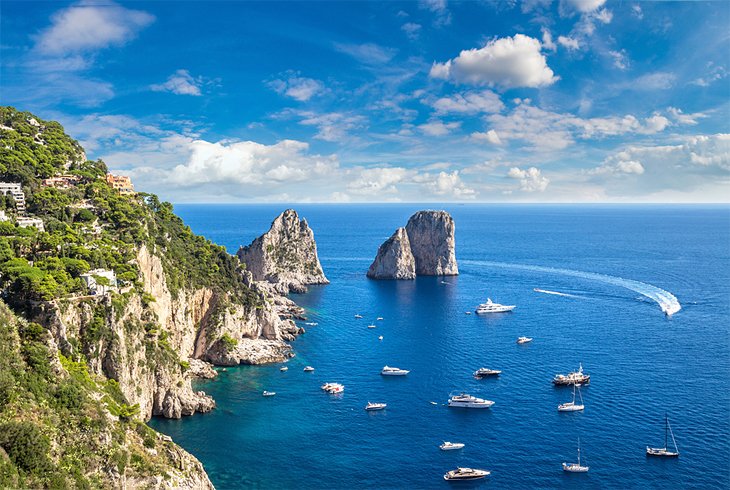
Regular ferries carry passengers from the Naples harbor across the bay to the island of Capri. It's a favorite day trip for locals, and the ferry from Naples is a good way for tourists who don't plan on visiting Sorrento to see this fabled island and its prime attraction, the Blue Grotto .
The full-day Capri and Blue Grotto Day Tour from Naples or Sorrento whisks you to this glamorous island via jetfoil. You'll see the striking azure water in the Blue Grotto, visit the beautiful towns of Anacapri and Capri, admire some of the island's fascinating rock formations, and explore the coastline by minibus.
- Read More: Top-Rated Tourist Attractions in Capri
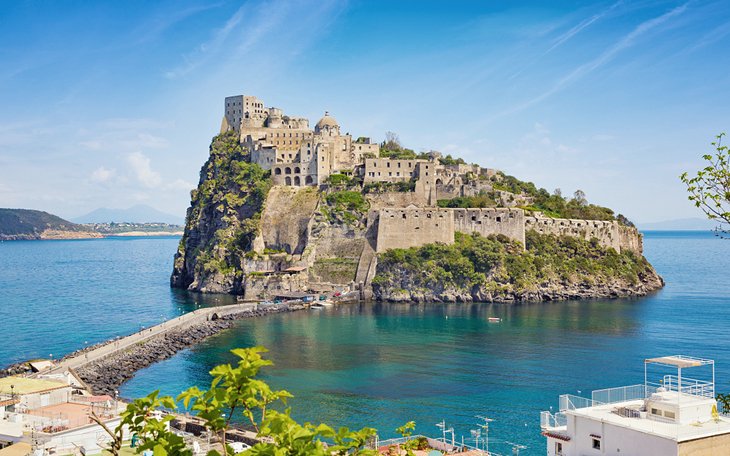
At the entrance to the Bay of Naples, the volcanic island of Ischia was known to the ancient Greeks and Romans, who were attracted by its hot springs and the luxuriant flora. Today, it's less crowded with day trippers than nearby smaller Capri, and has much nicer beaches.
The town of Ischia, on the northeast coast, is made up of Ischia Ponte, where the imposing Castello stands on a 91-meter rocky crag accessible by a stone causeway, and the busier spa and seaside resort of Ischia Porto. The island's oldest harbor here is a former crater lake.
From Forio, on the west coast, a beautiful road leads to the southern part of the island, past La Mortella , beautiful gardens created by Susana Walton and British composer Sir William Walton and well worth a stop. The southern shore is the quietest, where the village of Sant'Angelo sits picturesquely on the slopes of a promontory.
Frequent boats connect Ischia to Naples harbor and to the smaller island of Procida , almost too cute to be real, with its taffy-colored houses. Or you can go directly to Procida from Naples by hydrofoil on the Day Trip to Procida Island with Lunch tour, enjoying a full day on the island at your own pace, with lunch at a local restaurant.
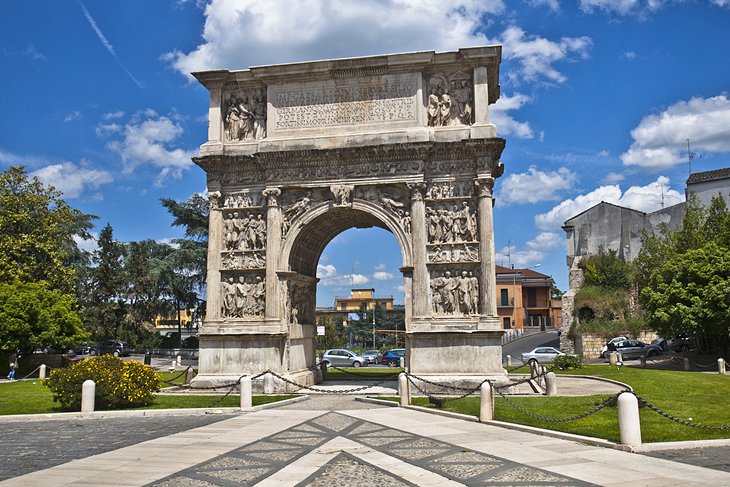
About 50 kilometers northeast of Naples, Benevento commands a beautiful setting on a flat-topped hill between two rivers, at the junction of the Via Appia with four other Roman roads. This position made it one of the most important towns in southern Italy, and for five centuries, it was the seat of powerful Lombard dukes.
It has a 14th-century castle and the remains of a Roman theater now used for opera performances, but its major tourist attraction is the magnificent Arco di Traiano (Arch of Trajan), also known as Porta Aurea, dedicated by the senate and people of Beneventum to the "best of princes" in AD 114, in anticipation of his return from the Parthian wars.
The arch, built of Greek marble, stands 15.5 meters high and is one of the finest of its kind. The entire arch, including the marble reliefs glorifying the emperor, is very well preserved.
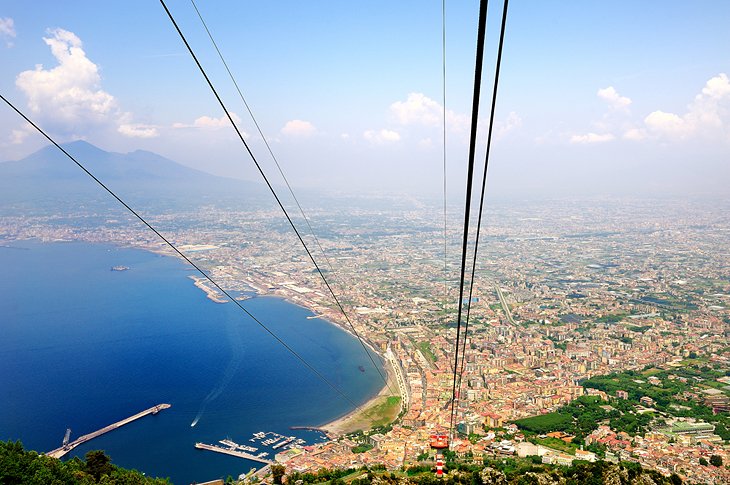
About 30 kilometers south of the city, on the Bay of Naples, Castellammare di Stabia is adjacent to the ancient city of Stabiae, destroyed by the AD 79 eruption of Vesuvius. You can visit the excavated Roman villas, which were very well preserved by the "rain" of volcanic ash that buried them. Frescoes and mosaics are intact, as is the swimming pool in its colonnaded atrium.
A cable car from the Castellammare Circumvesuviana station climbs Monte Faito, from whose summit there are walking trails and magnificent views of the Bay of Naples and Vesuvius.
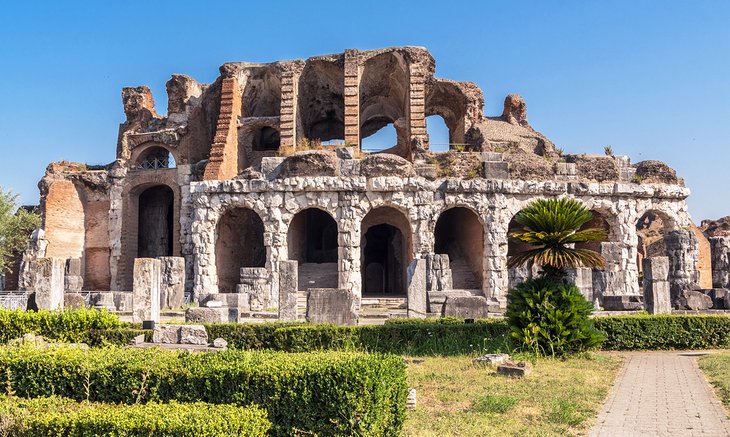
Modern Capua is built adjacent to the ancient city of Capua Vetere, destroyed in the ninth century. In the center of town, near the Volturno River, the cathedral's campanile and 11th-century forecourt with third-century columns survived after the building itself was destroyed in World War II. Nearby, the Campanian Provincial Museum is the region's most important archeological museum after the National Museum in Naples.
Outside of town is a Roman amphitheater, built under Augustus and restored by Hadrian, one of the largest remaining, with many of its subterranean passages intact. On the Via Appia , which connected the town to Rome, are two well-preserved Roman tombs.
More Related Articles on PlanetWare.com
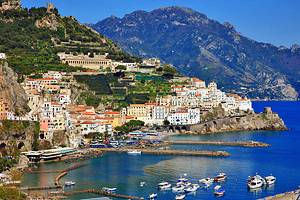
Where to Go near Naples: Surrounded by some of Italy's most popular places to visit, Naples makes a good starting point for seeing the tourist attractions in Sorrento and exploring the Amalfi Coast , as well as visiting Herculaneum and the dramatic ruins of Pompeii .
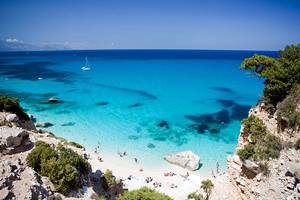
Exploring beyond Naples: South of the Amalfi Coast are the magnificent ruins of Paestum , the finest remains of Greek architecture on the Italian mainland. Or from Naples harbor, you can take a ferry to the fascinating island of Sardinia and its capital city of Cagliari .
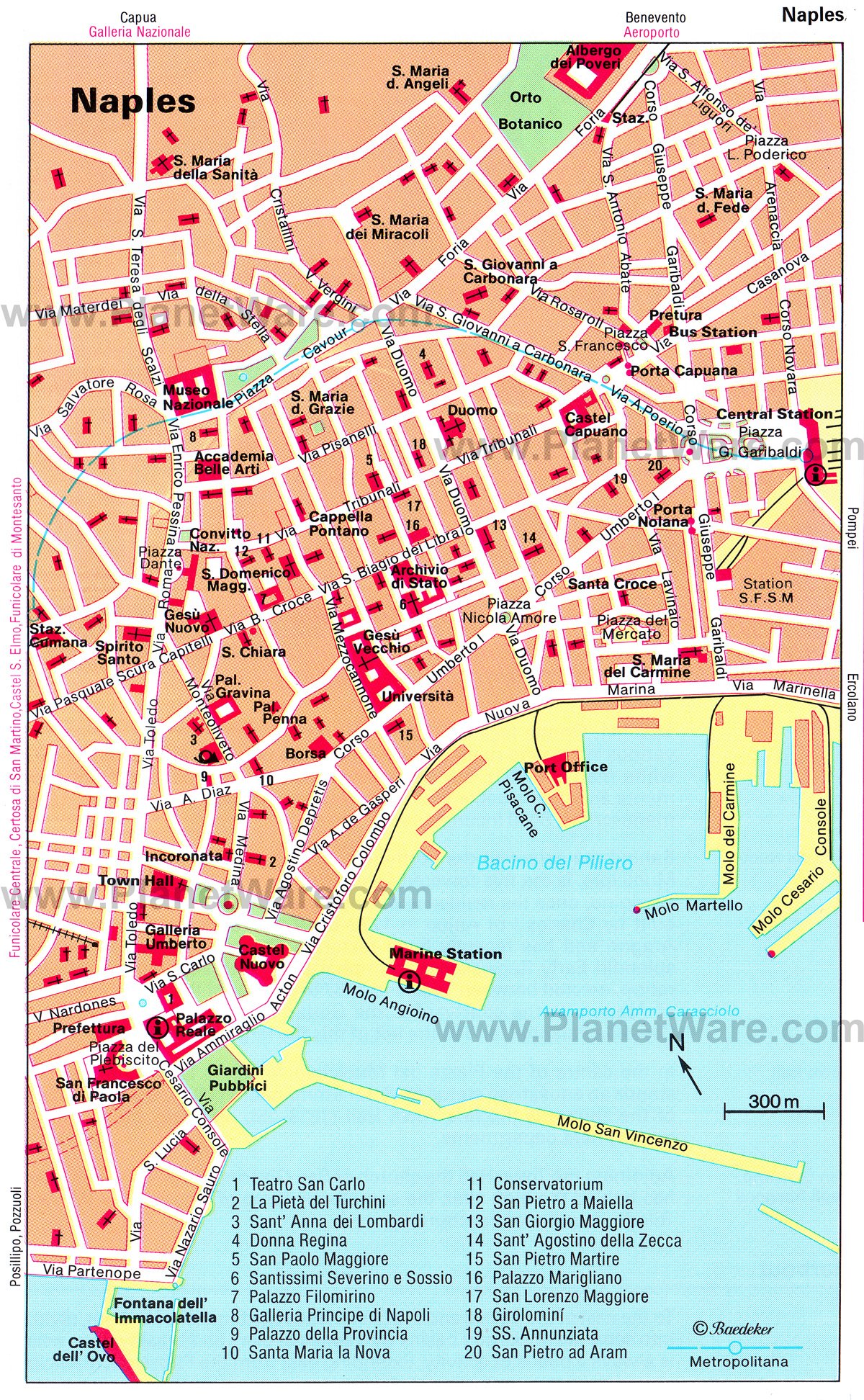
More on Italy


Home » Travel Guides » Italy » 15 Best Things to Do in Naples (Italy)
15 Best Things to Do in Naples (Italy)
Naples is a vast city located on the western coast of Italy facing the Tyrrhenian Sea. This colossal metropolis is the third largest city in Italy behind Rome and Milan with a population of 975,000 and a greater metropolitan population of over 3.1 million. Naples and the surrounding region has been inhabited since the Neolithic period and it has seen some form of continuous human activity through ancient Greek times to the Roman Empire and further.
Throughout history Naples has been the sight of fierce battles and many civilisations have vied to gain power here. Naples port is one of the most important in the Mediterranean and the city has one of the largest economies in Italy. Due to the extensive history of this region, Naples is full of historical buildings, squares and churches plus a host of modern amenities and fantastic nightlife opportunities. Looming in the shadow of the legendary Mt. Vesuvius, this is a truly epic tourist destination.
Lets explore the best things to do in Naples :
1. Climb Mount Vesuvius

Classified as a Stratovolcano, Mount Vesuvius dominates the skyline and landscape surrounding Naples and is a legendary volcano that famously erupted in 79 AD and caused the destruction and burial of Pompeii and Herculaneum.
Vesuvius stands as the only volcano in mainland Europe that has erupted in the last 100 years – It is considered extremely dangerous due to the amount of human settlements that are situated in its danger zone.
Today you can take a bus tour from Naples to visit this magnificent natural phenomenon and climb up its slopes to peer into the crater.
A hike will take between 20-30 minutes and is considered not too challenging – The views from the top on a clear day are simply fantastic and the caldera and crater are hugely interesting too.
Suggested tour : Vesuvius 4-Hour Wine Tasting Tour and Lunch from Naples
2. Visit the ruins of Pompeii

Pompeii was an ancient city that sat in the shadow of the iconic Mount Vesuvius.
This settlement was highly advanced and extensive and was destroyed at its peak during the devastating eruption of the volcano in 79 AD. Despite the devastation cause and the amount of lava that poured over the city, Pompeii stands today in a fantastic condition – This is due to the huge layer of ash that was deposited over the partial ruins and thus acted as a preserver.
Today you can visit Pompeii and walk through the extensive ruins – Particularly interesting sights include the Amphitheatre, the case del Fauno, the Temple of Apollo and the Temple of Jupiter.
Furthermore you can find plaster casts of many of the unfortunate victims who were buried under the ash and remain locked in their death pose for an eternity.
Recommended tour : Pompeii Ruins & Mount Vesuvius Day Tour
3. Naples National Archaeological Museum

Housed in a fine ornate building that was created in the 1750’s, the museum used to operate as a military and cavalry barracks and was turned into a museum in later years.
The museum is located to the north of the Harbor but there is a Metro station right next to the building.
Inside you can find an extensive collection that includes a wide array of Roman and Greek artefacts plus a selection of works from both Pompeii and Herculaneum.
This collection includes a selection of marble statues depicting scenes from ancient mythology, beautiful mosaics from the ruins of Pompeii, and a huge collection of objects from ancient Egypt such as mummified remains and death masks.
Anyone interested in ancient history and archaeology will find this museum an infinitely interesting place to visit.
4. San Gennaro Catacombs

Have you ever wanted to explore a secret underground world that holds a huge amount of detail and passageways? This is exactly what the San Gennaro Catacombs provide and you can find the entrance to this otherworldly place near the Basilica dell’Incoronata in northern part of Naples.
Once underground, you will find a network of tunnels and passageways that are lined with graves and crypts dating back to ancient history.
Spread over two levels, the lower floor contains a staggering 3000+ burials and is dimly lit to retain the spooky underground feeling.
The top level is more spacious but just as interesting and contains many detailed frescos and artwork.
A guided tour of the catacombs will provide a memorable experience and a true insight into the history of Naples.
5. Visit the ruins of Herculaneum

Another city that was devastated after the 79 AD eruption of Vesuvius was Herculaneum – This city is the lesser known counterpart to Pompeii but is just as interesting and a fantastic sight to visit.
Although the city was located further away from Vesuvius than Pompeii, it was still completely destroyed.
Herculaneum is actually considered to be a better preserved example than Pompeii and still has some of its wooden structures, frames and roofing intact.
Interesting sights within the complex include the Villa of the Papyri and the House of Argus which both contain beautiful frescos and wall paintings.
Furthermore there is also a series of skeletal remains that show the demise of this unfortunate group of people.
If you visit Pompeii, ensure that you visit Herculaneum too for a detailed insight into an ancient period of time.
6. Castel Nuovo

The Castel Nuovo stands out as a main feature in the skyline of Naples and is one of the first sights that people entering via cruise ships will see.
Located in close proximity to the famous Piazza del Plebiscito the castle is easily accessible and is one of the main historical sites in Naples.
Created in 1282, the castle features 5 circular crenulated towers and a fantastic triumphal arch that was added at a later date.
Take a tour of the castle and admire the beautiful towers, stand inside the central courtyard, admire the painted ceiling of the Baron’s Hall and climb the castle ramparts for stunning views of Naples and the harbour.
7. Cappella Sansevero

There is many chapels and churches in the heart of Naples, and the Sansevero Chapel is a truly fine example.
Created in 1590, the chapel was once a private building for the Duke of Torremaggoire and then served as a family burial chapel from 1613. Located in the centre of Naples, the chapel is not far from the Harbor and the Castel Nuovo.
Although this chapel is quite plain and unassuming from the outside, it is the interior that is quite spectacular and is the true highlight.
The chapel contains a huge amount of artwork and several famous sculptures.
A detailed and magnificent fresco adorns the ceiling and many marble statues stand guard at each of the pillars.
Central to this fantastic display is the beautiful statue of the Veiled Christ created by Giuseppe Sanmartino.
8. Castel dell’Ovo

As you enter the port at Naples you will undoubtedly see this stunning sea bound castle.
Once an island, the land that the castle stands on is now connected to the mainland and is accessible by a footpath and road.
As the oldest remaining fortification in Naples, the Castel dell’Ovo was constructed in the early 6th century BC and some form of defensive structure has stood ever since.
The castle is open to the public and it is a fantastic structure to explore – Walk through the passageways and arches and look out into the Mediterranean sea.
You can also find several exhibits of art and displays about the history of the castle.
9. Naples Harbour

Naples is a hugely busy port and sea trade is the city’s main source of economy.
The network of ports is divided into separate docks and is a true hive of activity at any time of the day.
Stretching from the Castel Nuovo to the Piazza San Giovanni Battista you could easily spend hours walking through the docks and ports and watching the intriguing business that occurs here.
Furthermore, if you continue to the west you will find the Porto di Mergellina which is full of trendy restaurants and cafes and has a great vibrant atmosphere.
Come here to sample some local life and admire the different yachts that dock at the harbour.
10. Piazza del Plebiscito

Undoubtedly the main square in Naples, the Piazza del Plebiscito features the Royal Palace and the Basilica Royal and is a truly fantastic place to visit.
This vast open space is filled with important buildings and statues and aside from the aforementioned structures, it also contains the Palazzo Salerno, the Prefecture Palace and a statue dedicated to Charles III of Spain.
The semi-circular colonnades of the Basilica Royal stretch out and frame the square beautifully.
Use this place as a starting point for your tour of Naples and be sure to visit the fine historical buildings that sit here.
11. San Domenico Maggiore

Another of the beautifully decorated churches in Naples, the Sam Domenico Maggiore was founded by Dominican Friars and was constructed in 1324. The church is located in the centre of the old town of Naples near the university and the Dante Metro stop.
Whilst the exterior of the structure is not particularly impressive, the interior is the real treat.
Full of renaissance artwork, sculptures and decoration, the church is hugely opulent – The panelled ceiling is gilded with gold and the high altar is also a stunning masterpiece.
Furthermore, there is also a “treasure chamber” that contains a plethora of religious artefacts, clothing, accessories and other trinkets.
12. Naples Cathedral

Dating as far back as the 13th century, the Cathedral of Duomo is a magnificent structure and stands as the main church in Naples and indeed in southern Italy.
Located on the Via Duomo, the cathedral is accessible via the Museo metro stop but also has a regular bus service that passes the front façade.
This religious building combines a myriad of styles including Gothic, Renaissance and Baroque – This is due to the restorations and changes that have been made since its creation.
Outside, the front façade features a large central tower and many ornate sculptures and stone work.
Inside, the main knave is framed by a series of huge columns and the decoration is simply beautiful.
Don’t forget to visit the immaculately decorated chapel of San Gennaro that features a finely decorated altar and two vessels containing the saints blood.
13. Explore the district of Santa Lucia

To truly experience Naples from a local perspective and soak up some culture, head to the district of Santa Lucia.
Located to the west of the Piazza del Plebiscito, this district has a myriad of narrow cobbled streets that wind down to the sea and offer an array of craft shops, restaurants, cafes and shops.
Here you can experience Neapolitan life at its best – Locals will walk through the streets going about their daily business, clothes hang out on washing lines and children play without a care in the world.
14. Palazzo Reale

This stunning Royal Palace holds the centre of attention in the Piazza del Plebiscito and sits opposite the Basilica Reale.
The front facade of this building features a symmetrical series of black framing, brown render and many windows to create an official and imposing look.
Furthermore at the base of the palace stands 12 detailed statues of past Kings of Naples from Roger of Sicily to Frederick II the Holy Roman Emperor.
Inside this lavish building is a stunning array of preserved rooms that are full of ornate decorations – The initial hallway and staircase is unbelievably opulent and the throne room and the state theatre are just as fantastic.
A tour of the interior and rooms is a must and will complete your visit of this wonderful historic building.
15. Take a boat to explore the island of Capri

Capri is a small inhabited island that is known for its dramatic scenery, rugged coastline dotted with beautiful caves and its quaint and charming Italian villages.
A boat trip from Naples harbour takes just under two hours and there are regular ferries that travel between the island and mainland, and neighbouring Sorrento.
Walk through the wonderful Marina Grande, admire the boats in the harbour and then set off to explore the island.
Don’t forget to take a trip to see the famous Blue Grotto Sea Cave or the view from the top of Monte Solaro.
Available tour : Island of Capri: Full-Day Tour from Naples
15 Best Things to Do in Naples (Italy):
- Climb Mount Vesuvius
- Visit the ruins of Pompeii
- Naples National Archaeological Museum
- San Gennaro Catacombs
- Visit the ruins of Herculaneum
- Castel Nuovo
- Cappella Sansevero
- Castel dell'Ovo
- Naples Harbour
- Piazza del Plebiscito
- San Domenico Maggiore
- Naples Cathedral
- Explore the district of Santa Lucia
- Palazzo Reale
- Take a boat to explore the island of Capri
Things to do in Naples Italy : attractions
Top 25 tourist attractions, sightseeing and what to do in naples italy.

Top 25 best things to do in Naples (Napoli), sightseeing and all must-see sights, tourist attractions and landmarks. What to do, the highlights and best places to visit in Naples Italy?
What to do in Naples Italy: Attractions & Sightseeing
What to see in Naples Italy? The city in the south of Italy initially exudes chaos in everything from filthy streets to the traffic, but beautiful museums and churches are often hidden behind the facades of the dilapidated buildings. You can easily spend several days to visit all the sights, because not only famous places such as Pompeï , Herculaneum and the Naples underground are worth seeing, but the city of Naples offers you much more than that. The city's history is so closely linked to the present, that unique landmarks can be found on several places in the city. On the list of ' Things to do in Naples ' there a lot of impressive churches that are unique in the world such as the Duomo and the Gesù Nuovo.
In addition, Naples is rich of museums , of which the themes vary widely. You have the national archaeological museum which is very famous, but also the beautiful museum of Capodimonte. In addition, the city has special places such as Cimitero delle Fontanelle, an old cemetery with skulls and the impressive Cappella Sansevero. The region of Naples is also worth a visit, where you can stroll around in small villages of the Amalfi Coast. Or visit islands such as Capri and Procida, which are located off the coast of Naples. Click on one of the highlights below for more information about the Naples tourist attractions and sightseeing . View our ' 25x What to do in Naples? ':
25x Best things to do in Naples
Popular activities in naples italy, where are the landmarks in naples.
Not all the highlights and landmarks of Italian Napoli are within walking distance of each other, so you have to rely on public transport for some tourist attractions. Where are the highlights, tourist attractions and places of interest in Naples? You can zoom in further on the attractions in this Italian city via the map with sights below:
FAQ Tourist Attractions Naples Italy
The main attractions around Naples are the archaeological areas of Pompeii and Herculaneum, which were made famous by the eruption of the adjacent Vesusvius volcano. In the city of Naples, the beautiful chapel Cappella Sansevero, the underground Naples of Napoli Sotterranea, the catacombs of San Gennaro and the archaeological museum are the most visited places of interest. In this article you can read all about the Top 25 of Naples attractions .
Only a short drive from Naples are the excavations of Pompeii and Herculaneum, but you can also choose to visit the Mount Vesuvius. South of the city is the beautiful Amalfi Coast with picturesque places like Sorrento and Positano. You can also easily visit beautiful islands such as Capri, Ischia and Procida by ferry. More info about these places of interest in the naples area .
Under the city of Naples is a vast expanse of caves, passageways and ancient catacombs. With a guided tour you can see the remains from the Roman era as well as from the 2nd World War. More info about Naples underground .
The most famous museum is the Archaeological Museum with many excavations from Pompeii and Herculaneum. In addition, the museum of Capodimonte and the museum of the Cappella Sansevero are frequently visited. In this article you can read all about the museums in Naples .

Partner of: Reykjavik attractions and Venice attractions
Most visited attractions
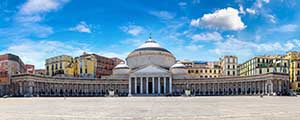
Top 25 Things to do in Naples
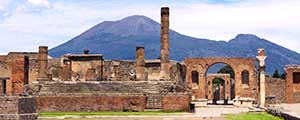
Pompeii: Tours & Tickets
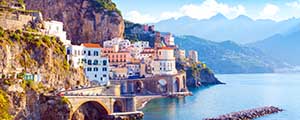
Day trips from Naples
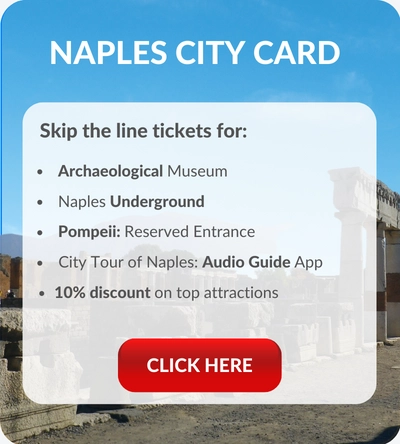

Naples is history, culture and nature : a beautiful, vibrant, full-of-life destination. Our travel guide contains up-to-date, personal information on everything from what to see , to when to visit , where to stay and what to eat !
- General information
- What to see
- Getting there
- Where to stay
- Where to eat
Why visit Naples?
A city of organized chaos with a legendary history, incredible architectural and cultural heritage, and beautiful natural landscapes , Naples is one of the most popular tourist destinations in Italy and the third biggest city after Rome and Milan . It's located in the south of the country, in a region called Campania.
Naples is steeped in history, and around every corner, you'll find impressive castles, churches and palaces with legendary stories to tell. Even if you don't visit inside the Castel dell'Ovo , the Duomo , the San Francesco di Paola Basilica or the Royal Palace of Naples , just wandering around the picturesque streets is enough to enchant any visitor.
It's not just Naples that's full of charm: the entire region is home to countless fascinating places to visit , making the city a great base for day trips to Pompeii , Capri , Amalfi , Sorrento , Positano , and Mount Vesuvius .
After all this sightseeing, you're bound to be hungry. What better way to finish off a day of exploring than indulging in typical Neapolitan cuisine at a traditional local restaurant ? This is, after all, the birthplace of pizza!
Where to start?
If you're planning a trip to Naples and you don't know much about the city yet, the first thing to do is to learn all about its legendary history - understanding the past will help you understand the present. Next, check out our practical hints and tips on traveling to the city before discovering which of its most important museums , monuments , and attractions interest you most.
Looking for a place to stay?
Booking your accommodation in advance is the best way to get great discounts. Our detailed guide on where to stay in Naples will help you decide which neighborhood you'd like to look for hotels or apartments in, and our hotel search engine will find you the best deals!
top activities
Day Trip to Pompeii 24th of August, year 79. A.D: the ground begins to tremble, the sky blackens and Vesuvius unleashes its wrath. Join us to r elive the history of Pompeii .
On this tour, we'll discover a hidden side of this city by venturing underground to discover the history of the tunnels that lie below the Spanish quarter .
Capri and Pompeii Day Trip Fall in love with the beauty of Capri and travel back in time at the archaeological UNESCO World Heritage Site of Pompeii on this tour of contrasts!
Naples Pizza Making Class Get your recipe notebooks ready and discover all the steps to making the star product of Italian food in this workshop in the home of pizza: Naples.
Free Walking Tour of Naples Old Town Legendary stories of Ancient Greeks and Romans await you on this free walking tour of Naples Old Town. Explore the city's most historic streets!
Naples Private Tour With this private walking tour of Naples , you'll enjoy an exclusive tour in English around the city center. The best way to discover the region's capital!
Pompeii & Vesuvius Day Trip Lava and ash petrified the citizens of Pompeii , leaving them frozen in time. Get to know it on this excursion which includes climbing the volcano itself .
Capri Boat Tour Don't leave Naples without having spent a day in Capri . Discover the island's beautiful surroundings by boat and explore it at your lesuire on foot.
Sorrento & Amalfi Coast Day Trip Discover Sorrento & the Amalfi Coast & allow yourself to be seduced by one of the most beautiful areas of the Mediterranean .
Herculaneum Tour Step back in time to Ancient Rome with this tour of the Herculaneum ruins . A unique trip to an archaeological UNESCO World Heritage Site!
Amalfi Coast Day Trip Cliff side houses and the most colourful scenery awaits in Positano, Amalfi and Ravello with this tour along the breathtaking Amalfi Coast.
Neapolitan Songs Concert at Napulitanata Attend a traditional Neapolitan music concert at the Napulitanata Theater and fall in love with the most iconic songs of Naples.
Naples Pass Discover Italy's third-largest city with this Naples Pass. Visit some of the most important museums in Naples and discounts for its best attractions.
Spanish District Street Art Tour Are you looking for unique plans in Naples? With this urban art tour you'll discover the many graffiti and colourful murals that decorate the streets of Naples.
Naples Pasta Workshop Are you passionate about Italian cuisine? Learn how to prepare a delicious dish of tagliatelle or stuffed ravioli, with this Naples Pasta Workshop.
Naples Sightseeing Bus Explore the stunning Italian city of Naples and its beautiful bay when you take this fantastic open-top sightseeing bus tour !
Basilica of San Lorenzo Underground Tour Discover Naples' fascinating past - explore the undergrounds of the Basilica of San Lorenzo Maggiore and visit Naples Cathedral !
Amalfi & Positano Boat Excursion Allow yourself to be seduced by the charm of Amalfi & Positano on this boat excursion. Two of the most beautiful towns on the Amalfi Coast await!
Combo: Naples, Pompeii & Mount Vesuvius Tour Visit the city's historic center, the Pompeii archaeological site, and Mount Vesuvius with our Combo: Naples, Pompeii & Mount Vesuvius tour.
Gulf of Naples Boat Tour Admire the incredible views along the Italian coastline on this boat tour of the Gulf of Naples ! You'll enjoy a pleasant crossing of the Tyrrhenian Sea .
Naples Food Market Tour The streets of Naples have so much to offer, with this walking tour you'll see the best of the city centre and visit a traditional food market .
Capri and Anacapri Day Trip On this excursion , you'll explore Capri , one of the most popular Italian islands to visit, and its most naturally beautiful town, Anacapri !
Tour of Naples & Pompeii This offer is ideal if you want to enjoy the best of Naples and Pompeii in one day . Taking both tours on the same day, you will save both time and money.
Discover the ancient city of Pompeii and explore the archaeological site of Herculaneum on this excursion from Naples and climb to the top of Mount Vesuvius !
Are you in Naples and want to explore the surrounding area? This excursion to Pompeii and the Amalfi Coast will take you to two of Campania's must-see places .
Pompeii and Sorrento Shore Excursion If you're arriving in Naples on a cruise and want to know the area, this tour of Sorrento and Pompeii is for you. History and beautiful views await you .
Naples Street Food Tour Enjoy the exquisite Italian cuisine in this gastronomy tour of Naples. You will taste the most delicious sweets and dishes of this captivating city.
Naples Legends & Folklore Free Tour Uncover the intriguing history behind the capital of Campania with us on this free Neopolitan legends and folklore tour .
Naples Castle Tour Discover the history of Borgo Marinari and the Castel Nuovo , two of the most symbolic monuments of the capital of Campania, with this Naples Castles Tour !
Ticket to Pompeii + Train Ride from Naples This activity includes tickets to Pompeii and round-trip train transportation from Naples , making it a hassle-free way for you to explore this historic gem.
Pompeii and Sorrento Day Trip Decipher the enigmas hidden in the ruins of Pompeii with this excursion which also takes you along the seductive Sorrento coast.
Naples, Pompeii & Sorento Tour Explore the captivating trio of Naples, Pompeii, and Sorrento . Immerse yourself in the rich history , breathtaking viewpoints, and iconic landmarks of Campania.
Naples Mysteries and Legends Tour Discover the mysteries and legends of Naples with this magical tour of the city's secret side. Goblins, fairies, amazing miracles and more await you!
Naples Guided Tour A charming blend of curious history, beautiful art and delicious cuisine... Get to know the capital of Campania with this Naples Guided Tour.
Train and Ticket to the Royal Palace of Caserta Visit one of the largest palace complexes in Europe with this ticket to the Royal Palace of Caserta with round-trip train tickets from Naples included !
Mount Vesuvius Day Trip Climb to the peak of Mount Vesuvius and enjoy the stunning panoramic views of the Neopolitan bay offered by the summit of this volcano.
Visit one of the most outstanding archaeological sites in Italy & walk around the volcano that buried it on this excursion to Vesuvius and Herculaneum .
Private Tour of the Capodimonte Museum Discover the Museo di Capodimonte - one of Naples' most important collections of artwork housed in an elegant former royal palace - on this private guided tour.
National Railway Museum of Pietrarsa On this guided tour of the Railway Museum of Pietrarsa , we'll learn about old locomotives and wagons, and visit a botanical garden.
Campania Pass With the Campania Pass , you'll have access to numerous museums and tourist attractions in the region and to public transportation.
Pompeii+ Mount Vesuvius Excursion On this excursion from Naples we'll visit the ruins of Pompeii and Mt. Vesuvius and enjoy a wine tasting. A day of history, gastronomy, and nature!
Archaeological Park of Paestum Ticket + Train Discover life in the Classical era with this ticket to the Archaeological Park of Paestum , one of the most important Greek sites in Italy.
Naples Electric Bike Tour Tour the capital of Campania in comfort and style! On this electric bike tour of Naples , you can choose the route you like the most!
Naples Tour for Cruise Ships If you're arriving in the Campania capital by sea , don't miss out on this walking tour of Naples and visit significant monuments that will captivate you!
Underground Naples Tour If you want to take a journey back in time in the heart of Naples , don't miss this interesting tour through the undergrounds of Piazza San Gaetano !
Chapel of the Treasure of San Gennaro Guided Tour Join us to discover the history of the patron saint of Naples on this guided tour of the Royal Chapel of the Treasure of San Gennaro !
Tour of the Naples National Archaeological Museum On this tour of the Naples National Archaeological Museum , we'll admire the mosaic of Issus, the sculptures of the Farnese collection, and much more!
Pedamentina Stairs Free Tour On this tour of the Pedamentina Stairs , we'll have the opportunity to learn an important part of the history of Naples and marvel at the breathtaking views.
Ischia Self Guided Tour This self guided tour of Ischia is the best way to discover the beautiful attractions of this island in the Gulf of Naples at your own pace.
Private Excursions from Naples Book one of our private excursions from Naples and explore some of the most fascinating locations in the south , such as Salerno, Caserta, Potenza or Avellino.
Naples National Archaeological Museum Private Tour Travel through history with exhibitions at the National Archaeological Museum in Naples. You'll see sculptures from the Roman Empire and objects from Pompeii.
Naples & Pompeii e-Bike Tour If you like sports & sustainable tourism, this electric bike tour of Naples and Pompeii is the best way to get to know the capital of Campania!
Royal Palace and Bourbon Tunnel Guided Tour Discover the oppulence and mystery of Naples with this fantastic guided tour of the Royal Palace of Naples and the enigmatic Bourbon tunnel.
Procida Island Boat Trip Discover the charming island of Procida on this boat trip from Naples . Plus, you'll enjoy a mouth-watering lunch of Italian delicacies!
Night of Opera in the Salotto Barbaja at the Medici Acquaviva Palace If you're after an unforgettable evening in Naples, this o pera concert in the Salotto Barbaja at the Medici Acquaviva Palace is perfect for you!
If you're in Naples, don't miss this boat excursion to Ischia and Procida, two of the most charming islands on the Amalfi Coast!
Free Walking Tour of Naples Let yourself be captivated by the historic city of Naples on this free walking tour. Discover ancient castles, picturesque piazzas and impressive churches.
Spaccanapoli + The Veiled Christ Tour Stroll down the old streets of Naples to admire the city's most famous sculptures on this tour of Spaccanapoli and the Veiled Christ !
Naples Maradona Tour Wander through the historic centre of the Italian city and follow in the footsteps of the famous Argentinian footballer on this Naples Maradona Tour.
Naples Christmas Market Tour Christmas has arrived in Campania! And there's no better way to enjoy it than on this Christmas tour of Naples . Are you ready?
Why is our Naples travel guide the best?
Introducing Naples is a city guide written by travellers for travellers , and contains personalised advice to help you make the most of your trip to the city on everything from what to see , to when to visit , where to stay and what to eat !
All the information in this guide is valid as of October 2022. If you find any errors or have any comments, please feel free to contact us.

Our travel guides
- top attractions
- where to stay
- and much more
Your browser is not supported for this experience. We recommend using Chrome, Firefox, Edge, or Safari.
Find Your Favorite Beach

Atlantic Coast

Beach Camping

Family-Friendly
Places to stay.

Campgrounds

Travel Ideas

Accessible Travel

Eco-Friendly Travel

African American Heritage Travel
More Travel Ideas
Popular links.

Florida Webcams

Toll Roads Info

Travel Guides

Pure Florida Naples Visitor Information Center
- 1200 5th Ave S, Ste 501 Naples, FL 34102
- (239) 263-4949
New Naples airport would take 15-20 years to open if decision made to move it. What to know
Will the Naples airport move?
A new Naples airport would take 15-20 years to come to fruition from the time a decision to move the current Naples Airport is made.
Whether a move from East Naples to East Collier – the only area with enough land – is feasible and where it might go are questions a study will answer. There's no guarantee the airport will be moved, ever, something airport officials want their customers, neighbors and the rest of Collier County to understand.
“Talking about relocating or just developing a new airport is a very complex, multidimensional issue,” Dave DiCarlo of Environmental Science Associates (ESA) told the Naples Airport Authority's Board of Commissioners in January.
It's not like the airport can grow outward: it is boxed in by development and preserve land.
Covering one square mile in East Naples, the airport is just west of Airport-Pulling Road. Residential homes run all along North Road beside the airport and along Davis Boulevard, on the other side of Airport-Pulling Road. Fifth Avenue South is less than a 10-minute drive west of the airport. The 140-acre Gordon River Greenway is just north and east of the airport and 15-acre Baker Park is just west – with a running, walking and biking path around the perimeter of the airport.
Planes come and go one after another all days most days, especially during tourist season. So much so, there's an observation deck on North Road, and the airport authority has plans for a remodel and update with a park and room for food trucks.
"There are people complaining about the noise over their heads," City Councilwoman Beth Petrunoff said in a phone interview in February. "I know the whole city feels like the noise is a big deal."
Petrunoff, who is the city council liaison to the airport, said the city council is "in lockstep" with the airport authority and thinks the study is a good idea. The Naples Airport Authority has an existing lease with the City of Naples through 2068.
"There is an explosion of growth in Collier County and is this where we want it to be," she asked. "On a personal level, I think it’s a very real likelihood the airport will move."
In June, airport authority commissioners approved a contract with ESA to conduct an Airport Exploratory Study. That contract came after Naples City Council asked the airport authority to look at a possible move following a $2 million noise study . In January, the Airport Authority board was given an update on the outline of the study. In April and May, the public is planned to be consulted. By June, study documents are expected to be presented.
But it's a long way from study documents to a new airport.
"We think it could be roughly 15-20 years from making the decision to build one to having a new operational airport," DiCarlo told the board.
Why is the study being conducted?
Noise complaints and growth constraints at the airport are behind the study.Since its start as a military airfield in 1943, the Naples Airport and the community around it have grown significantly.When Naples became a city in 1949 it had fewer than 1,000 residents . Today, there are more than 20,000 in the city limits and 419,500 in Collier County . U.S. News named Naples in the top 10 fastest growing places in the U.S.
Naples has grown up right next to the airport, which means there is nowhere else to grow, Naples Airport Authority Executive Director Chris Rozansky said in an interview in October when discussing the need for an exploratory study.
"We’re never going to grow in footprint any bigger than we are today," Rozansky said. "And we’re very constrained and we have a lot of demand, tremendous demand for hangar development and aeronautical business. We have a waiting list of 100 potential customers who we currently cannot accommodate."
Rozansky, who has been at the Naples Airport for eight years, was named Aviation Professional of the Year for 2023 by the Florida Department of Transportation.
On 732 acres, the airport served more than 200,000 passengers in 2023 and serviced 119,075 annual operations –takeoffs and landings. It was the 13th busiest U.S. airport for private jet flights in 2022, according to Private Jet Card Comparisons , citing data from Argus TraqPak. By comparison, the closest commercial airport – Southwest Florida International Airport – in Fort Myers served more than 10 million passengers in 2023 and saw 87,685 total operations.
Home to 360 aircraft, with a significant increase during seasonal months, Naples Airport had 122,281 takeoffs and landings in 2003, about the same as Southwest Florida International Airport (RSW) in Fort Myers, though RSW saw significantly more passengers with its commercial traffic.
Known as the runway of the rich and famous, Naples Airport caters to owned and chartered aircraft and their passengers – from jets that can come and go to Europe to prop planes taken on short trips.
Who is flying in and out?
Could be anyone. Naples is home to seven billionaires, according to Forbes 2023 list. Judge Judy has a plane at the Naples Airport. Billionaire and chairman of Berkshire Hathaway Warren Buffett; the CEO of Best Buy; former NFL players Terry Bradshaw and Howie Long; and actor Tom Cruise have been known to use the airport.
It's not just for the wealthy: medical flights, mosquito control and the Collier County Sheriff's Department fly out of the airport.
Most who fly live or own homes here. Of the more than 100,000 takeoffs and landings and more than 200,000 passengers served last year, Rozansky said, "we have surveyed these folks and nearly 80 percent are homeowners here in Naples and Collier County."
"Yes, there is some tourism, but the vast majority are invested in this community. They of course are very important stakeholders," he said. "It’s incredibly convenient for people who use the airport."
The airport is an important economic driver too, with an impact of $781 million in Fiscal Year 2023, up from $440 million reported in 2020 , according to annual Florida Statewide Aviation Economic Impact Studies. Naples airport doesn’t accept any tax dollars from the City of Naples, and it has no authority to tax. It is self-sufficient, running the airport from its own operations with a $49 million operations and capital budget in FY23.
In addition to the planes' comings and goings, Naples Airport offers fuel and fixed-based operator services such as hangaring, tie-down and parking, aircraft rental, aircraft maintenance and other services. Naples is one of 520 towered airports in the U.S., according to the FAA. It is administered by the FAA and staffed by contractor Robinson Aviation .
With those 100,000 airport operations come noise; noise that affects more and more people in Naples as the population grows. Despite knowing they are moving near an airport, complaints still come in. Demands that the airport be moved or closed are made to the airport authority and the city council.
Noise abatement measures
The Airport Authority has many abatement measures in place and plans for more.
A voluntary curfew between 10 p.m. and 7 a.m. for pilots and planes – voluntary because the Federal Aviation Administration (FAA) doesn't allow mandatory curfews. Violators are called out and compliers are celebrated at the airport. Signs and social media remind visitors of quiet hours. Even Naples Airport socks given in swag bags and for sale include a reminder of the hours.
In 2023, airport clients had a 98.7% compliance rate, according to the authority's annual report .
The noisiest classifications of jet aircraft are banned. No fuel service is allowed between 9:30 p.m. and 6:30 a.m., though self-service fueling is allowed anytime. There are preferred helicopter routes for arriving and departing helicopters over major roadways, away from residential areas.
This year, the airport authority has started deploying noise monitors in both public and private locations and is offering them to residents who want monitors set up at their homes or businesses.
Out of the 2019 Airport Noise Compatibility Study came noise abatement initiatives outlined in a report sent to the FAA in August that detail the airport's noise and the impact it has on the surrounding community. The airport authority received initial comments from the FAA in January, which it responded to, Zac Burch told The Naples Daily News. One of the authority's proposals was that it would conduct the airport move study.
What the study will and won't do
The study has three objectives:
- Document the projected Collier County growth and aviation needs over the next 50 years. Long-term outlook for Collier County that includes Demographics and Land Use Q Demand for General Aviation and Commercial Service Activity Q Airport Constraints
- New airport requirements: Define the general elements for a new airport site to establish the minimum acreage required
- Key factors for consideration: Document the critical elements and overall timeframe.
What the study won't do is recommend whether the airport should be moved; recommend a location; or include any alternative analysis, consultants told airport officials.
If airport commissioners decide to move forward with the idea of moving the airport, there will be three primary phases: initial planning phase, advanced planning with environmental, then acquisition and construction.
It sounds simple, but it's not. FAA regulators will get involved and need to give approvals. Environmental and conservation studies will be required. Land acquisitions will need to be made.
Even after choosing a favorite site, Naples Airport Authority wouldn't be able to just start buying land. It would need to prove to the FAA that it's the best site of any sites and that no other airport in the region could offer the services a new airport could. The FAA would conduct an airspace study, as well.
"The acquisition is one of the more challenging aspects of the process in terms of timeline," ESA's DiCarlo said.
Where is there land in Collier County?
Everyone agrees an airport would have to go east because there's not enough vacant land anywhere else in the county. ESA showed a land designation map without discussing specific properties.
What's at stake
Conservationists are concerned the airport authority might target Picayune Strand State Forest , which has 74,138 acres of protected land and is the fourth largest state forest in Florida.
Airport businesses and clients worry they'll lose their pristine location in the center of Naples. Will that mean that the money brought into the airport won't be spent in Naples?
Among the businesses operating at the Naples Airport are six rental car companies; flight schools, charter companies and specialty private aircraft companies that offer everything from transportation and food service, hangar rental, event space and more. These companies include Aviation Advisor , Elite Jets , Flex Jet , Jet 1 , Naples Jet Center and Northern Jet Management . Other businesses on site are Paradise Coast Property Team , aircraft detailers, and a pilot shop.
More: Naples Airport has lasted 80 years at the same spot: What to know about the airfield
More: Naples Airport Authority to study move to east Collier County
Nonprofits and government agencies also use space at the airport. Angel Flight , which coordinates free flights for organ transplant candidates, chemotherapy, clinical trials and more, and Humane Society Naples are among the agencies on site. Humane Society leases a parcel off Airport Pulling Road, which serves as the main shelter for all of Collier County and includes a fully equipped veterinary clinic.
Also on site are Civil Air Patrol, which runs flying clubs; Naples Museum of Military History ; and public services including Collier County MedFlight; Aircraft Rescue & Fire Fighting (ARFF)/City of Naples Fire Station No. 3, Collier County Sheriff’s Office Aviation Unit and Collier Mosquito Control District and U.S. Customs and Border Protection , which provides services for international flights Naples.
The airport authority has contractual obligations with tenants through 2053. It has state and federal obligations currently through 2042.
The businesses and the airport bring people to Naples who live here, spend money here, and are philanthropic. It also serves as a place for emergency services, pointed out Bruce Byerly, president of Naples Jet Center, during the Elite Jets event.
"It's something to celebrate," said Byerly, who is a pilot and so is his 18-year-old daughter. Byerly also served on the Naples Airport Authority Noise Compatibility Committee for several years.
"This airport is an integral and valuable part of this community. And it needs to continue to be an integral and valuable part of this community right here," said Berne Barton, who won a seat on the Naples City Council in the March 19 election – a recount on March 23 confirmed his victory. Barton was attending a private event in February held by tenant Elite Jets celebrating the 80th anniversary of the airport and serving as a platform for three political candidates.
"Is that the highest and best use of this property economically for this economic engine," Petrunoff said. She suggested the property could be great for a trauma center hospital or a cancer center to serve the community. Or should it remain "amenities for a select few?"
These are topics for the community, the airport authority and the City Council to consider, Petrunoff said.

IMAGES
VIDEO
COMMENTS
Naples is made of unique stories, stories you have to know, see and hear.We try to tell them, we try to enclose in our videos that Neapolitan essence in order to transmit it to as many people as possible.. We describe, the beauties, the colors, the sounds, the flavors of Naples, we condense them into short videos that can be a quick and fun way to learn something about this wonderful city and ...
Airone Hotel: a stay in the historical centre of Naples. In the heart of Naples, closed the historic city centre, there is Airone Hotel. A charming hotel that fascinates all the travellers who stay there. A precious jewel set among the oldest walls of the city surprising every day its visitors. The Airone Hotel expresses grace and elegance ...
The Tourist Guide offers great suggestions on places to go to and stay when visiting Naples. Accessible from any part of the world, The Naples Visitor Center is a convenient way to sift through all the stuff you need to know about Naples, Florida. Ease of access, peace of mind, and reliability all in the comfort of your own home or any place ...
The historic centre of Naples is the largest in Europe. It contains treasures and riches that earned it UNESCO World Heritage status in 1995. Let's discover it together! ... both for tradition and for tourist attraction, we certainly find Via Duomo, the place where the cathedral of Naples is located, Via San Gregorio Armeno, the now most famous ...
5. See the treasures of the Naples National Archaeological Museum. Built as a cavalry barracks in 1585, the Museo Archeologico Nazionale was established at the end of the 18th century by King Charles VII. The museum is best known for housing the many treasures that survived the 79 CE eruption of Mt Vesuvius, an event that devastated nearby Herculaneum and Pompeii.
One of Naples' most important tourist destinations, Via Toledo is a historic street dating back to 1536 and home many of the city's most iconic monuments. Piazza del Plebiscito An enormous public square in the centre of Naples, the Piazza del Plebiscito is home to many of the city's most emblematic buildings.
Roman Ruins and Medieval Fortifications: Scattered throughout Naples' historic centre are remnants of ancient civilizations. The Teatro di San Carlo, once an amphitheatre and now a renowned opera house, is a must-visit place if you are in Naples. The Castel dell'Ovo offers stunning views of the city.
A minor boundary modification was approved by the World Heritage Committee in 2011. This enlarged the component "Historic Centre of Naples" and merged and enlarged the components "District of Casale" and "District of Santo Strato", in order to include a non-developed and protected archaeological area. The property is vulnerable to ...
In listing the centre of Naples as a World Heritage Site in 1995, Unesco praised the city for having been, since the Middle Ages, a crucial centre for art and architecture expressed in its ancient fortresses, in its complexes such as the 1600s Royal Palace, in churches and palaces commissioned by aristocratic families. Historical sites.
Church of Gesù Nuovo. Gesù Nuovo is probably my famous church in Naples, and you'll find it as you come into the official historic centre of the city. From the outside, it's not clear what the building is, because the facade is actually from the 15 th century palace.
Centro Storico - a UNESCO World Heritage Site, Naples' historic centre is a vast area in the heart of the city where you will find the most famous landmarks ... BEST VISITOR PASSES FOR NAPLES AND CAMPANIA. There are several visitor passes for the city of Naples and the region of Campania in Italy. In general, they cover a period of one ...
The best time to visit Naples is in the late spring, before the summer crowds arrive, or the early fall when the hectic tourist season has come to a close, yet the weather is still sunny and warm. Though winter is less crowded, offering more opportunities to meet the locals, the weather can be rainy. The Christmas season is hectic in Naples ...
Every district of the historic centre of Naples has a unique soul, from the very central district of Montecalvario to that of San Giuseppe near the port of Naples, without forgetting the Avvocata district and the Pendino district, among the areas of Naples with the most churches. ... The heart of religious tourism in the area is the ...
Rough around the edges, the historical centre of Naples is a hodge-podge of narrow, cobbled streets. Apartment buildings are strung with a festoon of sheets and unruly scooters play cat and mouse with pedestrians, beeping with indignity when the crowds fail to part in prompt fashion. ... The one you are most likely to take as a tourist is the ...
No matter what time of year you plan to visit, here is a list of the top 10 things to do in Naples. 10. Galleria Umberto e Saint Carlo theatre. Galleria Umberto I is a public shopping gallery in Naples. It is located directly across from the San Carlo opera house. The San Carlo is the oldest continuously active venue for public opera in the ...
Piazza del Plebiscito is the center of modern Naples, just south of the historic centre and only 5 minutes' walk from the cruise/ferry terminal. San Francesco di Paola, on the piazza, is a huge domed church. Palazzo Reale, the Royal Palace, is across the square. ... Aimed squarely at the visitor to Naples this pass combines public transport in ...
Benevento and the Arch of Trajan. Castellammare di Stabia. Capua. Map of Tourist Attractions in Naples & Easy Day Trips. Naples, Italy - Climate Chart. 1. Castel Ovo and the Lungomare. Castel Ovo. Along the waterfront, at the historic gateway to the Mediterranean and the world, you can get a feel for this vibrant city.
Naples is a vast city located on the western coast of Italy facing the Tyrrhenian Sea. This colossal metropolis is the third largest city in Italy behind Rome and Milan with a population of 975,000 and a greater metropolitan population of over 3.1 million. Naples and the surrounding region has been inhabited since the Neolithic period and it has seen some form of continuous human activity ...
25x Best things to do in Naples. 1. Must see: Pompeii. The excavations of the archaeological area of Pompeii are one of the most famous attractions of Naples and Italy. It was a place that was located near the volcano of Mount Vesuvius. In AD 79, the volcano erupted and covered the city with volcanic ash.
Why visit Naples? A city of organized chaos with a legendary history, incredible architectural and cultural heritage, and beautiful natural landscapes, Naples is one of the most popular tourist destinations in Italy and the third biggest city after Rome and Milan.It's located in the south of the country, in a region called Campania. Naples is steeped in history, and around every corner, you'll ...
1200 5th Ave S, Ste 501 Naples, FL 34102. (239) 263-4949. Visit Website. With locations in Naples and Fort Myers, the water attraction company offers sunset and specialty cruises as well as boat and Jet Ski rentals, fishing charters, jet boat trips, group events and educational field trips for schools and students.
A new Naples airport would take 15-20 years to come to fruition from the time a decision to move the current Naples Airport is made. Whether a move from East Naples to East Collier - the only ...
BH Group and Kolter Group Buy Beachfront condominium development site on Miracle Mile in Naples for $102.6M News provided by. BH Group Apr 17, 2024, 08:00 ET. Share this article. Share to X.